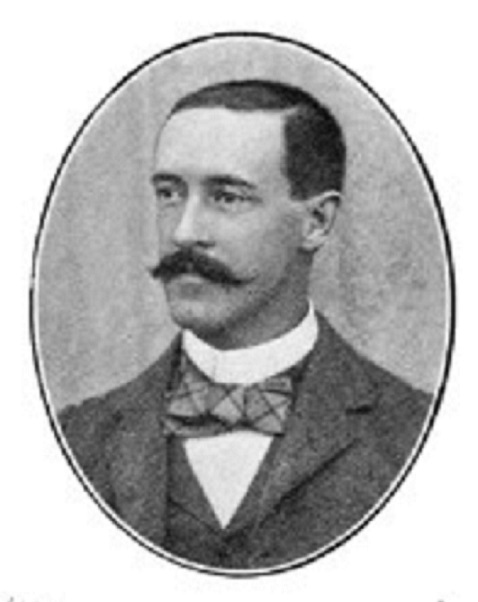9th Australian Field Ambulance
Private: 12059 Burton Disney RUTHERFOORD "RUTHERFORD"
Born: 1873. Bectine, Miatt, Ireland.
Died: 13th September 1934. 30 Thompson Street, Darlinghurst via East Sydney, New South Wales, Australia. Death Cert:11437/1934.
Father: John Rutherfoord. (1830-1908)
Mother: Laura Ellen Rutherfoord. nee: Booth. (1835-1877)
INFORMATION
Burton Disney Rutherford served with Lumsden's Horse service number 43 as a Trooper and was promoted to the rank of Veterinary Sergeant and was awarded the Queen's South Africa 1899-1902, 3 clasps, Cape Colony, Orange Free State, Johannesburg (Vet Serj B.D. Rutherford, Lumsdens Horse)
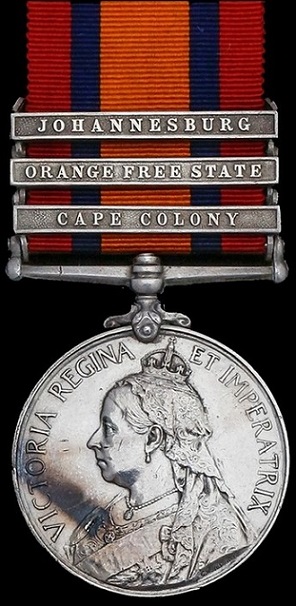
Burton served with the Behar Light Horse as a Trooper who was one of 54 men of the unit who served in the Boer War attached to Lumsden's Horse in 1900.

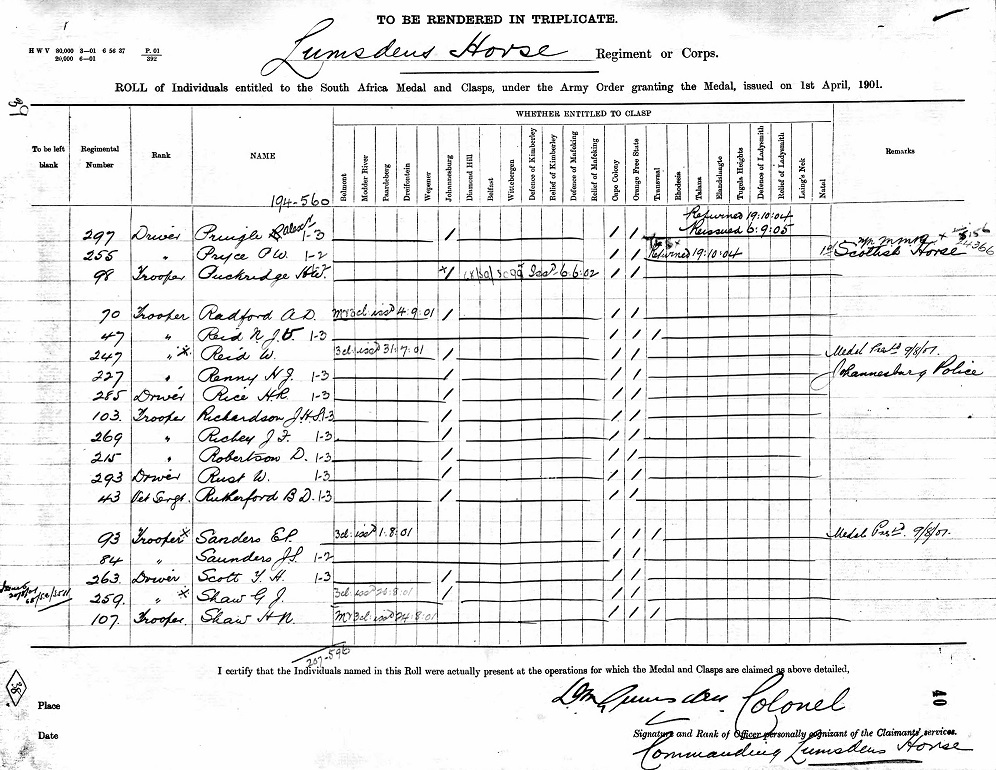
Queen South Africa Roll. Veterinary Sergeant: 43 Burton Disney Rutherford. Clasp. Johannesburg-Cape Colony- Orange Free State.
The ‘Atlantian,’ however, did not reach Bombay Harbour until 7 A.M. on December 31, with the following officers, non-commissioned officers, and men of Lumsden’s Horse on board:
Colonel Lumsden, Captain and Adjutant Taylor, Captain Beresford, Captain Noblett, Captain Holmes, Surgeon-Captain Powell. Staff—Regimental Sergeant-Major Hewitt, Regimental Quartermaster-Sergeant Dale, Staff-Sergeant Stephens, Farrier-Sergeant Marshall, Farrier-Sergeant Edwards, Pay-Sergeant Fraser, Orderly-Room Sergeant Graves, Sergeant Longman, Lance-Sergeant S.S. Cuthbert, Saddler Briggs, Privates Lowe, Lee, and Hayward. A Company—Company Sergeant-Major Mansfield, Company Quartermaster-Sergeant Booth, Sergeants Fox, Llewhellin, Stowell, Donald, and Rutherfoord, Corporal Macgillivray, Lance-Corporals Lemon and Godden, Privates E.S. Clifford, F.M. Clifford, C.H.M. Johnstone, Corbett, Dickens, Bradford, Cowen, Webbe, Kennedy, Courtenay, Zorab, Renny, Ritchie, Gordon, Atkinson, Watson, Brown, Henry, Allan, Aldis, John, Newton, Reid, Campbell, Bell, Macdonald, Haines, Smith, Hughes, Tancred, Bolst, Burnand, Dowd, and Palmer; Transport-Sergeant Power, Privates Lovegrove, Doyle, Manville, Paxton, Daly, and Scott; and Lance-Corporal Wheeler. B Company—Sergeant Conduit, Lance-Sergeant Warburton, Corporal Jackman, Privates Nicolay, Bagge, Innes, Williams, Nolan, Betts, Turner, Powis, Thelwall, Lytle, Spicer, Lungley, Winder, Dexter, Martin, Moorhouse, Maxwell, and Allardice; Transport-Sergeant Smith, Privates Rice, Crux, Meares, Rust, and Quartermaster-Sergeant Morris.
Before going on shore at Bombay, Colonel Lumsden received the following telegram from Sir Patrick Playfair, C.I.E., Chairman of the Calcutta Reception Committee:
The people of Calcutta bid you and your gallant corps welcome. They are proud of the way in which Lumsden’s Horse has represented India against Britain’s enemies. They wish to do you honour on arrival in Calcutta. You will be given a public reception, and the military bands will play you into your camp. It is proposed that your corps should take part in the Proclamation Parade on the morning of January 1, and then attend a special Divine Service at the Cathedral. His Excellency the Viceroy will entertain the corps at luncheon on Wednesday, January 2, and the reception committee are organising an evening party in the Town Hall for the night of the same day.
Burton Disney Rutherford enlisted with the 9th Australian Field Ambulance at Holdsworthy Army Camp on the 21st October 1915 and proceeded overseas for England on the 1st May 1916 0n b0ard HMAT A24 " " and disembarked at Plymouth England on the 9th July 1916. Burton was marched into camp and proceeded overseas for France via Southampton on the 23rd November 1916.

12059 PTE. B.D. RUTHERFORD 9 F. AMB. A.I.F.
Burton was admitted to hospital on the 21st December suffering from Influenza and was discharged to duty on the 26th and re joined his unit. On the 20th February 1917 Burton was Charged with the Offence of whilst in France on the 23rd December 1917. Conduct to the prejudice of good order and Military Discipline in that being awarded Fatigue Duty failed to appear for such Fatigue. Award 4 Days Forfeit Pay No:2 with Forfeiture of 7 Days by C.O.
The 9th Australian Field Ambulance supported the 9th Infantry Brigade in all theatres of the Great War.
7th June 1917.
THE BATTLE OF MESSINES
The 3rd Australian Divisions first major offensive was at Messines Ridge on the 7th June 1917. The Australian 3rd Division was a part of the II Anzac Corps which was allotted to the first assault. The 25th New Zealand, 3rd Australian Division with the 4th Australian Division in reserve. The 4th Division were battle hardened troops who had fought many major battles. The 3rd Australian Division were having problems getting to the "jump off" point. The day before the 9th and 10th Infantry Brigades were bombarded by German Gas-Shells around Hill 63 and Ploegsteert Wood. Many of the Aussies were not wearing gas masks, but despite this they pressed on even though they received 500 casualties.
The Battle for Messines Ridge during May-June 1917 saw 35 officers and 1,631 other ranks loose their lives.
9th Infantry Brigade Casualties.
| 33rd Battalion. AIF | 8 Officers | 382 Other ranks |
| 34th Battalion. AIF | 10 Officers | 378 Other ranks |
| 35th Battalion. AIF | 5 Officers | 431 Other ranks |
| 36th Battalion. AIF | 9 Officers | 421 Other ranks |
| 9th Machine Gun Company. AIF | 2 Officer | 17 Other ranks |
| 9th Light Trench Mortar Battery. | 1 Officer | 2 Other ranks |

FIELD DRESSING STATION, MESSINES 7th June 1917.
12th October 1917
THE BATTLE OF PASSCHENDAELE I
At 1:30 am rain showers began. By 2:30 am it was raining lightly but steadily, by 3:30 fairly heavily. the infantry moved through the pitch dark in single file. In some battalions each man held on to the equipment of the man ahead of him; if touch was broken, those in front had to come back. The news that the line as reported by the 66th division was not held only just reached the incoming troops. Accordingly, in the right brigade (9th) the leading Company Commanders Captain: Clarence Smith JEFFRIES. V.C. and Captain: Telford Graham GILDER M.C. both of the 34th Battalion stopped their men at the entrance to Broodseinde railway cutting, and themselves went to make sure that their column might not run into the enemy.
The Battle of Passchendaele saw 60 Officers and 1,322 other ranks loose their lives.
9th Infantry Brigade Casualties.
| 33rd Battalion. AIF | 11 Officers | 273 Other ranks |
| 34th Battalion. AIF | 15 Officers | 323 Other ranks |
| 35th Battalion. AIF | 18 Officers | 296 Other ranks |
| 36th Battalion. AIF | 15 Officers | 383 Other ranks |
| 9th Machine Gun Company. AIF | 1 Officer | 36 Other ranks |
| 9th Light Trench Mortar Battery. | - Officer | 11 Other ranks |
Burton was treated for an Ulcer on his Tongue at the 1st Australian Auxiliary Hospital and was discharged to England on Furlo and was marched in the the No:2 Command Depot at Weymouth before he returned to Australia on the 7th July 1918 where he was Discharged on the 3rd of August 1918 as Medically Unfit.
Family Information
Burton was initiated on the 18th September 1895 in the Lightin Tirhoot Lodge 1998 at Mazufferpore, Bengal and then on the 8th February 1898 in The True Blue Lodge at Motihari Bengal. Burton served during the Boer War Lumsden's Horse and the Behar Horse in India for 5 years. Burton noted that his next of kin was Lieutenant Colonel Rutherford DSO who served as Captain John Brownley Rutherfoord in South Africa with Behar Light Horse and Lumsden's Horse.
A unique Boer War D.S.O. group of three to Captain J. B. Rutherford, Behar Light Horse, late Lumsden's Horse
Distinguished Service Order, V.R., silver-gilt and enamel; Queen's South Africa 1899-1902, 3 clasps, Cape Colony, Orange Free State, Johannesburg (Capt. J. B. Rutherford, Lumsdens Horse); Volunteer Force Long Service, E.VII.R. (Captn: J. B. Rutherford, D.S.O., Behar Lt. Horse.), minor enamel damage and depression to D.S.O. centre, official corrections on the third, very fine (3)
A unique award to the Behar Light Horse for South Africa.
D.S.O. London Gazette 19 April 1901:
'In recognition of services during the operations in South Africa.'
John Brownley Rutherford was born in October 1864 and commissioned into the Behar Light Horse. He was one of 54 men of the unit who served in the Boer War attached to Lumsden's Horse in 1900. Following the announcement of his appointment to the Distinguished Service Order, he was invested with the insignia by the Lieutenant Governor of Begal in 1902. Rutherford is recorded as having died in India.
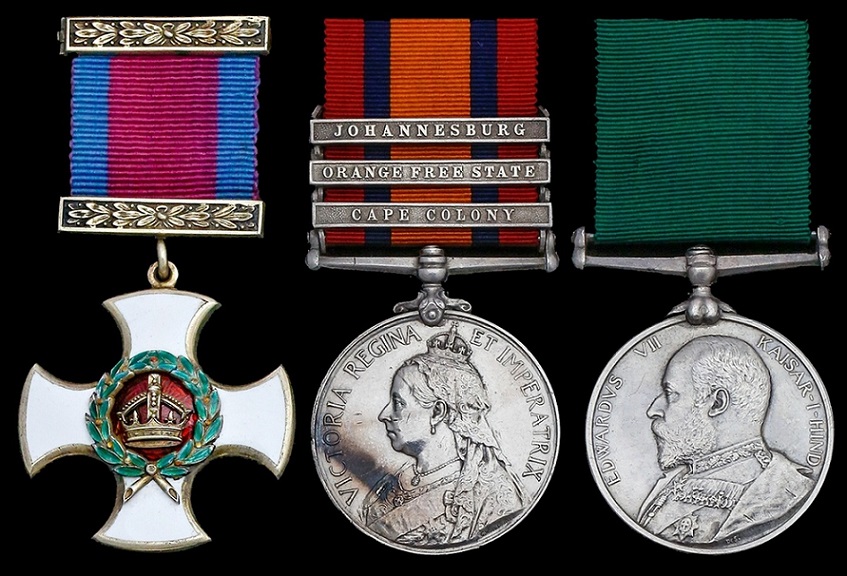
Distinguished Service Order, V.R., silver-gilt and enamel; Queen's South Africa 1899-1902, 3 clasps, Cape Colony, Orange Free State, Johannesburg (Capt. J. B. Rutherford, Lumsdens Horse); Volunteer Force Long Service, E.VII.R. (Captn: J. B. Rutherford, D.S.O., Behar Lt. Horse.),
LUMSDEN'S HORSE
On the evening of the 29thApril 1899 Colonel Ross received orders that the corps was to make a demonstration next morning at daylight on the right flank of the Boer lines for the purpose of drawing them from their position and enabling the 14th Brigade, under General Maxwell, which was to have come up on our right, to get behind and cut them off.
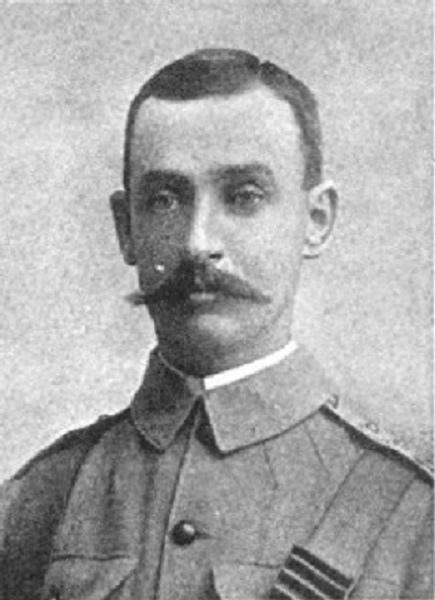
Captain: John Brownley Rutherfoord. DSO
The Mounted Infantry portion of General Tucker’s division, under Colonel Henry, joined hands with us at 5 A.M., half a mile from our camp. A portion of my corps was ordered to occupy Gun Kopje, a position 155believed to be held by the Boers, about four miles distant on our right front, the remainder extending and taking up positions on our left. I went forward with the right flank, Major Showers accompanying me. This portion consisted of the Adjutant, Captain Taylor, Captains Rutherfoord, Clifford, and Chamney, Lieutenants Sidey and Pugh, and four sections, the others having been detached by order of Colonel Ross to hold various points. Mr. Pugh was sent out in advance with the scouts, and it was when on this duty that Private Franks was shot. Mr. Pugh very pluckily assisted him in getting on his horse and endeavoured to take him out of the fire; but Franks was unable to stay on his horse, and, dropping to the ground, had to be left. Mr. Pugh and the remaining scouts were only just able to save themselves by galloping up and joining us on the kopje at the extreme right, to which we had just advanced, and which we held from 7 A.M. until ordered to retire at about 1 o’clock.
Early in the morning I ordered Corporal Chartres with eight men to occupy a kopje about 800 yards to our right and prevent the Boers turning our flank. There they held their ground until ordered to fall back. It was a small party for this important position, but in the circumstances no more could be spared, I having only about sixty men with me, twenty of whom, under Lieutenant Sidey, were detached by Colonel Ross to protect the Vickers-Maxim (commonly styled ‘pom-pom’) in the centre of the position.
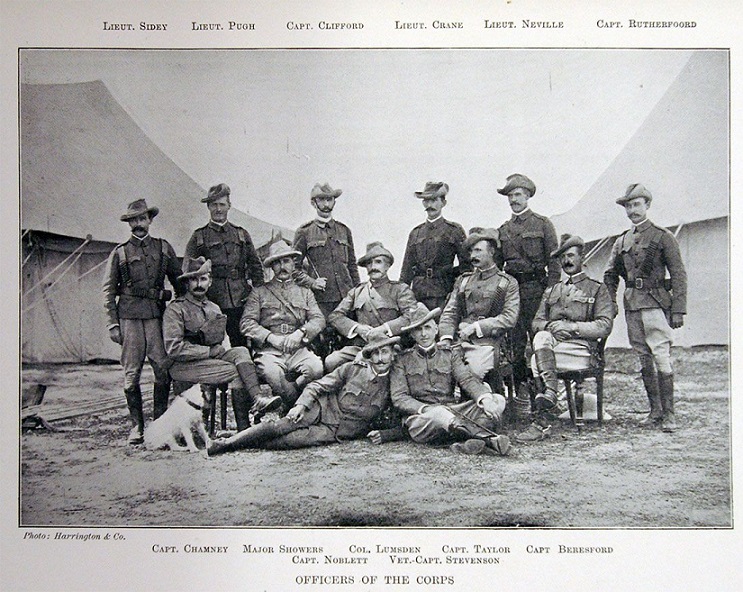
The following was then the general disposition:
There were four ridges diverging northerly towards the enemy. The extreme spur of the right ridge was held by myself with four sections Lumsden’s Horse as described; the second held by Lieutenant Crane and one section, he being directed there at the outset by Colonel Ross; the third and fourth by the rest of the brigade, the two pom-poms and our Maxim being at the head of the re-entrant between the second and third ridges, with Captain Noblett and three sections on its left.
Shortly after our arrival the Boers took up a position on a kopje about 1,500 yards directly in front, and quickly opened rifle fire on our position. Fortunately the men had time to ensconce themselves behind rocks, and, consequently, though bullets fell fast about them, they were able to maintain a steady fire on the enemy without exposing themselves. It was here, I deeply regret to say, that Major Showers met his death. He was at the extreme right of the firing line and under a hot flanking fire from the Boers, who had moved a party into a donga some 300 or 400 yards to their left.
I personally begged him not to expose himself, as also did Captains Chamney and Rutherfoord; but he would stand erect, using his field glasses and presenting a most conspicuous mark for the enemy’s fire, 156which resulted fatally to him shortly after noon, a Mauser bullet entering his right side half way down and coming out through his left arm above the elbow. In risking his own life he had drawn a heavy fire on the spot where he fell, and it was with much danger and difficulty that Captain Powell, with Captain Chamney and others, succeeded in removing him from the summit of the hill to a place of safety about thirty yards down. I should like to take this opportunity of adding a few words by way of tribute to the memory of Major Showers. When he heard of the corps being raised, he was in command of the Surma Valley Light Horse in Cachar, with the rank of Colonel, and was looked upon as one of the smartest commanders of Volunteer Cavalry in India. He wrote me and said, ‘If you will take me as your second in command, I will gladly forfeit my rank and come as Major.’ I may have made many fortunate selections in choosing my officers, but I never made a wiser one than in selecting Colonel Showers. A better or a braver man never breathed, and his loss to me so early in the campaign was irreparable.
Shortly after the commencement of the Boer attack the whole of the left were forced to retire owing to their flank being turned, taking one pom-pom and our Maxim with them. Captain Noblett was consequently obliged, at about 11 A.M., to conform to this movement, having no support, and took his men out of the shell fire with great difficulty but had only a few casualties.
Lieutenant Crane, receiving no orders to retire, and being detached from me and unable to communicate with me or I with him, deemed it his duty to retain his position as long as possible, which resulted in close fighting and the loss of nearly half his section.
While the Royal Engineer Company were busy blowing up the railway at this point, Captain Rutherfoord on the left, with our scouts, with his usual keenness soon came in touch with those of the enemy, and a brisk fire ensued on both sides, Captain Rutherfoord holding his position until I was able to reinforce him on his right flank. Colonel Ross soon hurried up further reinforcements on his left, which enabled us to hold the kopje and forced the enemy to fall back on the convoy they were covering. As night was approaching, pursuit with our tired horses was utterly hopeless, and we were ordered to move to our left and encamp at Germiston, which lay in the hollow behind us.
This, being the junction of railway lines that branch off in several directions, was the key of the Boer position. Our day’s movements had, however, been very successful, and Colonel Henry issued a brigade order next morning saying he had been congratulated by the Commander-in-Chief on the day’s work; while Colonel Ross was also congratulated on the prominent part taken by his corps, which resulted in the capture of fourteen engines and a large quantity of rolling-stock. This was very pleasant news to us, but the work was telling its tale on the horses, who 244were dead beat and fast tumbling to pieces from overwork and want of food. Our casualty was fortunately only one during the day—namely, Private J.D. Bewsher, who was shot through the knee while we were engaging the enemy opposite Boksburg.
Owing to the pace we had travelled and the hilly nature of the country, our Maxim gun under Captain Holmes, with its escort, had not come into camp when we retired to bed. The men, as on many previous occasions, had to turn in without food, and their horses were in the same plight.
After Pretoria had been taken A Company and Headquarters remained at Irene, and B Company went to Kalfontein, ten miles south on the line. The duties at both places were similar, in that they had to patrol the line and the neighbourhood. One of the Irene regular patrols was to Pretoria and back daily.
On one of the usual patrols into that town Captain Rutherfoord passed a German ambulance proceeding south, who explained that they had been 259allowed to do so, but carried no pass. Arriving at Pretoria, he reported the fact to the authorities, and also that he had stopped the ambulance until he could get orders concerning it. On inquiry, having ascertained that nothing was known about it, he obtained a letter to the Commandant at Irene, who was told to ascertain that the ambulance people were carrying no papers for the use of the enemy, and, if satisfied, to allow them to proceed. The Commandant, being a man of high ideals, did not see his way to thoroughly searching the ambulance, which contained four German nurses, in addition to the four doctors, and he therefore allowed them to pass on having taken the senior doctor’s word of honour that they had with them nothing of any use to the enemy in the way of papers. The ambulance then went on its way, but stopped the night at Kalfontein, ten miles beyond Irene. In the evening a wire came to us for an officer’s patrol to bring all those people back to Pretoria. Captain Rutherfoord was accordingly sent to Kalfontein for the purpose, and returned in the evening with the party.
Colonel Lumsden and all of us felt so sorry for the prisoners that we decided to ask them to dinner, which invitation being accepted, in due course we all sat down together in our little mess-house.
During our stay at Irene, as it was bitterly cold, we had run up a small hut: walls of piled-up stones, a tin roof, and a most cunningly contrived fireplace which did not smoke. We decorated the place with flowers, had a tip-top dinner, and drank crème de menthe as our only beverage. The dinner went off in the wonderful way dinners do. None of us could talk German, and none of them English, and yet we conversed freely and had the greatest fun. The show concluded with songs, and the last remembrance I have of it was that the Colonel and the prettiest ‘sister’ were taking down one another’s addresses and betting gloves about something in the quietest corner. Rutherfoord had been hiding as much as possible, as he felt himself to blame for being the cause of all their trouble, but we gave him away at the end, and though they all pretended to be very angry with him, we unanimously allowed that he had beaten all but the Colonel in winning the favours of the fair sex.
At about 2 A.M. we escorted them back to their caravan and said good-night, first of all pointing out that a sentry was posted over them, with orders to shoot at sight if anyone left the waggons during the night. They started for Pretoria at daybreak, but most of the officers were there to see them off, while one met them a few miles up the road. The Colonel was late for breakfast that morning. We heard afterwards that on arrival at Pretoria they were searched, and the result was that the doctors went to gaol, and the dear ladies were sent under supervision out of the country. We all, however, are quite certain that they were innocent victims of Boer duplicity.
Some officers of Lumsden’s Horse were in the Pretoria Club that night, but it was not they who gave away the countersign. Occasional visits to Pretoria in the vain hope of finding that some articles of luxury or much-needed outfit could be bought there became great events in the lives of both officers and men during their banishment to lines of communication. Somehow a goodly number of them, for whom sport was an irresistible attraction, managed to assemble 262on ground a mile outside the racecourse when three score of competitors started for the first military steeplechase ever ridden near Pretoria. After this event Colonel Lumsden wrote with pardonable pride:
Beharis will be pleased to hear that Captain Rutherfoord, of ours, won the first paper-chase in Pretoria. There were sixty starters over a stiff country, with the result that grief was plentiful.
Pretoria did not give itself away all at once to the temptations of a novel spectacle; but there were ladies in carriages among the little crowd of sightseers, and some stolid burghers looked on with approval, while others took part in the chase, for Boers have a bond of sympathy with us in love of horse-racing and field sports. The Commander-in-Chief came, sitting his shapely chestnut with a firmer and more workmanlike ease than half the horsemen present could boast of, and looking as if he could still show them all the way over a stiff hunting country. His appearance at the starting-point was a signal for marshalling the forces into line.
Then a Staff officer gave the word to go, and away went the motley field, more than half a hundred strong, spurring, 264hustling, charging like a Cavalry squadron for all they were worth. A light-weight, who served with distinction in Her Majesty’s Navy years ago, was quickest off, and led them over the two stone walls, closely followed by Captain Cox, of the New South Wales Lancers. Then came the second flight, riding for the walls knee to knee. Thanks to bold hearts and resolute riding, they all got over. A fall in that dense formation with another rank rushing close behind would have brought more than one rider to unutterable grief. But the ranks began to thin where a spruit had to be crossed, with steep banks into and out of the drift. There the ‘Skipper’s’ pony, with speed unchecked, gained a good lead, but he came down at the next made-up fence and gave his rider a nasty fall. The active light-weight, however, nipped into the saddle and went on cheery as ever. Then in clouds of dust, through which the fences could scarcely be seen, leggy horses and diminutive ponies rushed onward, jostling for a lead as before. Captain McNeil, of Montmorency’s Scouts, came down and broke his collar-bone, and Gibbs, of the Somerset Yeomanry, falling with his horse on top of him, had two ribs broken. But still ‘the chase went sweeping heedless by’ over a wide dug-out, with a hurdle to screen it and a trappy ditch where the road had to be crossed. Then they spread out to gallop over stony ground for the spruit, into which many floundered. The pace was beginning to tell on horses out of condition as they struggled up hill to go for a formidable bank of sandbags topped with loose earth that had been dug out of the ditch in front. Down-hill again to a hollow, where the little stream meandering between boggy ground had to be crossed three times. There several jaded steeds came to a standstill, having shot their bolts, and only a select few went up the next hill to the trappiest fence of all, where water flowed between deep banks. There the ‘Skipper’ got his third fall, but he mounted again and followed the leaders as they rounded the flag and rode for home. Captain Cox had also been left behind, and the running was taken up by Captain Rutherfoord, of Lumsden’s Horse, with Major Kenna, V.C., of the 21st Lancers, in close attendance. Flanks were heaving and pipes wheezing before the next boulder-strewn ridge had been crossed. ‘A run is nothing without music,’ said a subaltern as he roused his panting 265steed for another effort. He nearly blundered, as many others did, over the next little fence, and they were being left hopelessly behind. Kenna and Rutherfoord charged the last stone wall side by side, and rose together at it. Rutherfoord landed first, and had the race in hand, but, mistaking the post, eased his horse too soon. So Kenna, V.C., got a neck ahead in the straight run home, and thus won his right to claim the brush or whatever may be a substitute for it in paper-chasing. That was the official verdict, but Lumsden’s Horse still hold that their champion was first past the post.
One day a pleasant incident enlivened Colonel Lumsden’s ordinarily uneventful round of inspections. He had been visiting posts south of Irene, and was hurrying back to headquarters on an affair of urgent importance, when a train stopped at one of the sidings. Before he had time to realise that it was a special, or to make any inquiries, the train began to move again. So he jumped on to the nearest platform, and presently found himself in a corridor, cleaner and more carefully looked after than any he had seen on a Transvaal railway up to that time. Not knowing what to make of it, and half-expecting to meet an angry Chief of the Staff face to face, he refrained from exploring further. Presently a lady passed and said, ‘Won’t you come in?’ Colonel Lumsden was smoking at the time, and declined for that reason. ‘But mother wishes you to come,’ was the reply. So the gallant Colonel yielded with ready grace, and found himself in the presence of Lady Roberts, who, with her daughters, was on the way to Pretoria. They were just then nearing Irene, and Colonel Lumsden drew attention to the camp of his Indian Volunteers, in whom he thought Lady Roberts would naturally be much interested. To his surprise he saw a huge bonfire burning, and in silhouette against it were the words, ‘Welcome to Lady Roberts!’ Sergeant-Major Stephens had hit upon this happy idea, and put it into execution just at the right moment. One of the daughters, seeing it, said, ‘Oh, mother, there is a warm welcome for you, at any rate!’ Lady Roberts frequently referred to this impromptu welcome in conversation with Colonel Lumsden afterwards, and spoke appreciatively of the pleasure it had given her.
For nearly two months from the fall of Pretoria on June 5 to 26 July, 29th Lumsden’s Horse were scattered up and down the railway lines between Pretoria and Johannesburg.
Colonel Lumsden gives the following official account of this period in a letter to the executive committee of his corps:
The names of several other applicants are still before His Excellency, and I hope to advise you soon of their having received commissions also. At the same time I do not expect any of these will leave the corps until its disbandment. Young Maurice Clifford has been taken on by General Ian Hamilton as orderly, and is also likely to receive a commission, as well as Leslie Williams, son of the late popular Gwatkin Williams.
Captain Rutherfoord, Lieutenant Crane, and Sergeant Macnamara have been offered commissions in the Transvaal Mounted Police, and will probably remain in this country, as I believe will a good many others.
Captain Stevenson is likely to obtain an important veterinary appointment out here, and Dr. (Captain) Powell is also in the running for a high medical post should he prefer this to returning to India.
All the above, added to the continued requisitions for men of my corps for various offices, point to the esteem in which they are held by the authorities apart from their fighting qualities. In fact, were it not for strong remonstrances on my part to official requests, I should be in a fair way to lose a big percentage of my men before the work for which they came out has been completed.
In my previous letter I mentioned the sad plight to which our horses had been reduced, and that at the time of writing I doubted my ability to place ninety mounted men in the field fit for a two-days’ march. You will now be pleased to hear that in this respect things have improved, and that 269I can now mount 180 officers and men on fairly serviceable animals, few, however, remaining of our original Indian chargers. In this connection I may also mention that out of sixty Argentine remounts received at Kroonstad, only one is alive.
Now comes the important question of finance.
I have been spending various sums on comforts for the men, the largest item being 50l. for a much-needed supply of tobacco.
The men are very badly in want of clothes, especially breeches, tunics, and boots. I have indented on the Government Stores at Bloemfontein for a complete outfit, and hope to receive it shortly. This, of course, will be issued to us gratis. Nothing in the shape of clothing can be got for money.
I am enclosing a statement showing roughly the financial position of the corps. From this you will see that, provided the war is not prolonged beyond our present anticipations, there will be an ample balance left to admit of the payments estimated for in Calcutta.
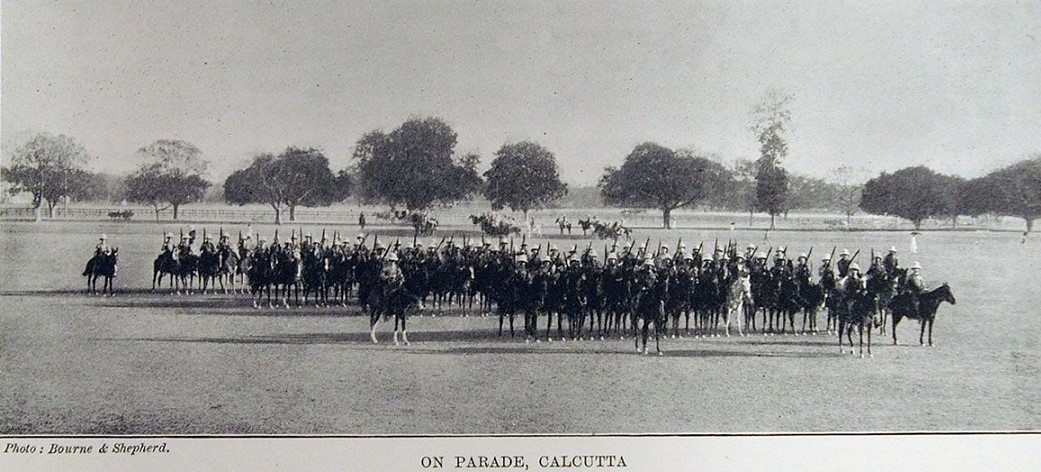
On January 4, 1901, just one year after they had assembled on the Maidan full of high hopes and noble aspirations, these Indian Volunteers, who had made for themselves a name that will long be honoured among British soldiers, were disbanded. So the curtain fell on the war scene in which the two hundred and fifty men known to history as Lumsden’s Horse played their parts. They had been in the field ten months, marched from camp to camp over 1,500 miles, fought in thirty-nine actions, lost seven men killed in action, two from enteric, several at various times incapacitated by wounds; they had left nearly sixty of their number in South Africa, some as administrators, some in the Regular Army, and some in the Police; they had brought back to Calcutta only four of the horses with which they started, and had used up 750 remounts. They had been twice mentioned in despatches by the Field-Marshal, and had been praised by every General under whom they served. Out of a total of fifteen officers, one, Colonel Lumsden, was decorated by Her Majesty Queen Victoria with the C.B.; another, Major Chamney, received the C.M.G.; two others, Captain Rutherfoord and Lieutenant Pugh, obtained the D.S.O.

The Adjutant and the two Regular officers who had commanded companies were promoted a step, to the rank of Brevet-Major. Trooper J.A. Graham, whose act of valour at Crocodile River has been recorded, received the Distinguished Conduct Medal; similar decorations were awarded to Corporal Percy Jones, Troopers P.C. Preston, H.N. Betts, W.E. Dexter, and Regimental Sergeant-Major Marsham; while seven other N.C.O.s and troopers were mentioned in despatches. It is a noteworthy 410fact that of all those whose names were brought forward by Colonel Lumsden not one failed to obtain recognition from the Commander-in-Chief, and only three received less honourable distinctions than their Colonel thought they were entitled to. All these things prove that nobody was recommended except for meritorious services of which clear and conclusive evidence could be given. All soldiers will appreciate what that means. And of twenty-three who obtained commissions in the Regular Army and others gazetted to Irregular corps, only two resigned subsequently. Colonel Lumsden was exceptionally fortunate in securing this number of commissions, and still more fortunate in selecting men worthy to retain them. It must not be forgotten, however, that the majority of those serving in the ranks of Lumsden’s Horse were Public School boys, some of whom may have failed in their examinations for Sandhurst, and gone out to fight their way in India as indigo, tea, and coffee planters, and who, when the occasion arose, were just the right men to fill the appointments they got. Their merits were recognised not only by our own military authorities, but also by the enemy. One Boer told the Rev. J.H. Siddons, of Great Berkhampstead, whose letter is quoted by permission, that Lumsden’s Horse were ‘exceptionally good both at scouting and shooting.’ The same authority also says that he had similar testimony to their merits from a corporal of one of the Cavalry regiments. This is not surprising, as Lumsden’s Horse and their comrades of the Line were always on good terms, and had a mutual admiration for each other. In a letter to the Colonel, Trooper D. Morison says:
I am afraid I cannot help you much with my personal experiences and views. No doubt everyone who writes you on the subject will be full of praise and admiration for Mr. Thomas Atkins as we found him on the veldt. But I should like to record what a splendid chap he is. Whether Scotch, Irish, Welsh, or from any other part of the country, he is all the same when it comes to a tight corner.
Decorations
Colonel D.M. Lumsden, Assam Valley Light Horse C.B.
Major H. Chamney, Surma Valley Light Horse.
Captain J.B. Rutherfoord, Behar Light Horse D.S.O.
Lieutenant H.O. Pugh, Calcutta Light Horse D.S.O.
Following are the recommendations made by Lieutenant-Colonel Lumsden, late commanding Lumsden’s Horse, in bringing the names of the undermentioned officers and men to the favourable notice of Field-Marshal Lord Roberts, the Commander-in-Chief, as having done special and meritorious work during the service of his corps in South Africa. The promotions or honours given subsequently are placed within parentheses.
Previous to the date of these recommendations, Major Chamney had been gazetted a Companion of St. Michael and St. George, while Captain Rutherfoord and Lieutenant Pugh had received the decoration of the Distinguished Service Order.
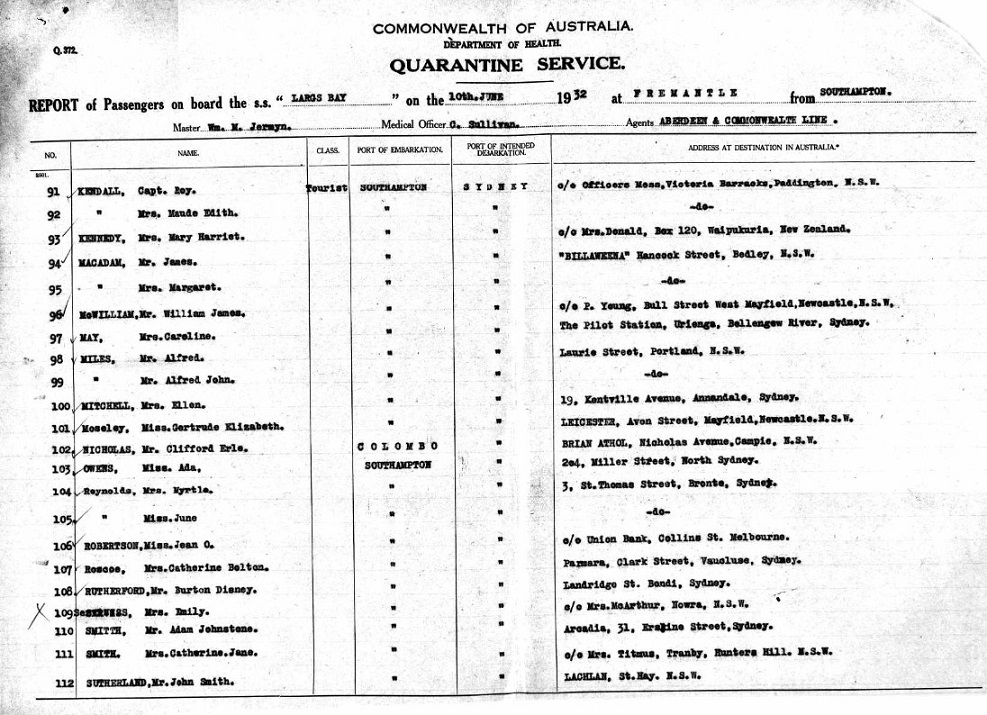
Passenger List: S.S. Largs Bay from Southampton to Fremantle, Australia 10th June 1932.
Burton made a last trip back to England and departed Southampton, United Kingdom on the 11th May 1932 on board the "Largs Bay" bound for Australia and arrived in Fremantle, Western Australia on the on the 10th June. Burton gave his residential address as Landridge Street, Bondi via Sydney, New South Wales.
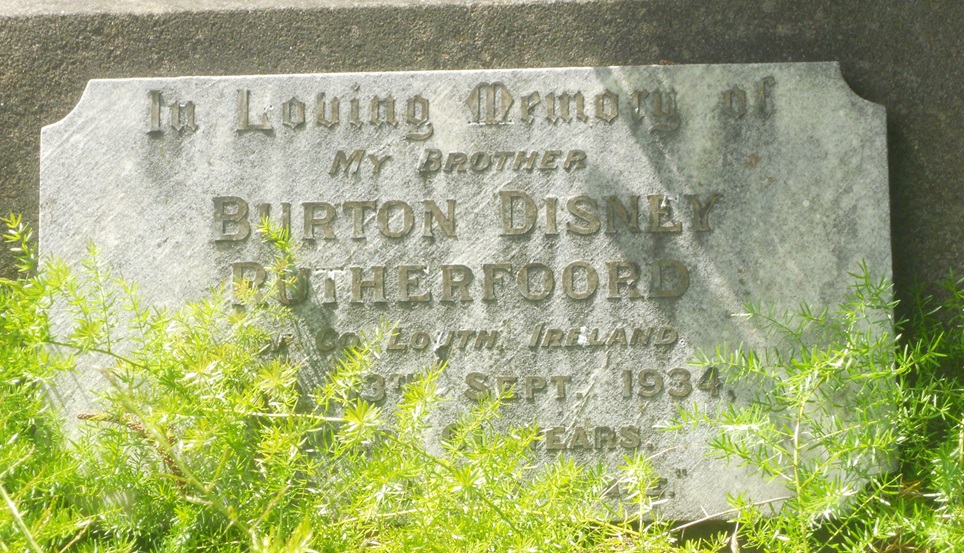
Burton was buried on the 15th September 1934 at the Rookwood Cemetery, New South Wales, Australia, Anglican Section 14, Grave 911.
IRINGA CEMETERY, South Africa.
At the outbreak of the First World War Tanzania was the core of German East Africa. From the invasion of April 1915, Commonwealth forces fought a protracted and difficult campaign against a relatively small but highly skilled German force under the command of General von Lettow-Vorbeck. When the Germans finally surrendered on 23 November 1918, twelve days after the European armistice, their numbers had been reduced to 155 European and 1,168 African troops. Iringa was captured in September 1916 and an officers' hospital was posted in the town. Twelve burials were made in Iringa Cemetery from May 1916, to December 1917, and after the Armistice 135 graves were brought in from other burial grounds. Iringa Cemetery now contains 131 Commonwealth burials of the First World War and one from the Second World War. The Commission also cares for 16 German war burials within the cemetery.
RUTHERFOORD, Lieutenant, ARTHUR HENRY, 1st. Rhodesia Native Regiment. 23rd July 1917. Age 27. Son of Ellen Rutherfoord, of Alma House, Collingham Bridge, Leeds, England, and the late John Brownley Rutherfoord. II. A. 4.
Military Records
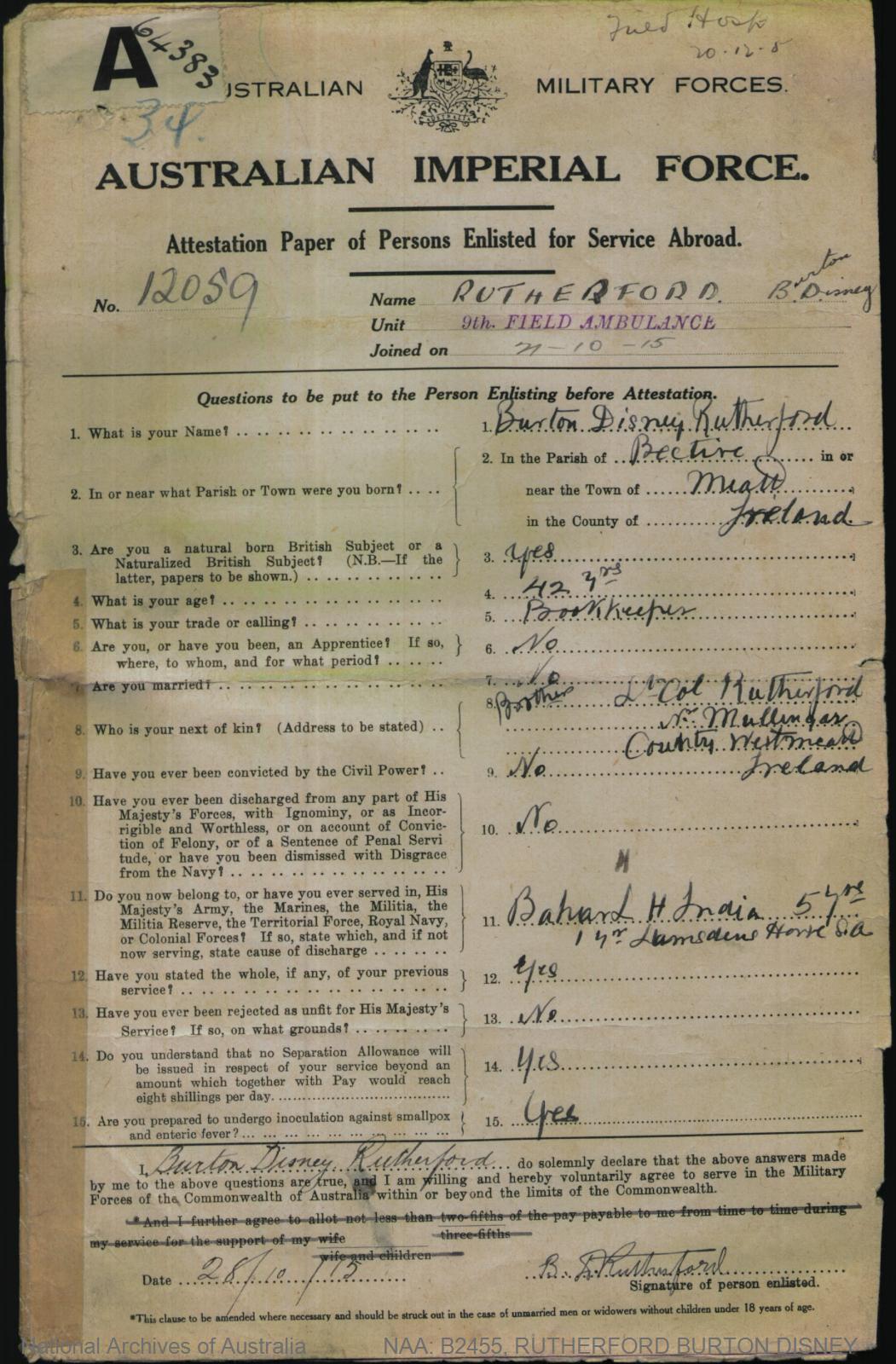

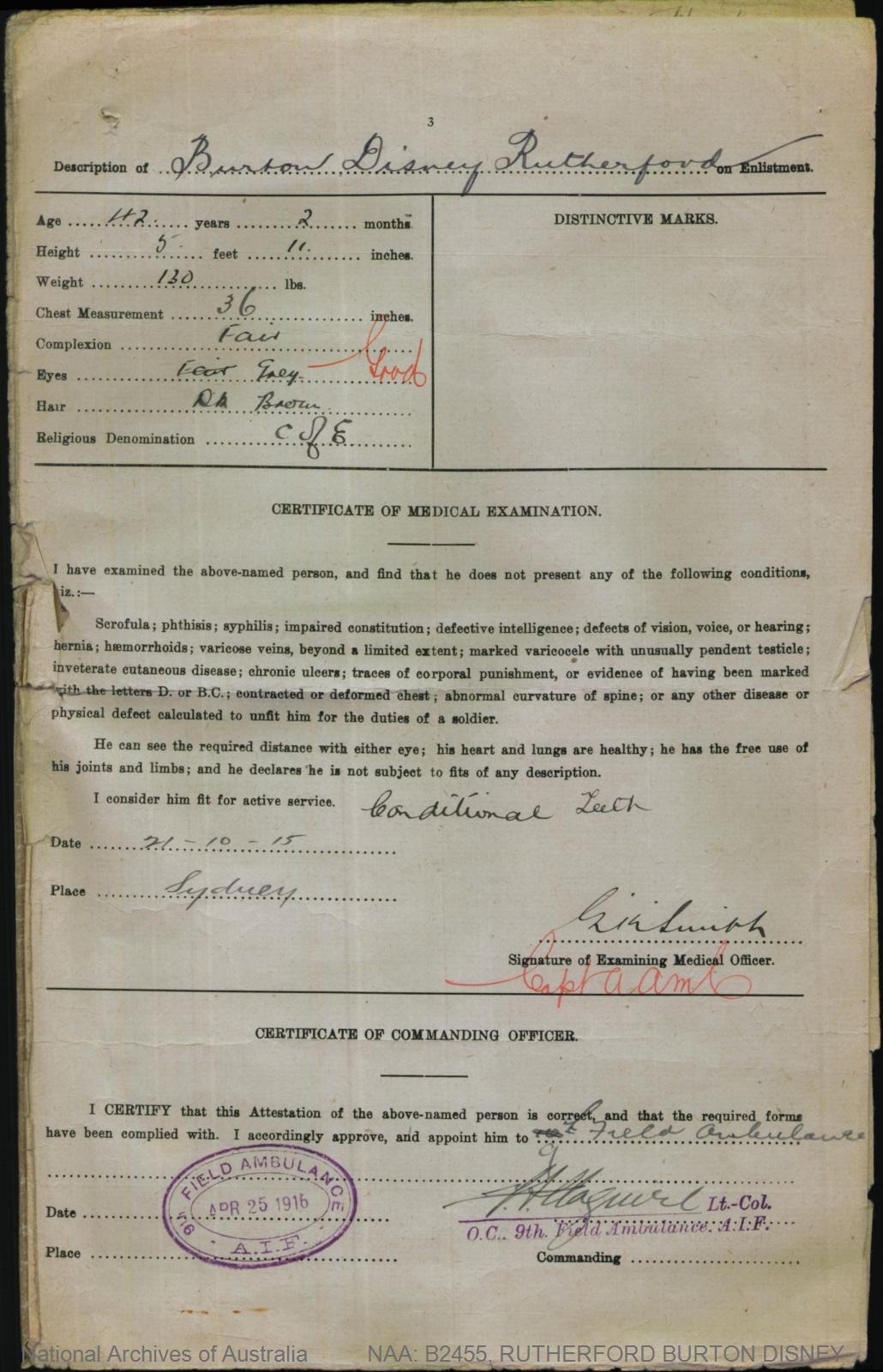
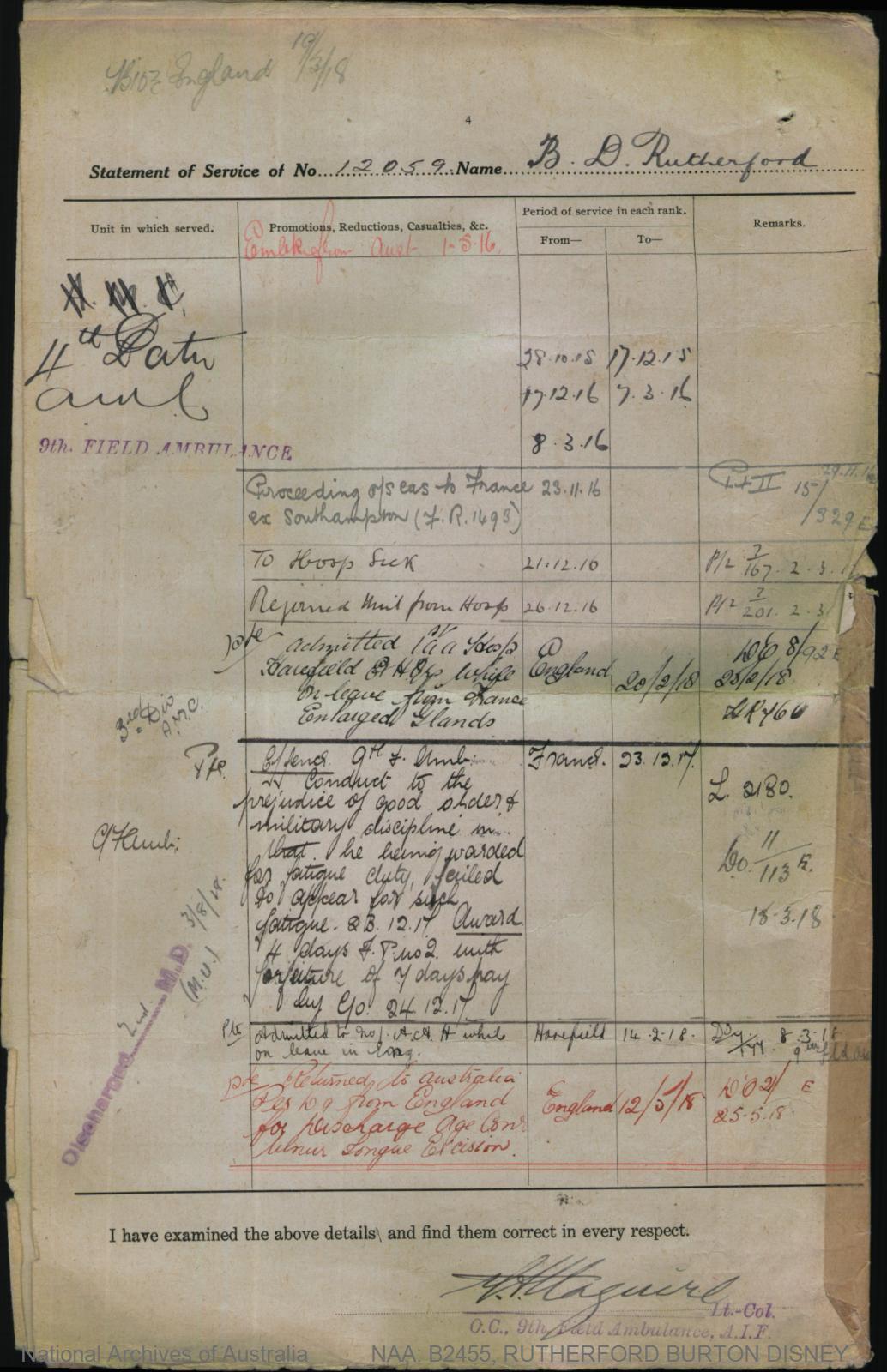
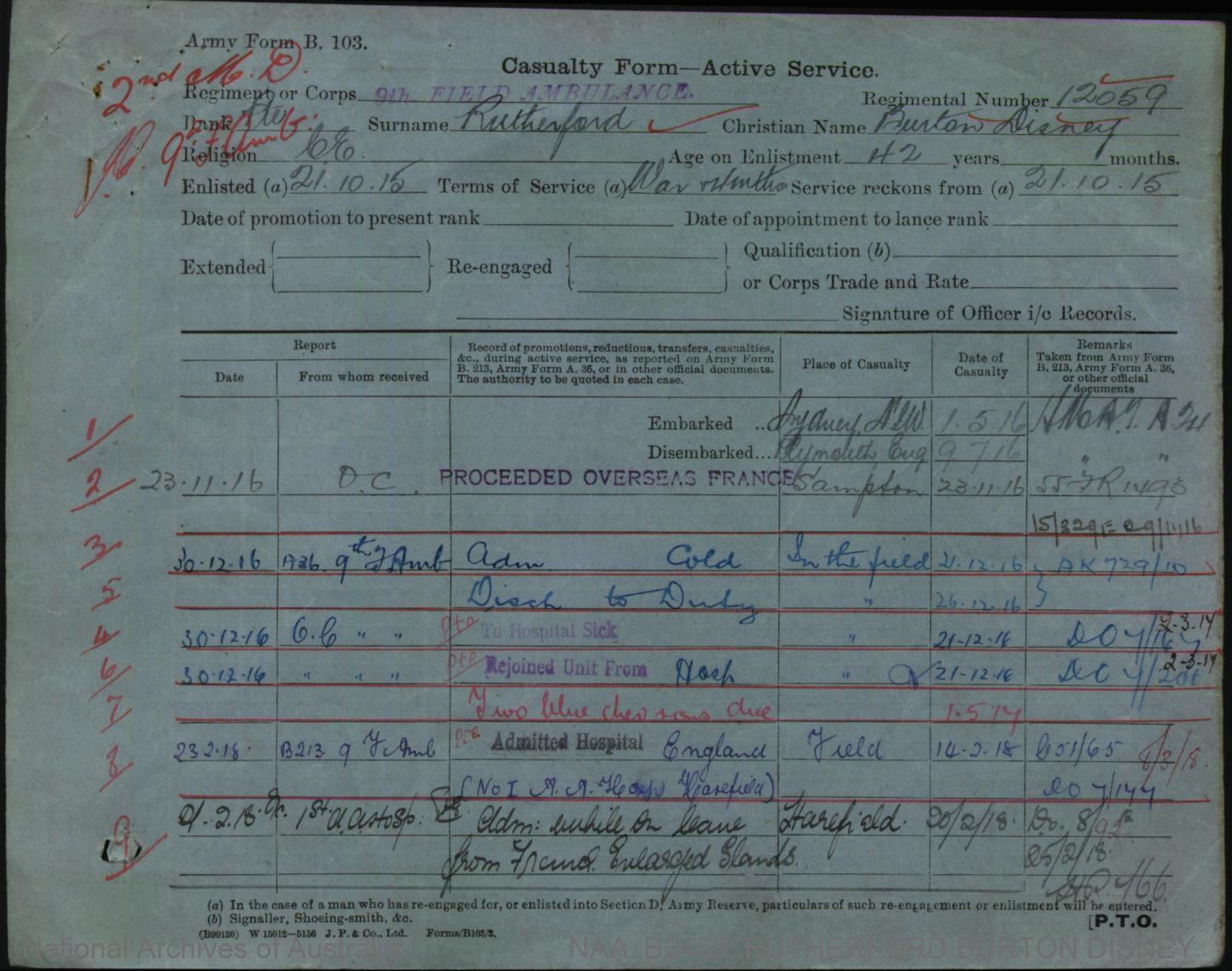
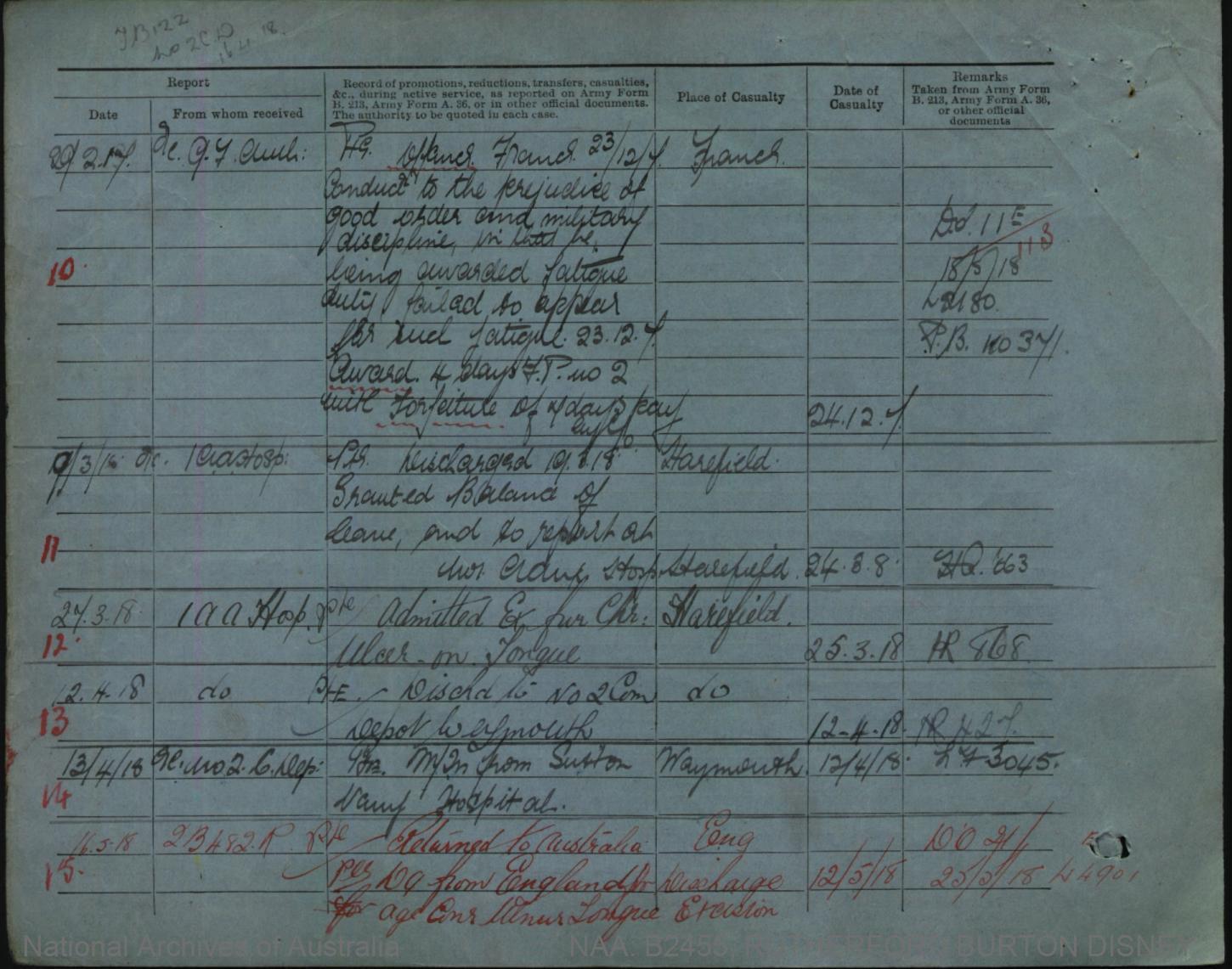
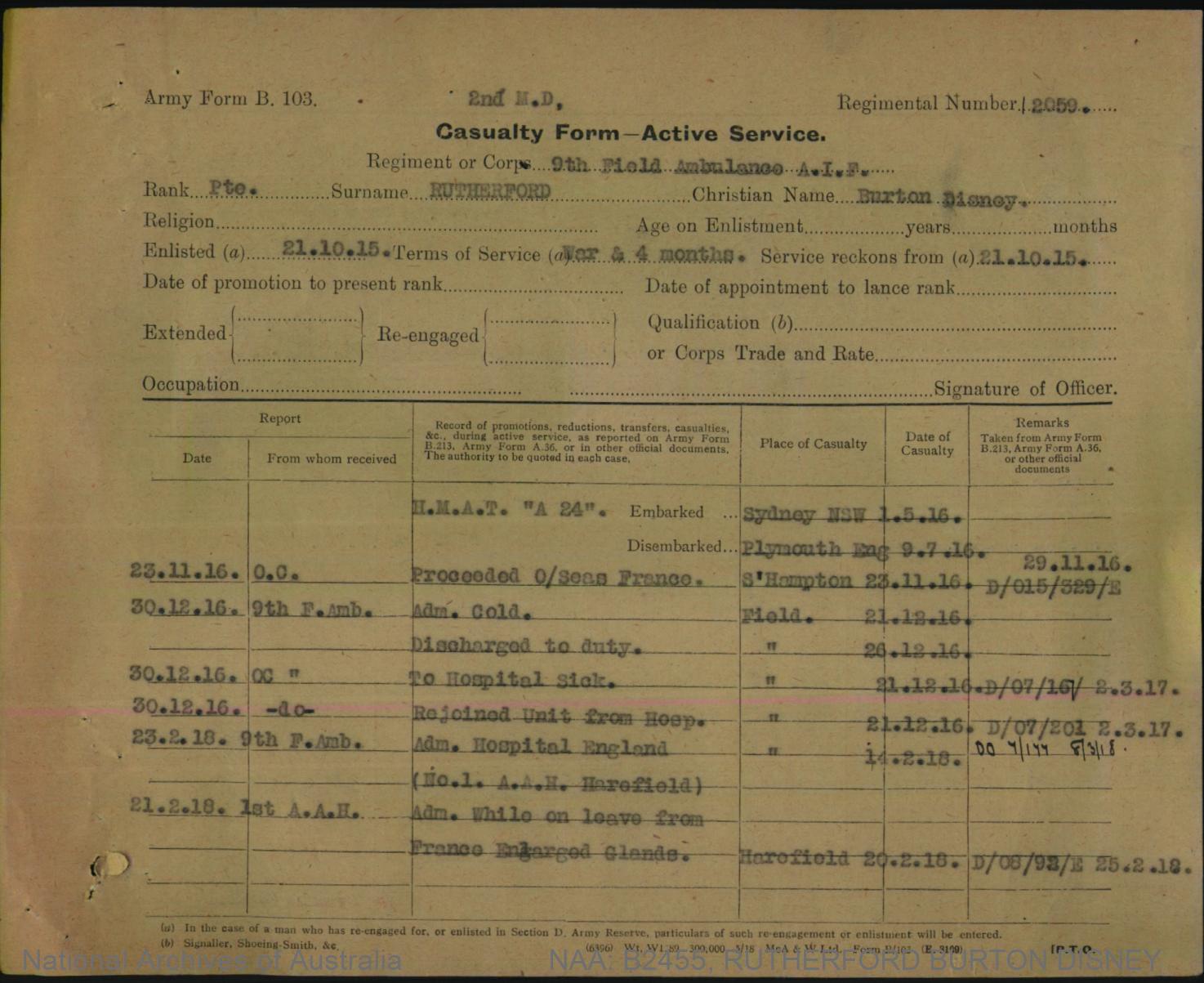
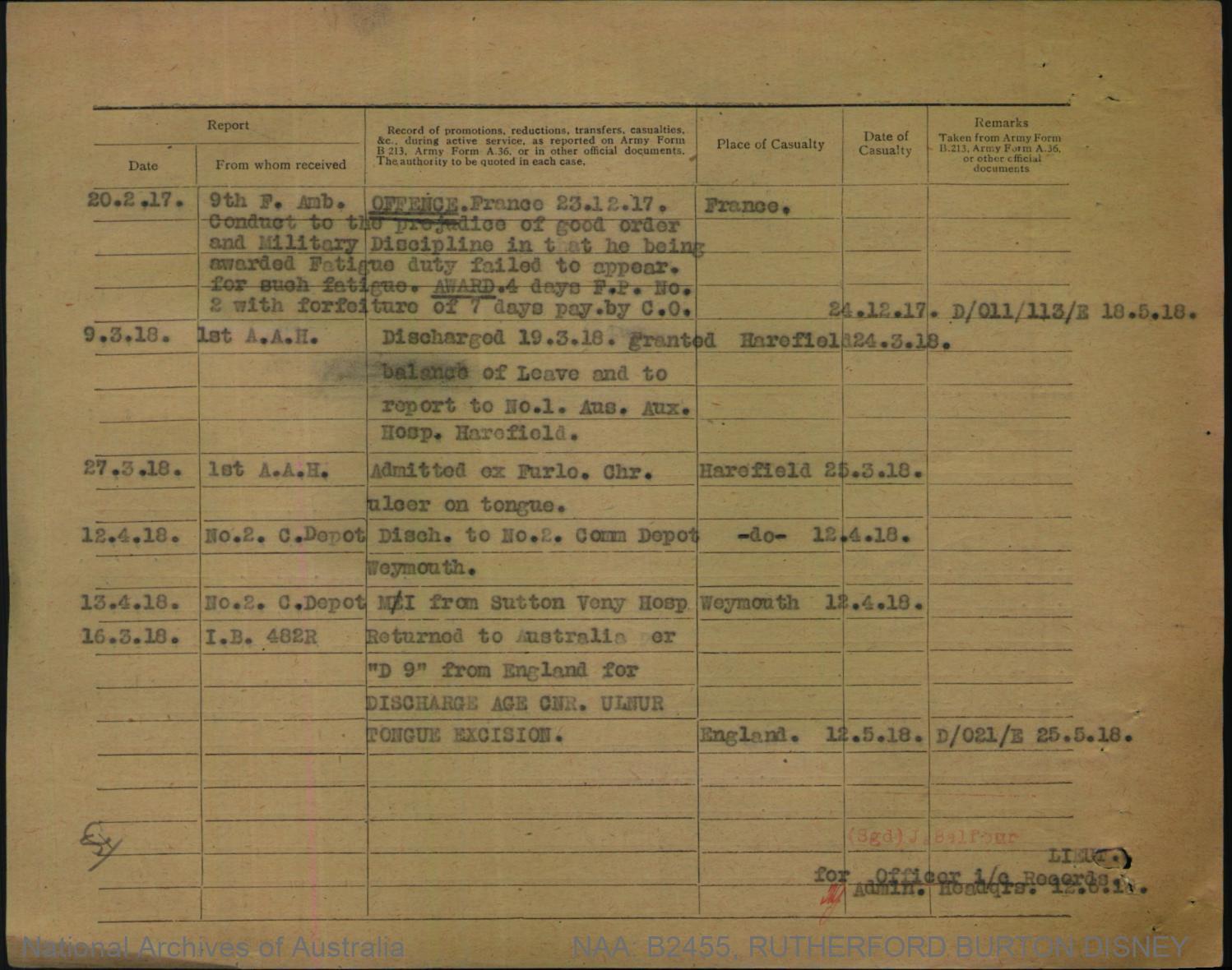
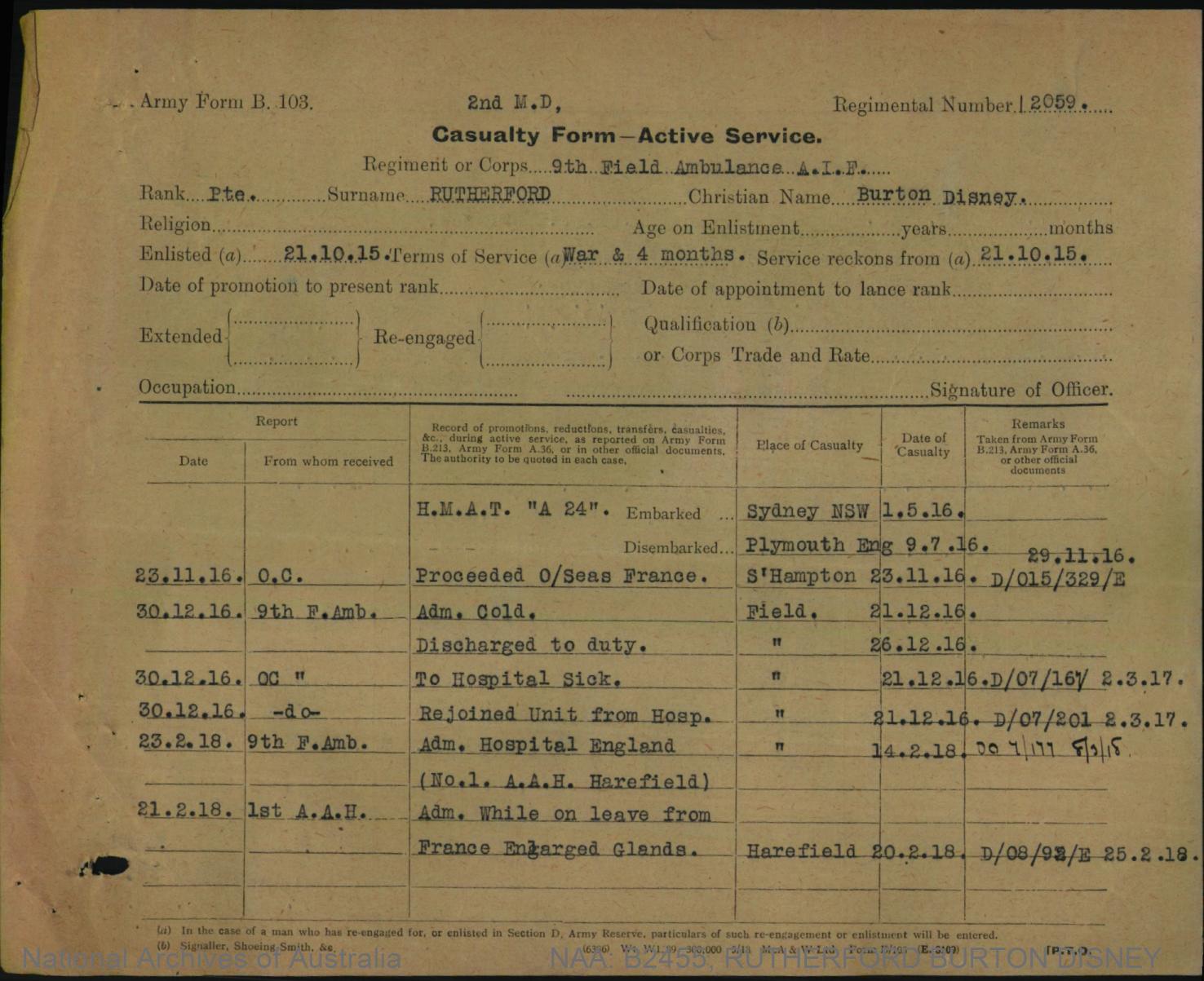

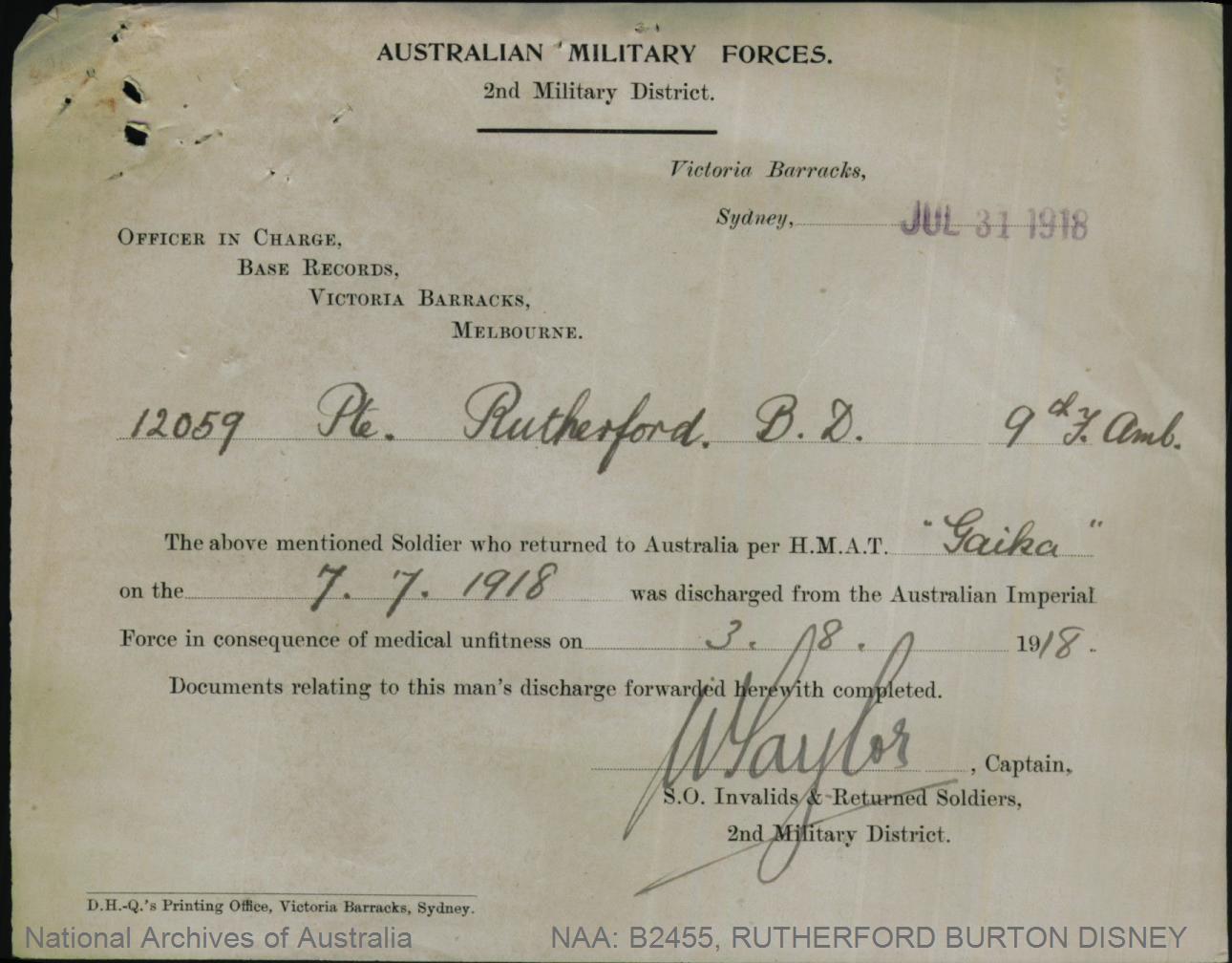
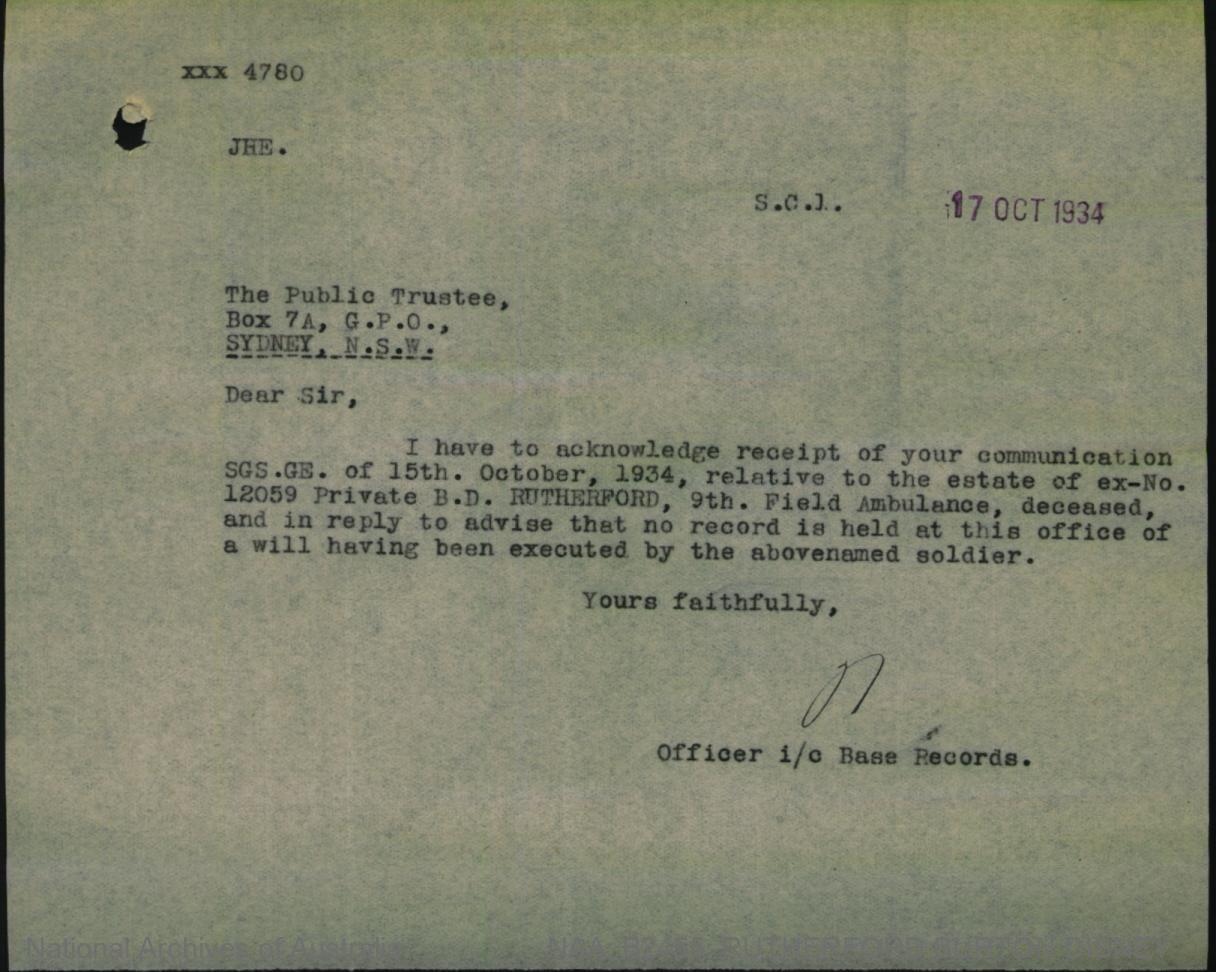
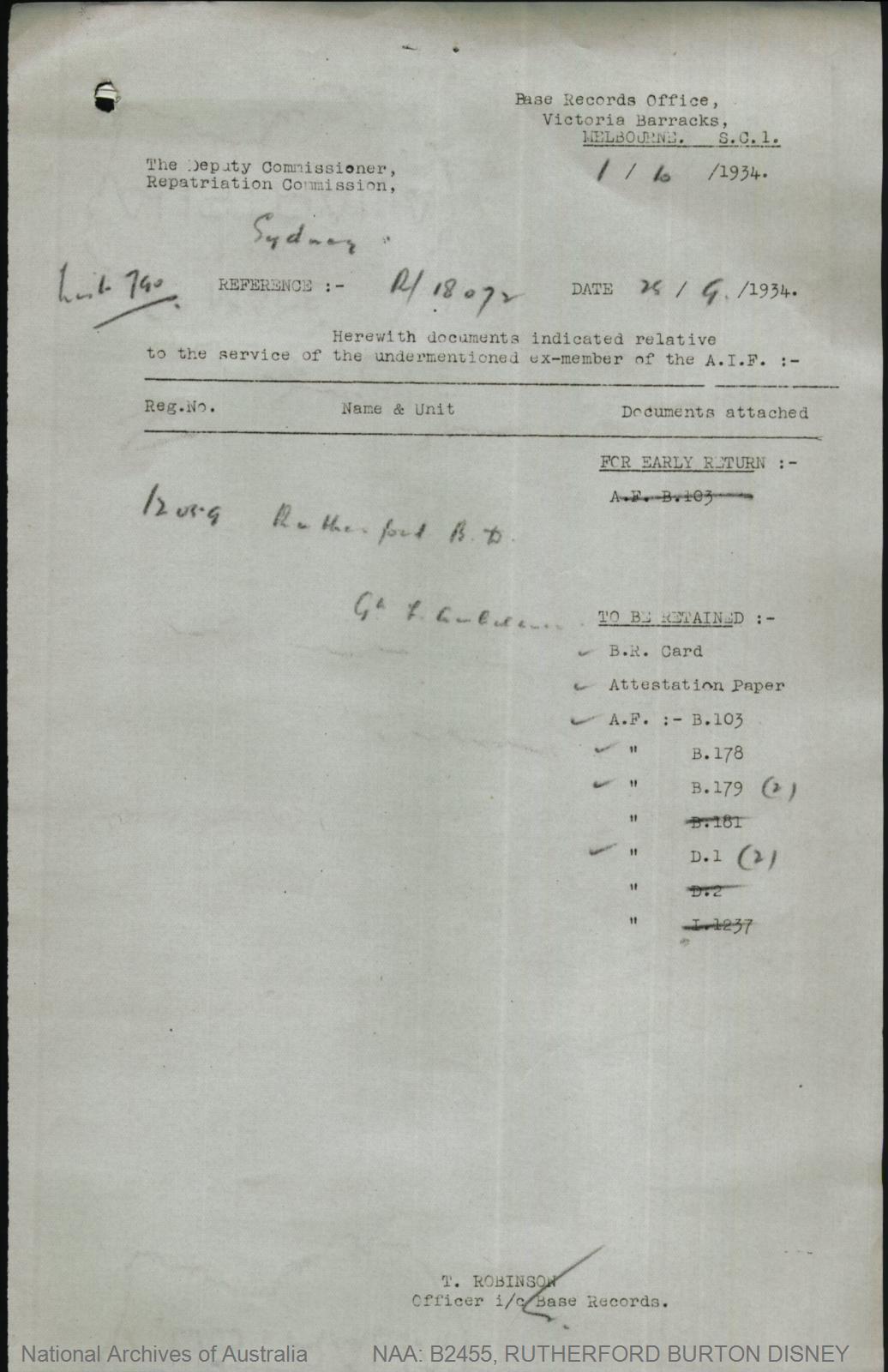
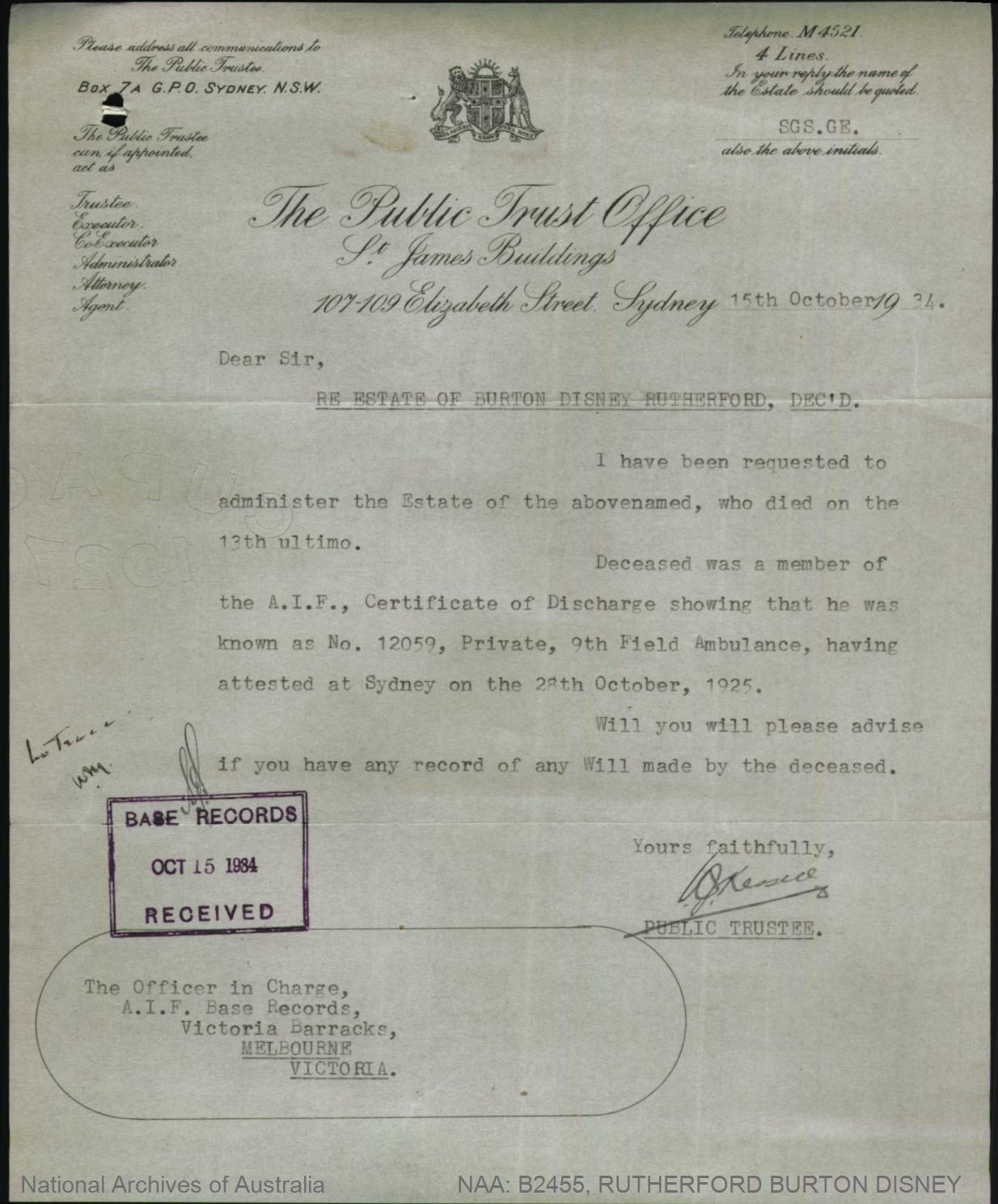
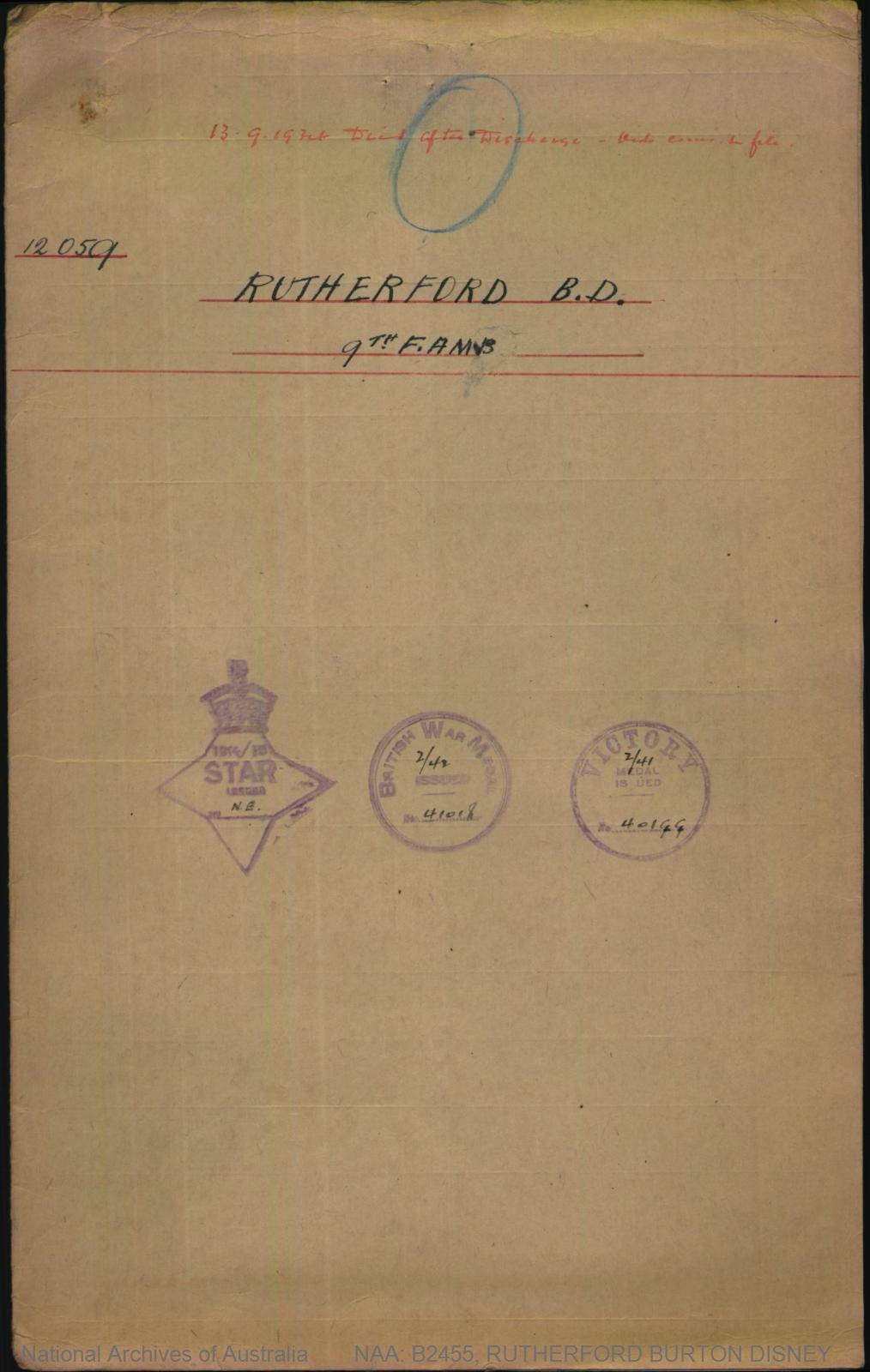
© Commonwealth of Australia (National Archives of Australia)
Under Construction: 10/04/2024-16/04/2024.

NEW SOUTH WALES CITIZENS' BUSHMAN - 36th BATTALION A.I.F.
Captain: Arthur Frederick FITZHARDINGE.
Born: 13th September 1875. Balmain, New South Wales, Australia. Birth Cert:4785/1875.
Married 1: 17th August 1904. Wynberg, Cape Town, Western Cape, South Africa.
Wife 1: Florence Madeline Fitzhardinge. nee: Goss. (1880-19/08/1905) died at Eastern Cape, South Africa.
Married 2: 1912. Gilgandra, New South Wales, Australia. Marriage Cert:5712/1912.
Wife 2: Rebecca Harriet Jessie Fitzhardinge. nee: Barden. (1889-1970)
Died: 24th October 1922. Sydney, New South Wales, Australia. Death Cert:14570/1922.
Father: Maurice Arthur Hyde Fitzhardinge. (1849-1935) Died at Mosman, N.S.W. Death Cert:15397/1935.
Mother: Rebecca Annie Fitzhardinge. nee: Devlin. (1846-1936) Died at Mosman, N.S.W. Death Cert:15556/1936.
INFORMATION
On the 22 Oct 1891 at Sydney, New South Wales, Australia Arthur appointed Captain in the Public School Cadet Force with the Sydney Cadets "possibly at the Fort Street Public School" where Arthur was once a student.

Government Gazette 22 Oct 1891 of Arthurs appointment
Arthur Frederick Fitzhardinge served with C Squadron NSW Citizens' Bushmen Contingent and embarked from Sydney on board S.S. "MAPLEMORE" from Sydney, New South Wales on 28 February 1900 and was promoted to the rank of Corporal service number 279 and 2nd Battalion Lancashire Fusiliers 20th Foot and accepted an Imperial Commission in South Africa as a Second Lieutenant.
23rd February 1900.
FAREWELLS TO BUSHMEN
Last night, at the invitation of Mr. M A. H. and Mrs Fitzhardinge, about 300 of the personal friends of Corporal Fitzhardinge, who leaves for South Africa with the Bushmen's Contingent on Wednesday next, assembled on board the steamer Lady Hampden, and were taken for a pleasant trip down the harbour. Occasion was taken by those present to say good-bye to their associates in the various athletic clubs with which Corporal Fitzhardinge had been connected. Mr. Q. L. Deloitte presided. A programme of musical items was carried out by the members of the Wonda Musical Club, the contributors being Messrs. A. D. Ross, W. Young, L. Johnees, A. D. Whitling, J. B. M'Gregor, A. F. Fitzhardinge, W. Cameron, Dr. Fleishman, and Dr. Hinder. Short addresses were delivered by Messrs, Q. L. Deloitte, J Curtin, A. ??, J. L. Adams, Rev W A Charlton, AV. H Palmer, C. L Quist, and A V Cameron. The toast, "Success and safe return to the Bushmen's Contingent," was honoured, being proposed by Captain Neitenstein, and supported by Captain Mason and Mr. J. Fitzsimmons. Mr Leicester Johnson acted as accompanist. A very pleasant outing was concluded by singing "God save the Queen" and "Auld Lang Syne"
The Sydney Morning Herald.

S.S 65 "MAPLEMORE" leaving Sydney for South Africa
NEW SOUTH WALES CITIZENS' BUSHMAN
The Contingent left Sydney on the 28th February 1900 on transports "Atlantian" and "Maplemore" and arrived at Cape Town on the 2nd April and proceeded to Biera where they disembarked on the 12th April and proceeded via Marandellas to Bulawayo with a strength of 30 Officers and 495 other ranks with 570 horses and 10 carts. Of these 1 Officer and 29 others died or were killed, 6 Officers a 8 others were transferred, 3 Officers and 49 were struck off strength in South Africa. 1 Officer and 1 other were commissioned in the Imperial army. 23 Officers and 404 others returned to Sydney.
Arthur was the 1 other to receive a Commission in the Imperial Army.
Staff and "A" Squadron served under General Plumer at relief of Mafeking. Served in General Plumer's Brigade in General Baden-Powell's column at the relief of Rustenburg. After a smart engagement, occupied to town on the 7th July 1900. "B" "C" and "D" Squadrons under Lieutenant Colonel Airey DSO took part in a severe engagement at Koster's River on the 22nd July 1900 in attempting to relieve the Eland's River Garrison. "A" Squadron assisted by about 50 men of the other details, defended Eland's River post against De la Rey with 1,00 men and guns for 13 days, refusing to surrender on any terms. They were eventually relieved by Lord Kitchener's force on the 15th August and Lord Methuen's column arrived from the north on the 18th August 1900.
NSW CITIZEN BUSHMEN/AUSTRALIAN BUSHMEN CONTINGENT/1ST BUSHMEN REGIMENT
- Original strength: 525
- Subunits: four mounted rifle squadrons
- Commanding officers: Lieutenant-Colonel H. P. Airey then Major J. F. Thomas
- Left for South Africa: 28 February 1900 on Atlantian and Maplemore
- Service: April 1900 - April 1901 in Rhodesia under Carington, west Transvaal including defence of Elands River Post (4-16 August 1900), and under Plumer in northern Transvaal, great De Wet hunt (February - March 1901) and advance on Petersburg
- Fatal casualties: 17 killed or died of wounds, 13 died of disease
- Decorations: one CMG (Airey), four DSOs (A. B. Baker, H. B. Christie, W. Cope, T. M. Moore), three DCMs (T. Borlase, R. G. Davenport, W. F. Hunt)
- Returned to Australia: 11 June 1901
The Australian Boer War Memorial
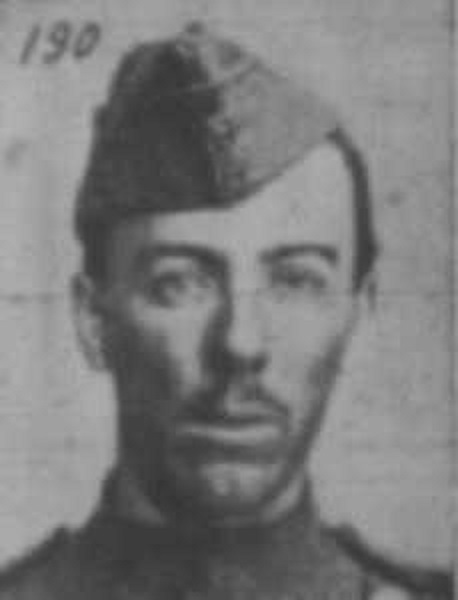
Corporal: 279 Arthur Frederick Fitzhardinge served with C Squadron NSW Citizens' Bushmen Contingent
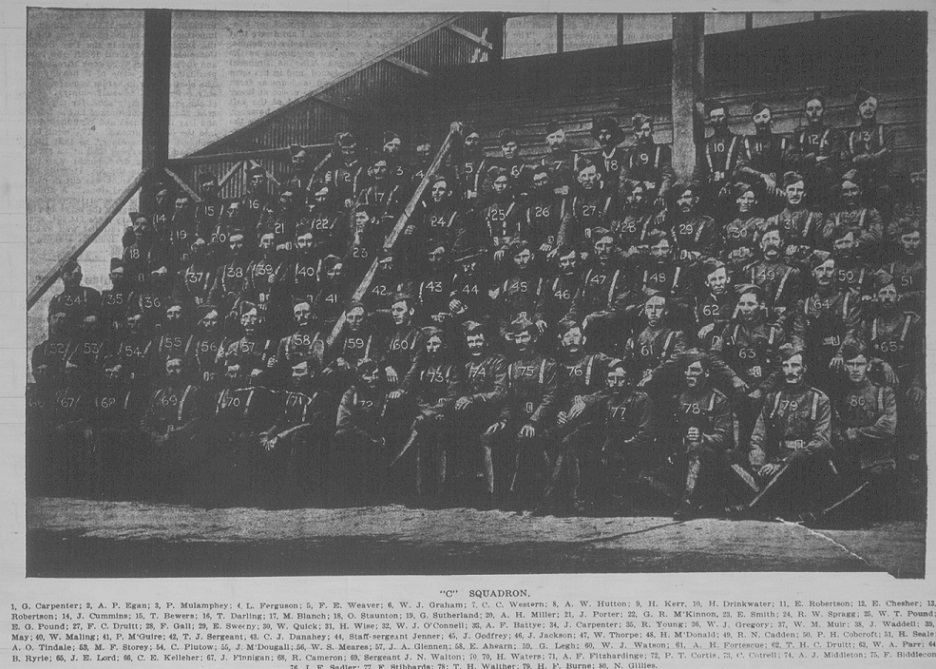
The Town and Country Journal, 24 February 1900, p. 24. C SQUADRON "New South Wales Citizens' Bushmen Contingent 1900.
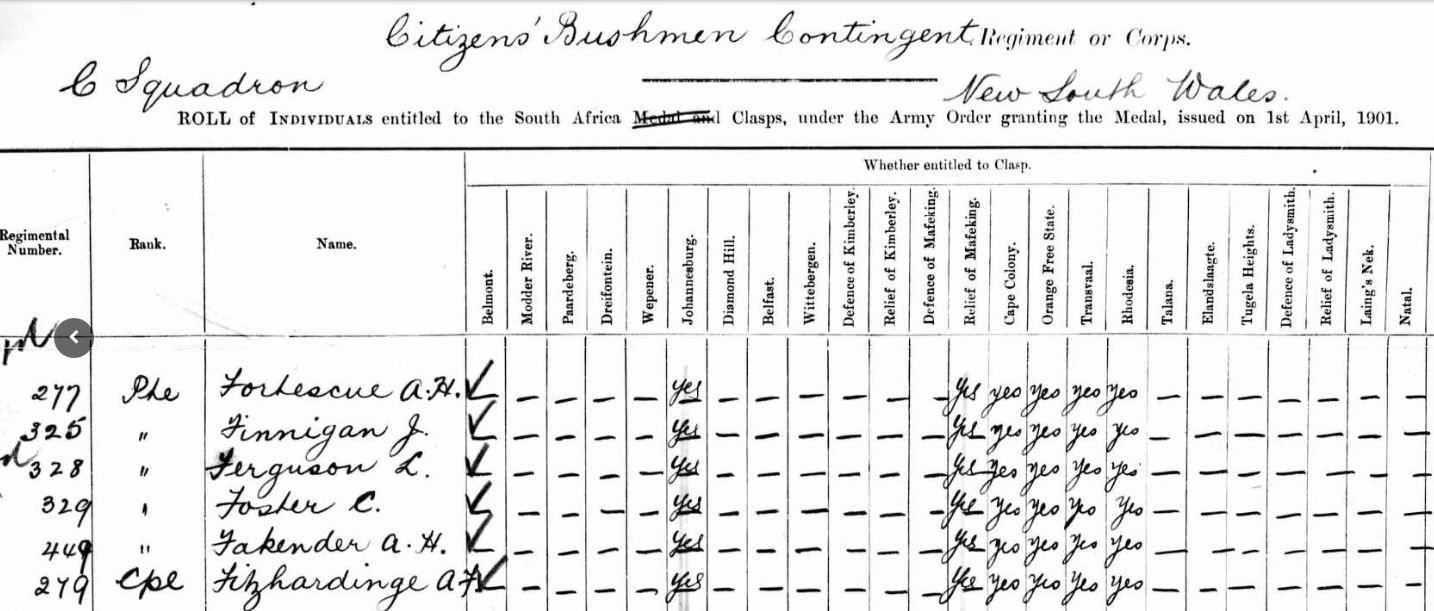
Queen South Africa Medal and Clasps.
Johannesburg: All troops who on 29th May 1900 were north of an east and west line through Klip River Station (exclusive) and east of a north and south line through Krugersdrop Station(inclusive).
Relief of Mafeking: All troops under the command of Colonel Mahon who marched from Barkley West on 4th May 1900, and all troops who were under Colonel Plummer's command between 11th October 1889 and 17th May 1900, both dates inclusive and who were south of an east and west line drawn through Palachwe.
Cape Colony: All troops in Cape Colony between 11th October 1889 and 31st May 1902, inclusive and who had not received a clasp for a specific action in the Cape Colony or the Natal clasp.
Orange Free State: All troops in Orange River Colony at any time between 28th February 1900 and 31st May 1902 inclusive who had not received a clast for a specific action in the Orange River Colony.
Transvaal: All troops in the Transvaal at any time between 24th May 1900 and 31st May 1902 inclusive who had not received a clasp for a specific action in the Transvaal.
Rhodesia: All troops who were under the command of Lieutenant General Sir F Carrington and Colonel Plummer in Rhodesia between 11th October 1899 and 17th May 1900 both dates inclusive or who landed at Beira between 11th October 1889 and the 25th May 1900 both dates inclusive.
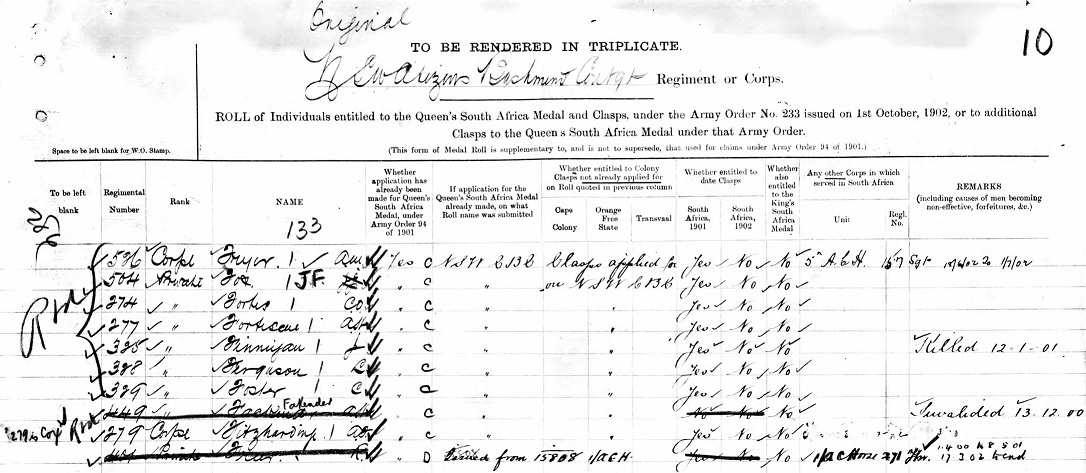
South Africa 1901: All troops who served in South Africa between 1st January 1901 and 31st December 1901 both dates inclusive who were not eligible for the King's South Africa Medal. 279 Corporal FITZHARDINGE C Squadron. Entitled to date clasp 1901 Yes. 1902 No. King South Africa Medal. No.
The Relief of Mafeking
Richard Cavendish describes the relief of Mafeking, following a seven-month siege, on May 16th/17th, 1900.
The siege of Mafeking lasted seven months from October 1899, when the little town was surrounded by a Boer force of some 5,000 men under a redoubtable leader, Piet Cronje. The British garrison commanded by Colonel Robert Baden-Powell (B-P for short) numbered about 2,000 officers and men. Also in the town were some 7,500 black Africans, some of whom were refugees from the surrounding country. One of the reasons why the siege was bound to be in the news was the presence in the beleaguered town of journalists from four London papers – The Times, Morning Post, Daily Chronicle and Pall Mall Gazette. Their dispatches were slipped through the Boer lines by native runners who carried them to a telegraph office fifty miles away. To conserve supplies for his fighting men, B-P made many attempts to get the useless mouths among the native Africans to leave the town – without much success since they had to run the gauntlet of the besiegers and most of those who made the attempt were either shot or flogged and sent back. The modern allegation that he deliberately starved the Africans to feed the whites and force the blacks out, however, has been vigorously challenged.
In November, Piet Cronje withdrew with two-thirds of his men, leaving the rest under Commandant J.P. Snyman to continue shelling the town and trying to starve it into surrender. By mutual agreement there was no action on Sundays, when everyone relaxed, picnicked and played cricket and polo, and B-P took care to adopt a carefree and confident demeanour to keep morale high. The Pall Mall Gazette correspondent called him "a man in a thousand". The weeks wore slowly on until at the end of March a small British relieving force was smartly seen off by the Boers. In the first week of May both Baden-Powell and the besiegers received word that a far more powerful British flying column of 1,100 men under Colonel B.T. Mahon, mainly South African irregular cavalry with field artillery, had left Kimberley on its way to Mafeking. In the early morning hours of May 12th the Boers mounted a last attempt to take the town, led by a dashing young officer named Sarel Eloff, who was a grandson of President Kruger. Eloff and his force broke in, but were held and after Eloff had shot some of his own men for running away, he surrendered. He was taken to B-P, who characteristically invited him to supper.
On May 16th, Mahon's force broke through the Boers eight miles north of Mafeking. The noise of firing was clearly audible in the town and people climbed onto the roofs of the houses and strained their eyes towards the north. An advance patrol of horsemen arrived at seven o’clock in the evening, to be greeted with British sang-froid by a passer-by who said casually, "Oh yes, I heard you were knocking about." As word spread, however, the men were mobbed and cheered to the echo while the crowd sang the national anthem and "Rule Britannia". The main relieving force rode in at 3.30 am to a rapturous welcome from the excited garrison.
The news was greeted with hysterical rejoicing in Britain after the disasters of the earlier days of the war. Riotous flag-waving crowds sang, danced and cheered themselves hoarse for hours on end in London's West End and at Covent Garden Wagner's Lohengrin was halted when the news was shouted from the gallery and the Prince of Wales beat time in his box as the audience burst into song. In the provincial towns factory sirens hooted and brass bands played. B-P was the hero of the hour. His qualities of courage and resourcefulness spiced with an engaging humour and a gift for effective understatement were exactly what the moment needed.
1902-1905
Possibly involved in the post war railway reconstruction "Arthur met a civil engineer from Sydney in South Africa, Richard (Dick) Cliff. At the end of the war they contracted with the South African Government to electrify part of the railway system"
Arthur was admitted Supreme Court of NSW 28/05/1910.
Family legend has it that Arthur was one of the instigators of the famous Coo-ee March from Gilgandra to Sydney during World War I. A number of volunteers from Gilgandra marched to Sydney gathering other volunteers as they went to enlist en masse on arrival in Sydney. Arthur was there to meet them; as an organiser he had gone by train and had already been enlisted from the Reserve of Officers.
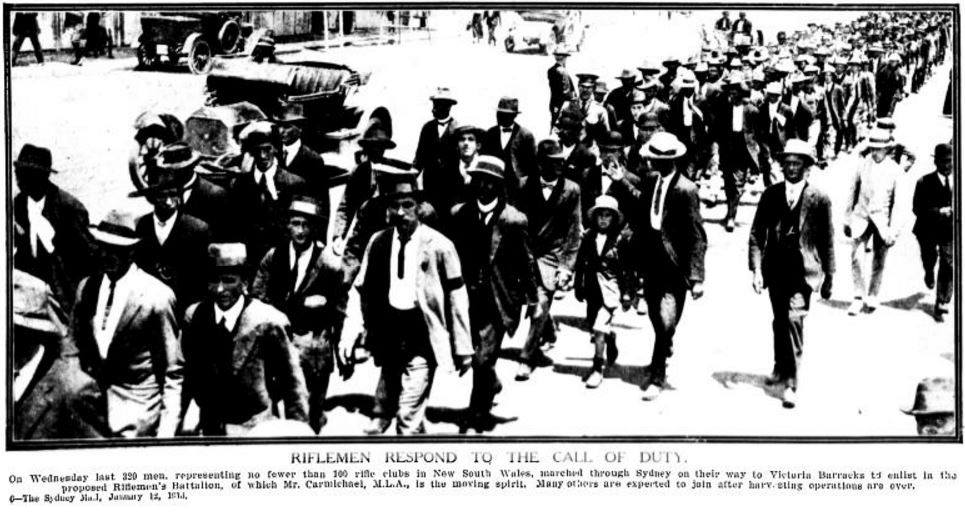
Arthur enlisted with A Company, the 36th Battalion AIF in March 1916 with the rank of Lieutenant and embarked from Sydney on board HMAT A72 "Beltana" on the 13th May 1916 and disembarked at Devonport, England on the 9th July 1916 where they were marched in the the 9th Training Battalion at Lark Hill. Arthur was promoted to the rank of Captain on the 1st August 1916.
22nd November 1916.
Larkhill. Troops en trained at Amesbury Station in three trains. 1st Train 7:47 am Compliment-Officers 11 and 327 others, 19 horses, 8 hand carts, 3 4 wheeled wagons and 9 bicycles. Lieutenant Colonel: James William Albert SIMPSON. Officer Commanding. A Company Lieutenant: Herman Augustus ARNOLD. B Company Lieutenant: 3 Harry WOODHAMS. C Company Lieutenant: James Michael JULEFF.
2nd Train 9:15 am-Compliment-Officers 11 and 327 others. 20 horses, 2 two wheeled, 5 four wheeled vehicles. Major: Archibald Clifford BLACKLOW. Officer Commanding. A Company Lieutenant: Richard Henry DOYLE..
3rd Train 11:am- Compliment-Officers 10, 326 other ranks, 20 horses, 2 two wheeled, 5 four wheeled vehicles. Major: Archibald Leeson PRINCE. Officer Commanding. B Company Lieutenant: 1376 William James GORDON.
Embarked "Caesarea" 24 Officers, 811 others. Embarked "African Prince" 8 Officers 168 others, 59 horses, 15 four wheeled vehicles, 12 two wheeled vehicles and 9 bicycles. Total 32 Officers, others 979 left Southampton 6:00 pm. 1 Officer 75 others detailed as sentries and boat guard. 1 Sergeant, 1 Corporal and 20 detailed as Firing Party. 5 Sanitary Police and 10 men as Sanitary Party.
23rd November 1916.
Arrived at La Havre 1:40 am. Disembarked 7:25 am. Marched via town to No:1 Rest Camp arrived 11:40 am. Remained at Rest Camp, Le Harve, till 6:30 am 24th November 1916.
24th November 1916.
36th Battalion, less 8 Officers 250 Other Ranks marched via town to point 3 Railway Station, Le Harve at 8:00am. En trained and left Le Harve at 10:30 am. Proceeded via Montcrolier Buchy, Abbeville 6:10 am. 10 hours late via Boulogne Calais and Bailleul. Arrived at Bailleul at 4:25 pm 25th November 1916.
25th November 1916.
Detrained at Bailleul marched to billets at Merris district. Arrived at billets 10:45 pm. Quartered in 12 billets. Headquarters at Hameur Farm.
26th November 1916.
4 Officers 100 men "A" Company arrived at Merris at 8:30 am. Remainder of Battalion arrived at Merris 4:00 pm. Hostile aircraft shelled overhead 2:15 pm.
27th November 1916.
8 N.C.O's detailed to attend Gas School for 4 days. All Officers instructed in Box Respirator by Divisional Gas Officer. General: Alexander John GODLEY and General: Sir John MONASH visited billets at Hameur Farm at 2:30 pm. Captain: John Martin HAWKEY. and 1 N.C.O. per Company visited forward billets at Armentiers.
28th November 1916.
Battalion left for Armentieres in 16 Motor Lorries. Whole Battalion reported in billets at Armentieres at 5:30 pm. Headquarters established at 6:00 pm Rue De Strasburg.
29th November 1916.
Whole Battalion still in billets-supply Working Parties Only.
30th November 1916.
Visited the front line on left sector of Defences at Armenteriers.
Arthur was treated by the 11th Australian Field Ambulance on the 22nd March 1917 and admitted to hospital for treatment. Upon his discharge he re-joined the 36th Battalion in the field.
7th June 1917.
THE BATTLE OF MESSINES
The 3rd Australian Divisions first major offensive was at Messines Ridge on the 7th June 1917. The Australian 3rd Division was a part of the II Anzac Corps which was allotted to the first assault. The 25th New Zealand, 3rd Australian Division with the 4th Australian Division in reserve. The 4th Division were battle hardened troops who had fought many major battles. The 3rd Australian Division were having problems getting to the "jump off" point. The day before the 9th and 10th Infantry Brigades were bombarded by German Gas-Shells around Hill 63 and Ploegsteert Wood. Many of the Aussies were not wearing gas masks, but despite this they pressed on even though they received 500 casualties.
They made it to the "jump off" point but only just with some of the men from the 9th and 10th going straight over the top without stopping. The mines went up and the attack commenced behind a protective barrage. The II Anzac Corps were attacking on the right with their objective being the southern shoulder of the ridge which included Messines, the Dover and St Yves areas as far south to the east of Ploegsteert Wood.
Major General Sir John MONASH's 3rd Division had to contend with a tricky 3 mile approach out of Ploegsteert Wood and after the German gas attack, but they were not deterred. The 9th Infantry Brigade under Brigadier General: Alexander JOBSON and the 10th Infantry Brigade under Brigadier General W R NICHOLL had just made the jumping off point but some of the men did not stop, going straight into the assault from the approach march.
Their objective lay between St Yves and the Douve. The mines at Trench 127 and Trench 12 at Factory Farm were laid to aid this task. The explosions erupted a few seconds before zero hour and created craters of 200 feet in diameter, completely obliterating the German defence line as the 9th and 10th Infantry Brigades went over the top. The mine crates forced the 9th and 10th Brigades to veer to the left and right which caused some confusion with the main assault. It is testimony to the quality of training that every man knew the ground, tasks and objectives so well.
Private: 1804 John CARROLL 33rd Battalion, rushed the enemy's trench and bayoneted four of the German occupants. He then noticed a comrade in difficulties and went to his assistance, killing another German. He then attacked single handed a German Machine Gun Team, killing all three of them and capturing the gun. He later rescued two of his comrades who had been buried alive by German Shell Fire, and in spite of heavy shelling and machine gun fire he dug them out alive and saved them from certain death. John was awarded the Victoria Cross.
The German forward zone was completely engulfed and taken by the main assault. The two supporting battalions of each brigade then passed the leading battalion to continue the advance. The men were constantly re-supplied and the ridge was taken. There were many German prisoners taken during the offensive. The 3rd Division was well ahead with the 9th Infantry Brigade pushing on beyond Grey Farm, and on the right the 10th Infantry Brigade were veering left towards Septieme Barn north of Douve.
The German resistance was heavy but was generally brushed aside by tanks and artillery before the infantry had to become too involved. The 4th Bavarian Divisions Artillery had made little impact, but as the day wore on the 3rd Division and later the 4th Australian Division received many casualties from German artillery. (70% of all casualties during WW1 were from artillery).
By 9:00am nearly 6 hours after the assault began the Germans were in disarray, but there was a major problem as the Australians received less casualties as anticipated and when ordered to dig into the ridge they had so many men, that some could not find shelter. the 35th battalion were dug in around Seaforth Farm.
The second phase of the operation was to take the Oosttaverne Line. The 3rd Australian Division would now be in reserve with the 4th Division attacking. The 9th Infantry Brigade (33-34-35-36Bn) were near Thatched Cottage facing Warneton. The river Lys was to their right and the Ploegsteert Wood was now behind them.
Once their objectives were taken the troops consolidated. A barrage to stop and counter attack was shortened and caught three battalions which had to retire. By 9:00 pm this part of the Oosttaverne Line was abandoned. At 10:45 pm General: Alexander John GODLEY ordered the 3rd and 4th Divisions to retake it. This they did by the early hours of the 8th of June.
The Battle for Messines Ridge during May-June 1917 saw 35 officers and 1,631 other ranks loose their lives.
9th Infantry Brigade Casualties.
| 33rd Battalion. AIF | 8 Officers | 382 Other ranks |
| 34th Battalion. AIF | 10 Officers | 378 Other ranks |
| 35th Battalion. AIF | 5 Officers | 431 Other ranks |
| 36th Battalion. AIF | 9 Officers | 421 Other ranks |
| 9th Machine Gun Company. AIF | 2 Officer | 17 Other ranks |
| 9th Light Trench Mortar Battery. | 1 Officer | 2 Other ranks |

FIELD DRESSING STATION, MESSINES 7th June 1917.
Arthur was treated again by the 11th Australian Field Ambulance on the 26th July and evacuated for further treatment and admitted to the Officers Rest Home to recover. After his discharge Arthur re-joined the 36th Battalion on the 18th August but the effects from Gas Poisoning saw him being treated and he was invalided to Harve before he was evacuated back to England where he was marched in the the No: 2 Command Depot and placed on the Seconded List to be demobilized back to Australia. Arthur returned to Australia on board HMAT A43 "Persic" on the 8th April 1918 for Home Service and served as Captain with the 6th Australian Light Horse New South Wales Mounted Rifles at Kyogle.
1899-1918 QSA & pr to an officer. QSA 1899-1902 (ghost date reverse) no clasps (missing 4) to "279 CPL A F FITZHARDINGE NSW CBC" (chisel cut), 1914-18 BWM & Victory Medal to "CAPT. A. F. FITZHARDINGE AIF". Capt. Arthur Fitzhardinge served in South Africa in the Citizens Bushmen's Contingent (NSW Bushmen) & with a commission in the 2ndBN Lancashire Fusiliers & 9 LHR (CMF) before enlisting as a Captain in the 36thBN AIF in France. C/W copy of AIF service record of service, a letter in which states that he is also entitled to the Kings South Africa Medal & two clasps. gVF.
(Status International-May 2010-October 2023)
Arthur's Queen South Africa Medal: 279 CPL A F FITZHARDINGE NSW CBC , War Medal:44791 to CAPTAIN A F FITZHARDINGE AIF and Victory Medal:43790 to CAPTAIN A F FITZHARDINGE AIF were acquired at auction in October 2023 and are now in the Harrower Collection.
Arthurs medals were first issued to his second wife Rebecca on the 23th March 1928.
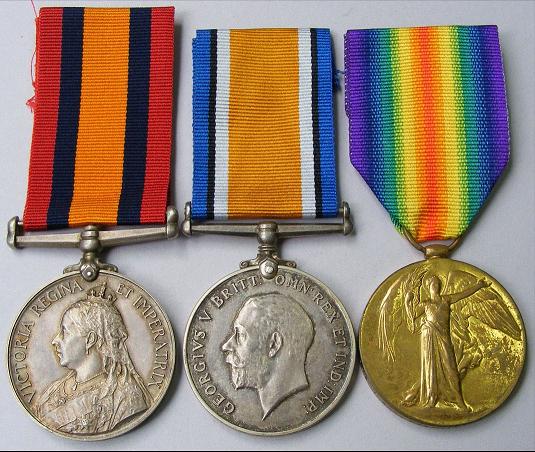

Family Information
Multiple Stains
Stanley L Devlin
Rebecca Anne Devlin (1846-1936) and her husband, Maurice Arthur Fitzhardinge (1849-1935) first lived at Queen Street, Woollahra, when they moved to Sydney from Wagga. They left Woollahra because of the scarcity of water; Rebecca said that they had to borrow a bucketful to wash the baby! From Woollahra they moved to Snail's Bay where Rebecca caught typhoid fever but never recovered. Later they bought "Keba" in Louisa Road Balmain, and lived there for forty -eight years. Maurice had been a prominent figure in the aquatic world since his youth. In his boyhood days there was no ferry service between Balmain, where he was born and lived, and the city, so he and his brothers rowed their father to and from the city each day. Maurice was coxswain of the New South Wales four-oar crew in the first-ever race against Victoria and he stroked the New South Wales boat in the last fixed-seat race. On one occasion, when they were young men, he and his two brothers rowed from Sackville Reach on the Hawkesbury River to Sydney in an 18-foot boat. Their intention was to go as far as Pittwater and there take the Gosford steamer. Something interfered with the running of the steamer, and as the day was fine and the sea smooth, the brothers pulled out of Broken Bay and safely completed the journey to Sydney in their rowing boat.
The Fitzhardinge's 24-foot yacht Adelphi was well known on the harbour. Maurice was a member of the Sydney Rowing Club and the Sydney Amateur Sailing Club and was a committeeman for the Anniversary Regatta and the Balmain Regatta for many years. Maurice and his brothers Moreton, Grantley Craven and Harry or James would often row as far as Windsor, staying overnight with farmers and making the trips joyous occasions. Grantley, later Judge Fitzhardinge, would sail to Eden, be driven by horse and trap around his circuit and sail home again. Leslie Devlin Fitzhardinge was accidentally drowned at Balmain when he was five years old and Garnet Maurice lived only for a little over a year.
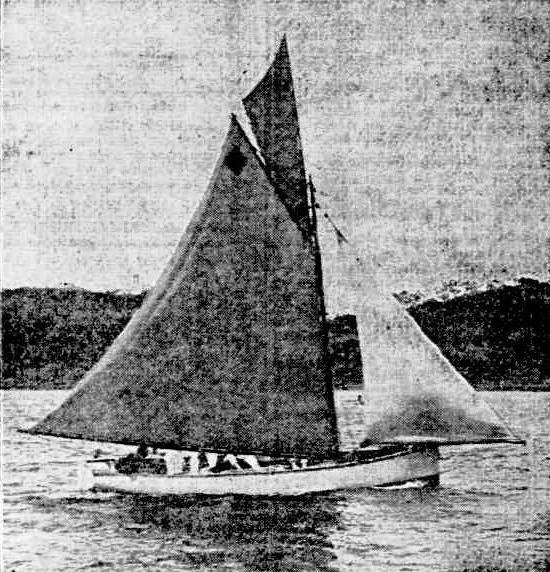
The Adelphi 1907 (Coryphene's Sister)
Mr A.D. Whitling of 66 Shepherd Street, Ryde, wrote on 16 August 1969. Mr Whitling then being 93 years old.
I first met Arthur Frederick Fitzhardinge at the old Fort Street School in Sydney in the late eighties. We were in the same class and we came close friends. I first went to 'Keba' when Arthur and I exchanged some birds eggs. After that I was often at his house and he at mine. The Boer War came and he enlisted. The friendship continued. I remember that his first wife (in South Africa) wrote me a charming letter soon after their marriage. But after he eventually returned and he had a practice in the country I lost touch with him. I was fond of all the members of the family. Grandmother Rebecca was a very dear old soul and her husband was a splendid and most efficient yachtsman. I have memories of many delightful picnics on the harbour with the family on the "Adelphi".
Rebecca may very well have been a 'dear old soul' as described by Mr Whitling, but within the family she was regarded as being strong willed and the ruler of the household. She insisted that Arthur, as the eldest son, should follow in his father's footsteps and become a solicitor, even though his natural inclination was to engineering, electrical in particular. Arthur enjoyed sailing and rowing, tennis and cricket and, as a member of the Balmain Rowing Club, was in the same crew as his friend A.B. ('Banjo') Paterson. Perhaps Banjo encouraged the young man to enlist for service in South Africa. Their friendship continued during their Boer War experiences.
Sydney Morning Herald - 14 November 1896
Maiden Fours Balmain Regatta - 1896
The annual Balmain Regatta, held on Monday on the waters of Iron Cove, was the most successful of it kind for many years past. Hardly a better day could have been chosen to suit a mixed regatta of sailing and rowing. The rowing part of the regatta was undoubtedly very successful, and added much to the enjoyment of the crowded flagship, as well as to some thousands who were on the shore of Balmain, and some hundreds of boats of all descriptions.
The first race was Maiden Fours, there being five crews. The course was from Callan Park Wharf to a wharf some distance beyond the flagship. This was a bad arrangement, as persons on the flagship could not see the line of finish. Leichhardt, in a new boat which has recently been built by Fuller, of Melbourne, jumped away smartly, a fine breeze helping the boats, but causing the water to be just a little bumpy. Balmain and Sydney shaped well, and soon closed on the leader, but North Shore and Enterprise were outpaced. Passing under the bridge over Iron Cove, Sydney had a slight lead of Balmain, with Leichhardt well up. A very fast race was rowed to White Horse Point, where Sydney led by nearly two lengths of Balmain, but the latter was going strong, although the rowing was scratchy and jerky. Nearing the flagship Sydney still had a clear length, but some of the men were done, and a well-timed spirt on the part of Balmain told its tale. The finish was a very close one, and owing to faulty rowing in the Sydney boat Balmain just got home by two feet. The other crews were distanced, but Leichhardt was the third to finish.
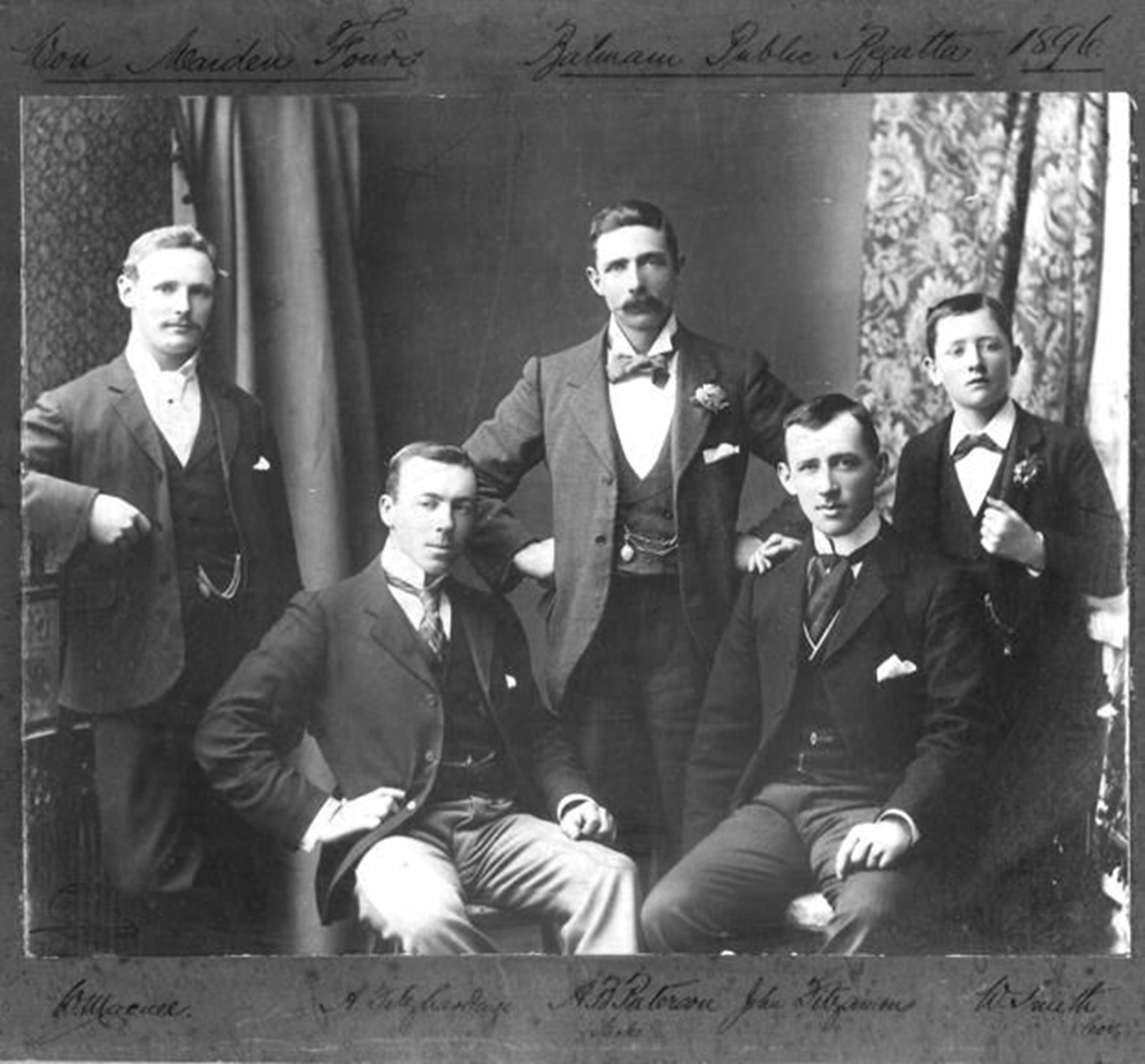
Winners
B.R.C. - W MacNee, A Fitzhardinge, A B "Banjo" Patterson (stroke), J Fitzsimons, W Smith (cox)
Arthur married Florence Madeline Goss in South Africa. She was the daughter of an English colonel and twins, a boy, Arthur John Berkeley, and a girl, Annie Gertrude Madeline Berkeley (Nancy)- were born to them in 1905. There was joy in the family at the news of the twins' birth and then shock and horror when they heard that Florence had died.
Arthur met a civil engineer from Sydney in South Africa, Richard (Dick) Cliff. At the end of the war they contracted with the South African Government to electrify part of the railway system. Both were said to be very knowledgeable about the subject. When the contract had been completed Arthur brought the twins home accompanied by his late wife's sister, Adelaide Arantes Goss, known as 'Ronty', who was engaged to Dick Cliff, Arthur's partner in the railway electrification project. Ronty looked after the twins in South Africa and on the voyage to Australia. She stayed at 'Keba' for quite a lengthy period. Arthur found that he had no job to go to and was in fact unqualified to practise engineering which would have been his first choice or anything else. One source suggests that he had been articled to his father before enlisting. In any case he became articled to a solicitor in Condobolin and was given permission by the Solicitors Admission Board to complete four years' studies in one year. He passed all the necessary examinations and bought a practice in Gilgandra. Arthur met his second wife, Rebecca (Becky) Barden at Gilgandra and soon after their marriage the twins of the first marriage, John and Nancy, who had been cared for by their grandparents since arriving in Australia, joined them in Gilgandra. This did not prove to be a happy arrangement and the twins were shuffled back and forth between parent and step-parent and grandparents, and finally to boarding school. A son Stuart was born to Arthur and Becky in 1915, but died after a fall from a tree in 1931.
Family legend has it that Arthur was one of the instigators of the famous Coo-ee March from Gilgandra to Sydney during World War I. A number of volunteers from Gilgandra marched to Sydney gathering other volunteers as they went to enlist en masse on arrival in Sydney. Arthur was there to meet them; as an organiser he had gone by train and had already been enlisted from the Reserve of Officers. Becky moved to a house in Chatswood for the duration. Arthur was to serve in North Africa and France.
On his return to Australia, Arthur bought a law practice in Kyogle. Two more children were born: Dorothea Berkeley (b.1919) and Ian Berkeley who was born and died in infancy in July 1920. Arthur was not a well man and spent as much time as he could fishing at Evans Head. Throughout his life he maintained his interest in engineering: on one occasion he completely overhauled the local printing press at Gilgandra and restored it so well that it functioned efficiently for many years.
Arthur died in 1922 from stomach cancer. He was remembered by his family as a quiet, gentle person, an avid reader. The twins who had been born to Arthur and his wife, the former Florence Madeline Goss in South Africa, flourished when brought to Australia by their mother's sister. They lived with their grandparents at 'Keba', Louisa Road, Balmain. The girl Nancy in particular took to the water and boats at a very early age. She said, "I can always remember sailing as a youngster. M.A.H., my grandfather, and Judge Fitzhardinge always took me out with them. They loved the water and I suppose I learnt to love it from being with them so often. When I was older I raced with 'Seppy' Stephens in the Sydney Amateurs and that made me keener than ever about sailing very soon I obtained a cadet dinghy which is a twelve with a
restricted sail area and small light gear and therefore particularly suitable for me.
Dorothea Berkely Fitzhardinge, the surviving child of Arthur and his second wife, Rebecca Barden, married Normand MacLaurin and had four children: Margaret Normand (b.1943); Michael Norman (b.1947); Hugh Ian (b.1950) and Andrew Donald (b.1954). The MacLaurins are descended from Sir Normand MacLaurin who was at one time Chancellor of Sydney University and who was himself descended from Isaac Nathan, generally regarded as Australia's first composer.
The Four Daughters of James Devlin
Maurice and Rebecca Fitzhardinge were married in 1874 at Wagga Wagga, N.S.W. Marriage Cert:4056/1874 and had 6 children. Arthur Frederick Fitzhardinge born 1875 at Balmain, N.S.W. Birth Cert:4785/1875 and died 1922 in Sydney, N.S.W. Death Cert:14570/1922. Leslie D Fitzhardinge born 1876 at Balmain, N.S.W. Birth Cert:3658/1876 and died 1882 at Balmain, N.S.W. Death Cert:2538/1882. Garnet M Fitzhardinge born 1883 at Balmain, N.S.W. Birth Cert:3895/1883. and died in 1884 at Balmain, N.S.W. Death Cert:2599/1884. Dorothy C Fitzhardinge born 1885 at Balmain, N.S.W. Birth Cert:4022/1885. Hardinge Clarence Fitzhardinge born 1878 at Balmain, N.S.W. Birth Cert:3743/1878. Margarie R Fitzhardinge born 1889 at Balmain, N.S.W. Birth Cert:4377/1889.
Sep 1922. Sydney, New South Wales, Australia
Arthur was appointed to Australian Army Legal Division 3 weeks before his death - Justice in Arms: Military Lawyers in The Australian Army’s First Hundred Years
Wednesday 25th October 1922.
The Sydney Morning Herald.
DEATH OF MR A.F.FITZARDINGE. Mr Arthur Frederick Fitzhardinge died yesterday after a brief illness. He practiced at Gilgandra and Kyogle for a number of years as a solicitor. The eldest son of Mr and Mrs M.A.H. Fitzhardinge of "Keba" Louise Road, Balmain, the deceased was educated at the Sydney High School, and soon after completing his studies was articled to his father. His professional studies almost completed he responded to the call to South Africa, and was one of the Bushman's Contingent. He was then Commissioned first Lieutenant of the Lancashire Fusillers, and at the conclusion of the War resigned and returned home, where he passed all subjects at the same time. subsequently he practiced at Gilgandra. He went to the Great War with the Carmichael's Thousand with the rank of Captain and his three year were terminated when he was badly gassed in France and had to be invalided home. Mr Fitzhardinge was 47 years of age, and is survived by his widow and four children, two of whom are the issue of a previous marriage.
Our Kyogle correspondent writes:—
Arthur is buried at the South Head Cemetery

Arthur Frederick Fitzhardinge (1875-1922)
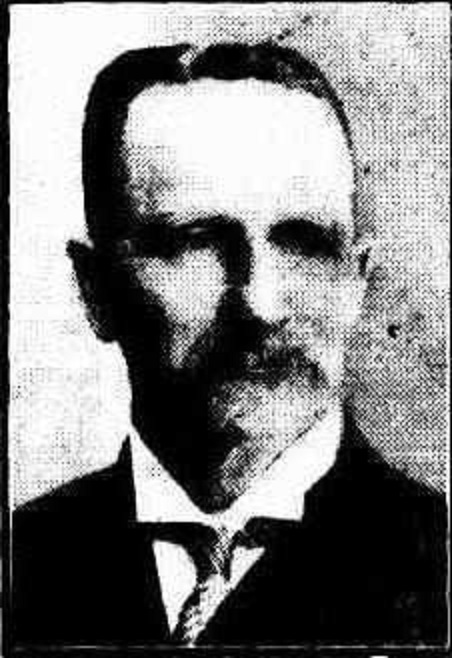
Maurice Arthur Hyde Fitzhardinge. (1849-1935)

Rebecca Annie Fitzhardinge. nee: Devlin. (1846-1936)
Grantley Hyde Fitzhardinge (1845–1939)
Judge Fitzhardinge, of the District Court Bench and who for many years had been living in retirement, died yesterday at his home at Pennant Hills. He was in his 94th year. Grantley Hyde Fitzhardinge was the fourth son of William George Augustus Fitzhardinge, and was born at Waverley in November, 1845. Educated at St Philip's Grammar School, St James's Grammar School, and Sydney Grammar School, he graduated at the Sydney University in 1867, and obtained the degree of MA in 1889. He was called to the Bar in 1868. He was appointed a District Court Judge in 1890, and resigned in 1918. From time to time he acted as a Judge of the Supreme Court. Even in the eventide of his life there was clearly discernible in him something of the once sturdy physique that stood to him in the days when as Crown Prosecutor, and later as Judge, he either rode on horseback or drove in a sulky on outback circuit.
Recalling legal memories. Judge Fitzhardinge would speak of the occasion when the hearing of an important case before the Court was adjourned because of the sudden illness of Mr Edward Butler, then one of the leaders of the Bar. On his return to Court at a later date, Mr Butler was congratulated by the then Chief Justice (Sir James Martin) on his recovery. Mr Butler then explained to the Court that it was against his doctor’s orders that he had resumed practice, but that he had done so in the interests of his client. With that, Mr Butler fell forward on the table Judge (then Mr Fitzhardinge with others, went to his assistance, but he was beyond aid. Turning to life's lighter side, Judge Fitzhardinge recalls the eventful day when, on circuit at Walgett in his judicial capacity, there was an extraordinarily heavy list of cases. The Court officials informed the Judge that it would be impossible to provide light if he sat after the usual adjournment hour. The Judge decided to find a way out of the difficulty, and the Court sat at night under the fitful light of candles stuck in the necks of beer bottles.
The Judge would recall the days when he had either to ride, with a pack horse behind, or drive a sulky to keep his circuit engagements over long stretches of primitive country. On one occasion, after an eventful journey, he took his seat in Court in his riding breeches at 10 a.m. to open the Court. He then adjourned proceedings for about half an hour so that he could have a "brush up." On another occasion, in an endeavour to open the Court at Wilcannia on a specified day, he had, in his capacity as Judge, to travel down the river to Morgan, about 400 miles away; then take train to Adelaide: proceed by train from Adelaide to Broken Hill, and, finally, go by coach from Broken Hill to Wilcannia. The Judge was a day late, after all, but he had taken the precaution to advise the Crown law authorities of the possibility of his being behind time. The department thereupon issued a fresh proclamation, synchronising the sitting of the Court with the date of his arrival in Wilcannia. As a young man he reported law cases and rowing and sailing races for the Herald, and contributed a weekly article on yachting to the Sydney Mail. In 1876 he married Julia, fourth daughter of John Yeomans, a pioneer farmer on the Hawkesbury, but she predeceased him several years ago.
The funeral will take place at 3 p.m. to-day at the Northern Suburbs Crematorium.
Military Records

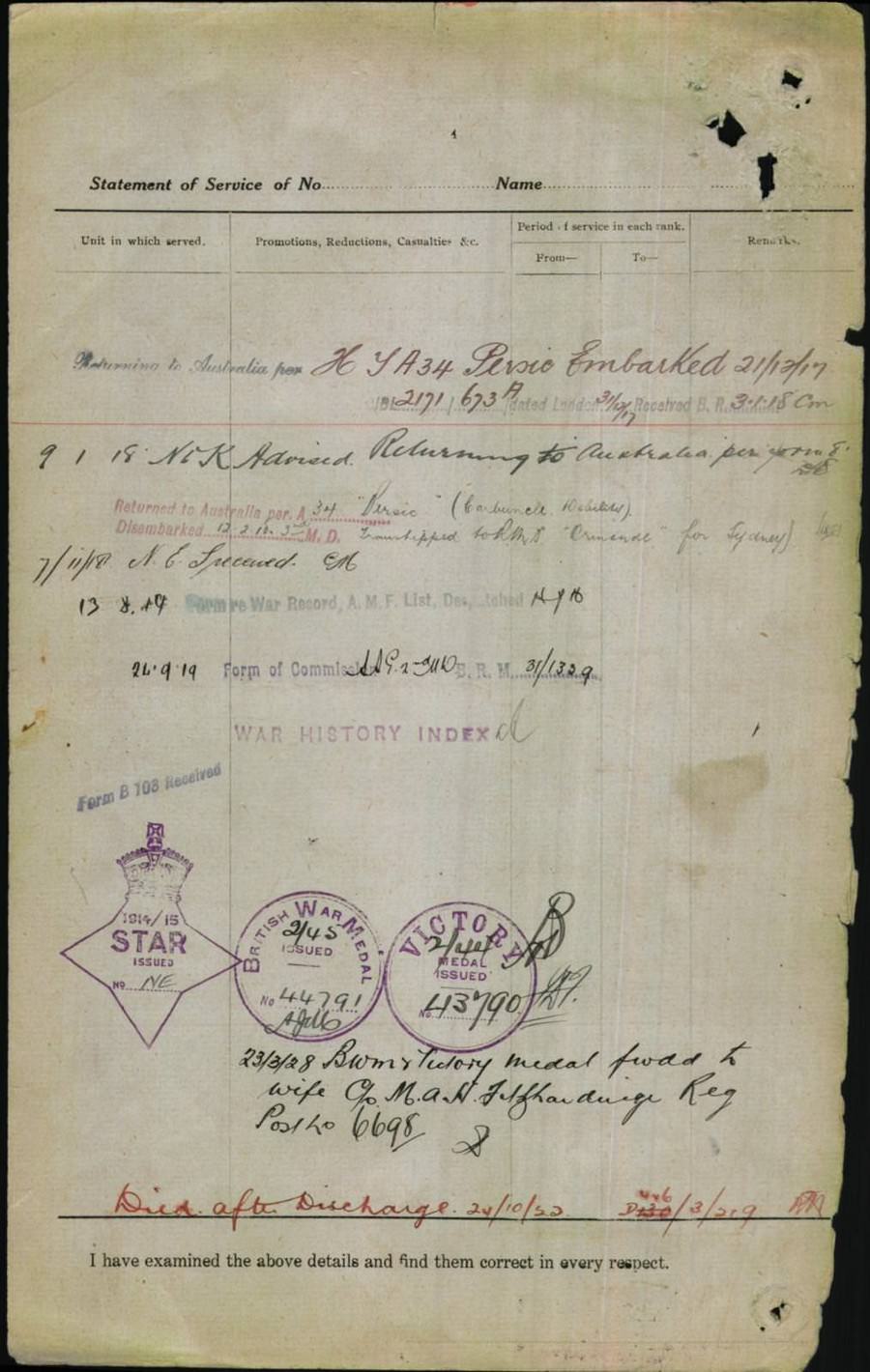
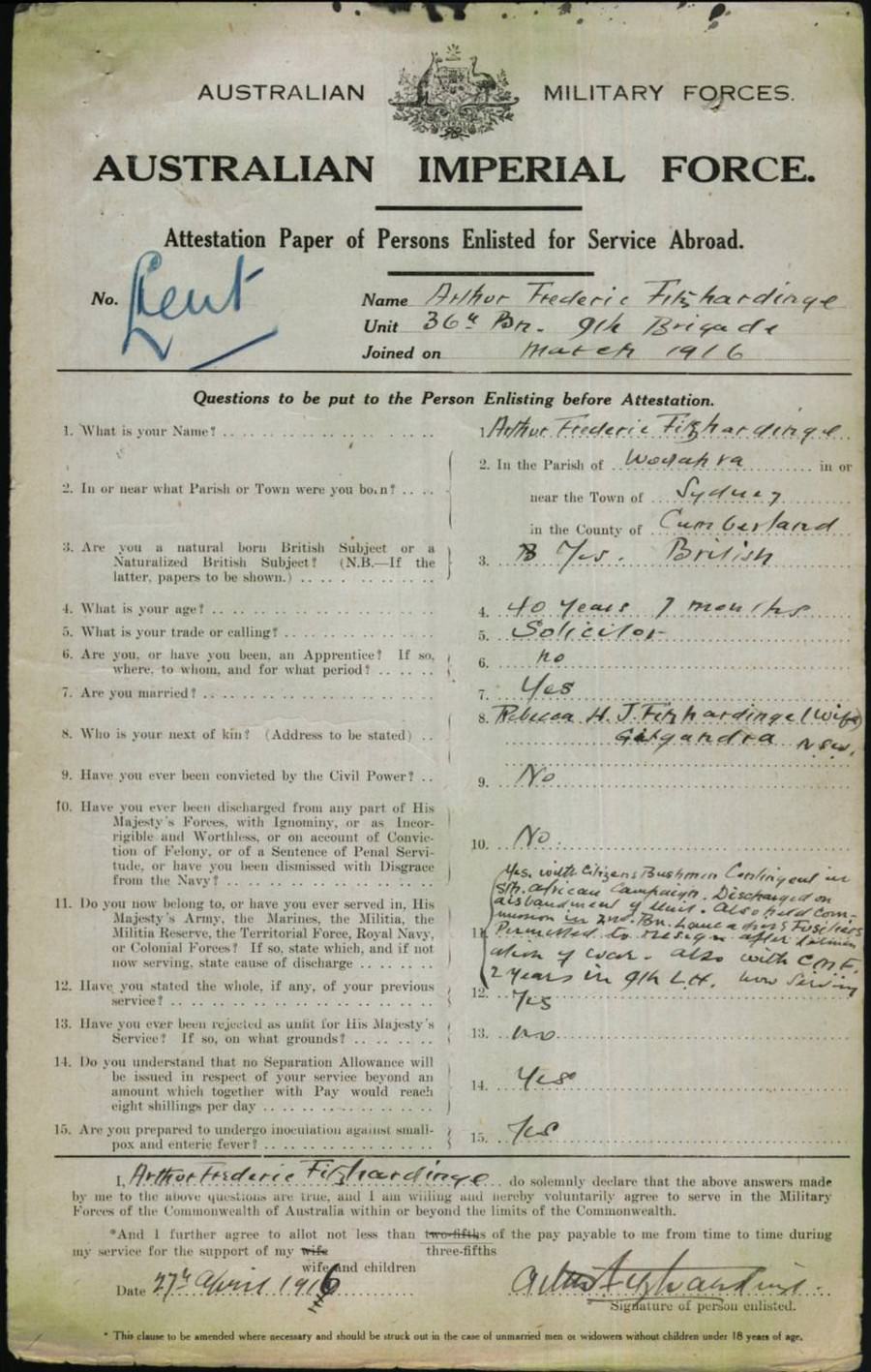
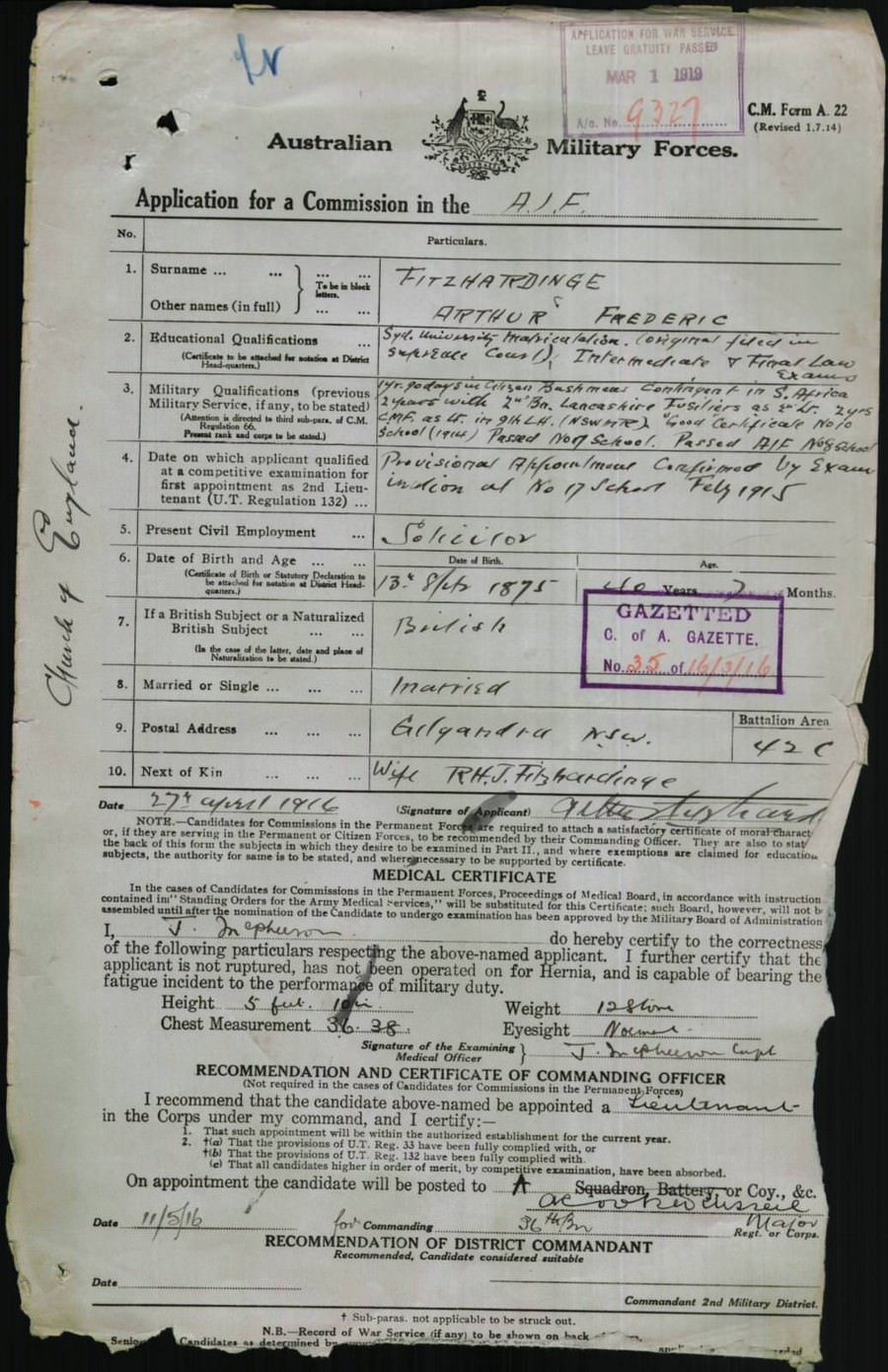
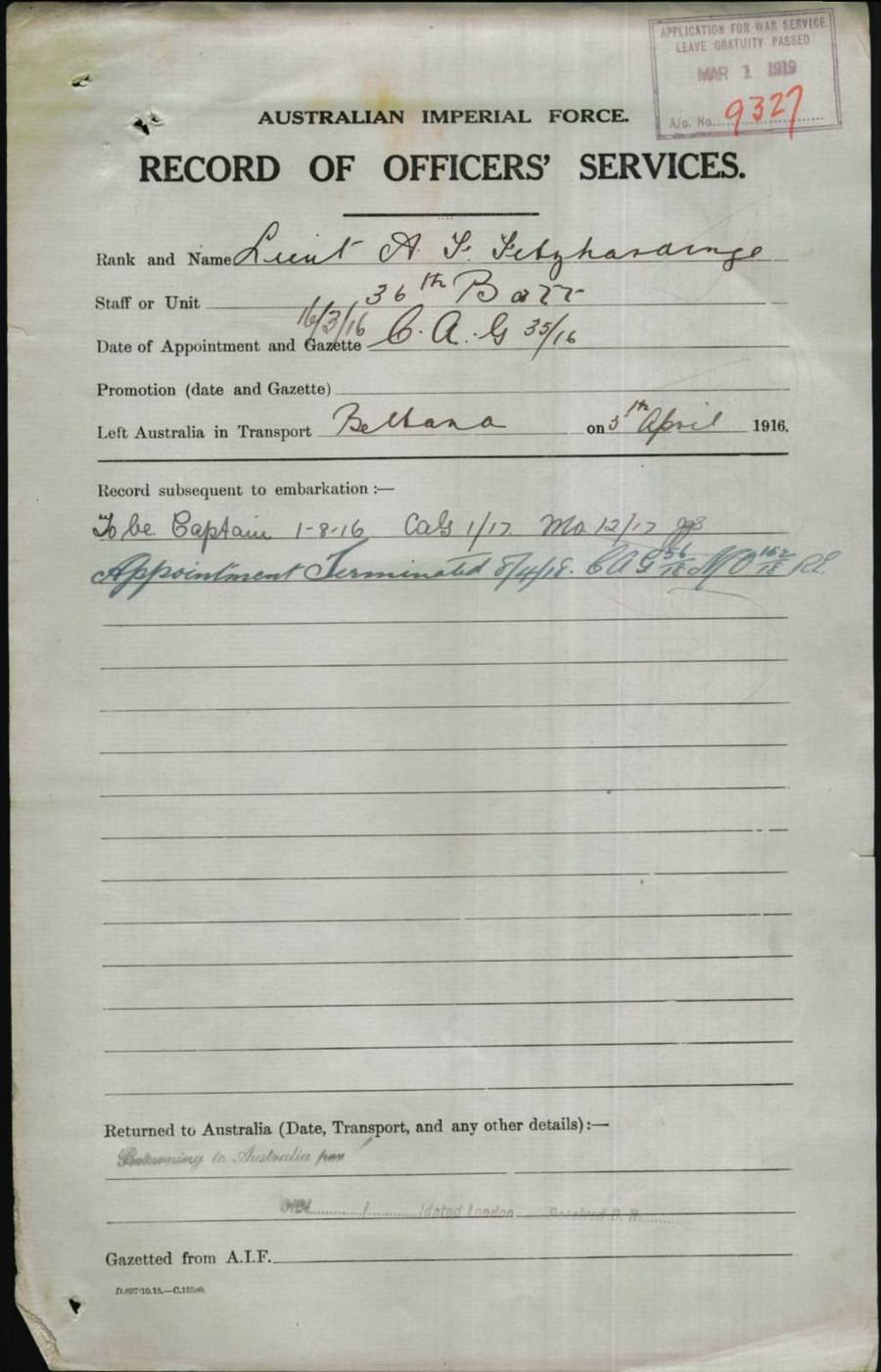

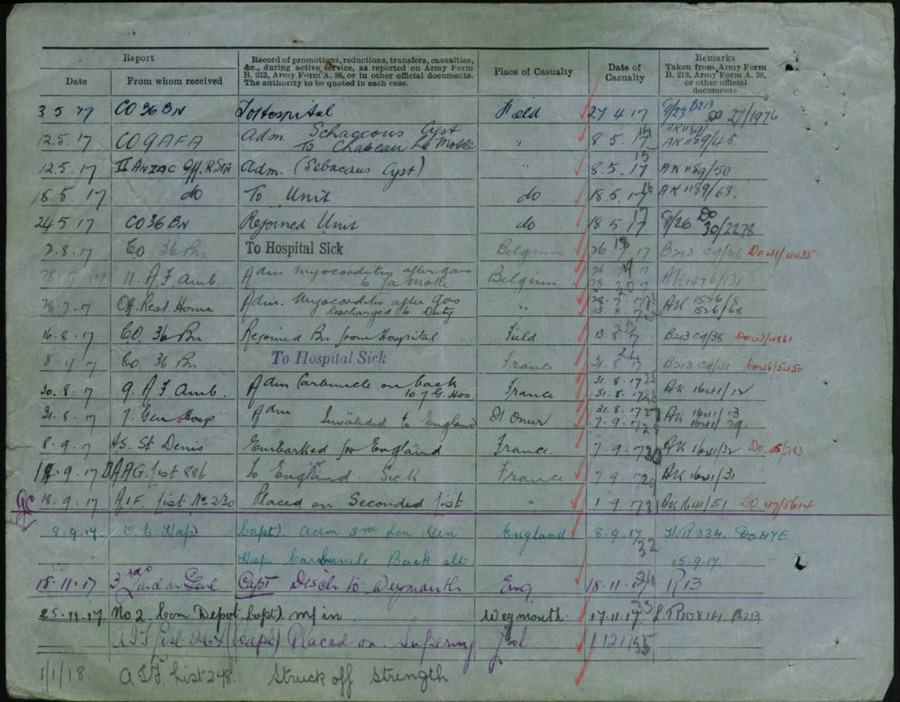
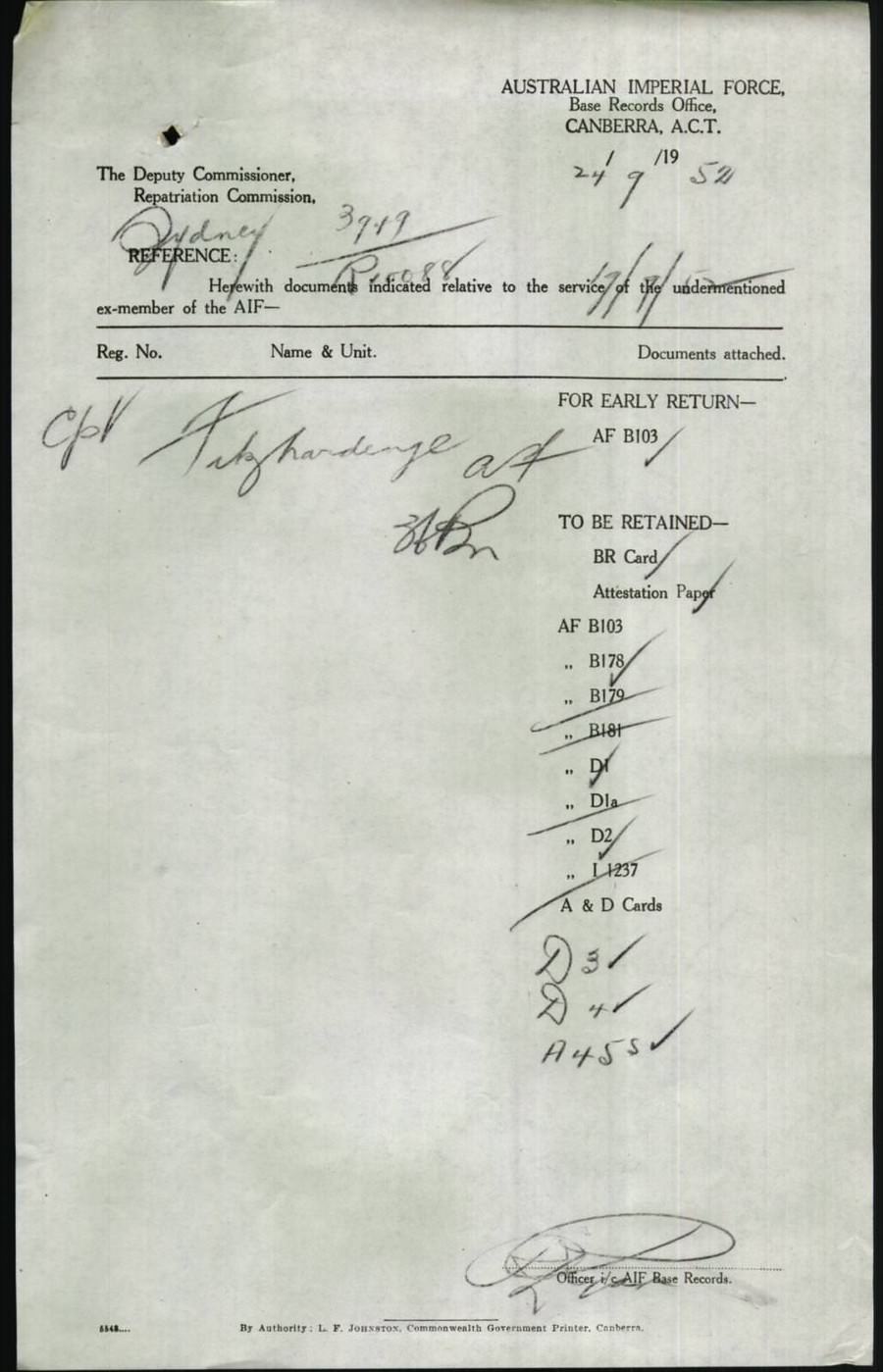
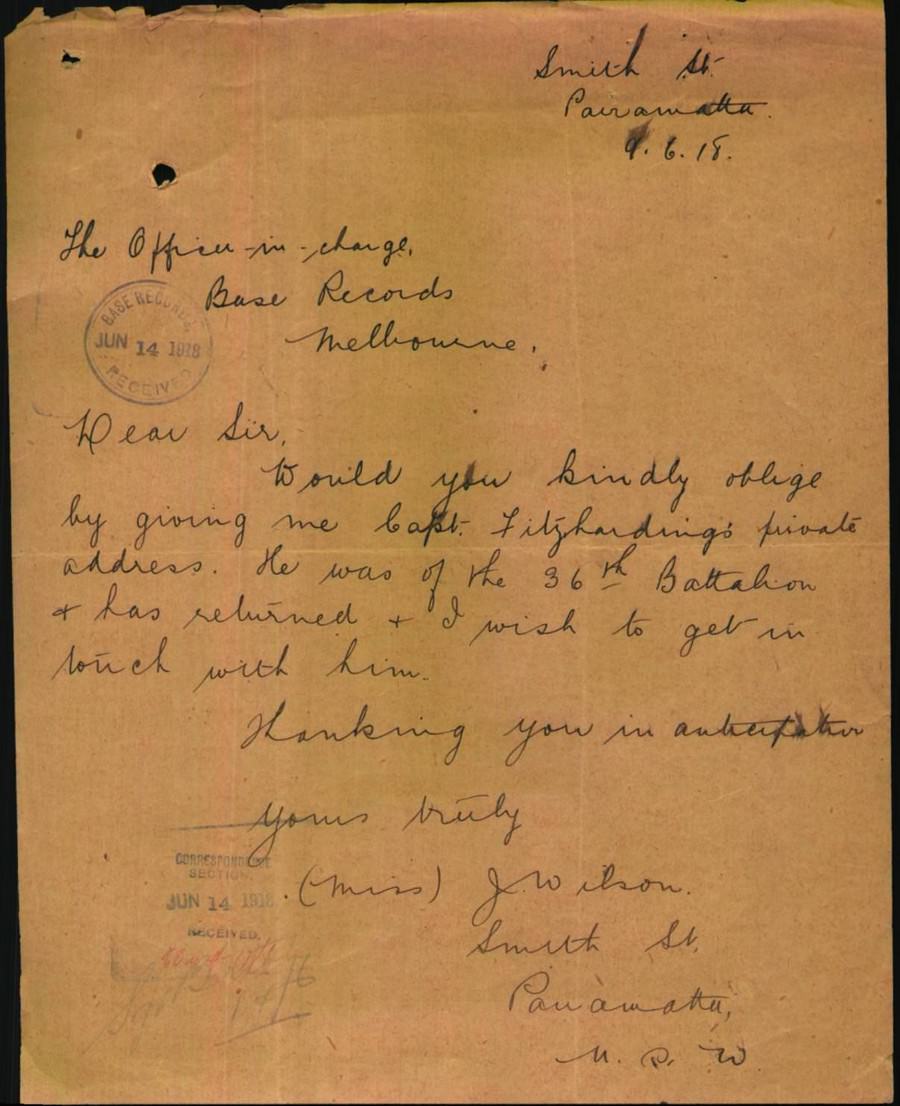
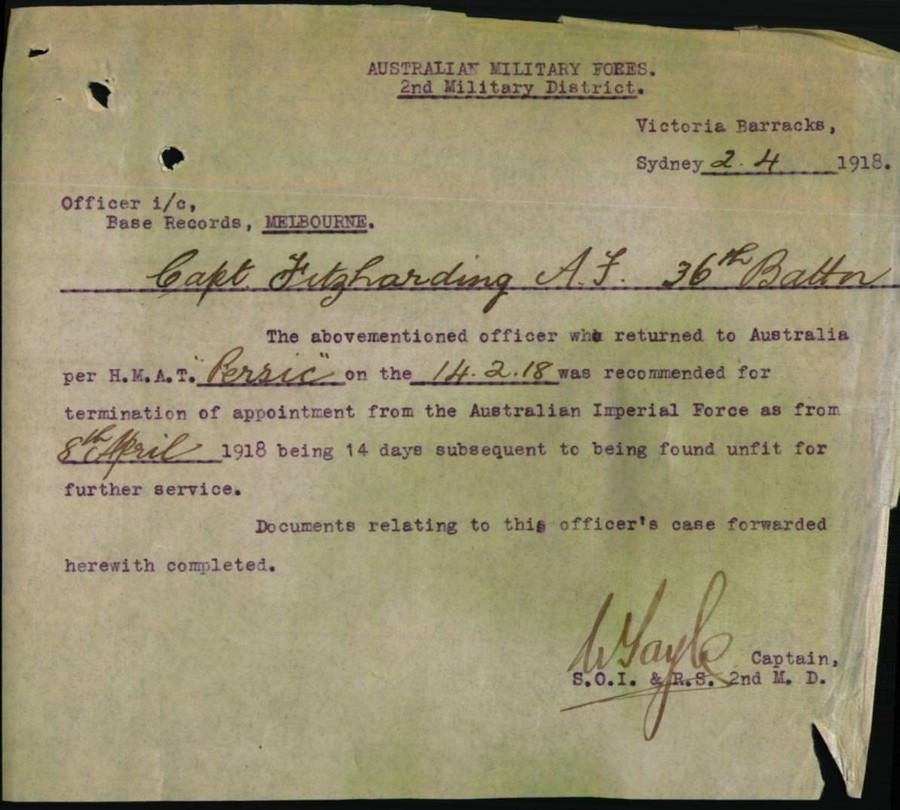



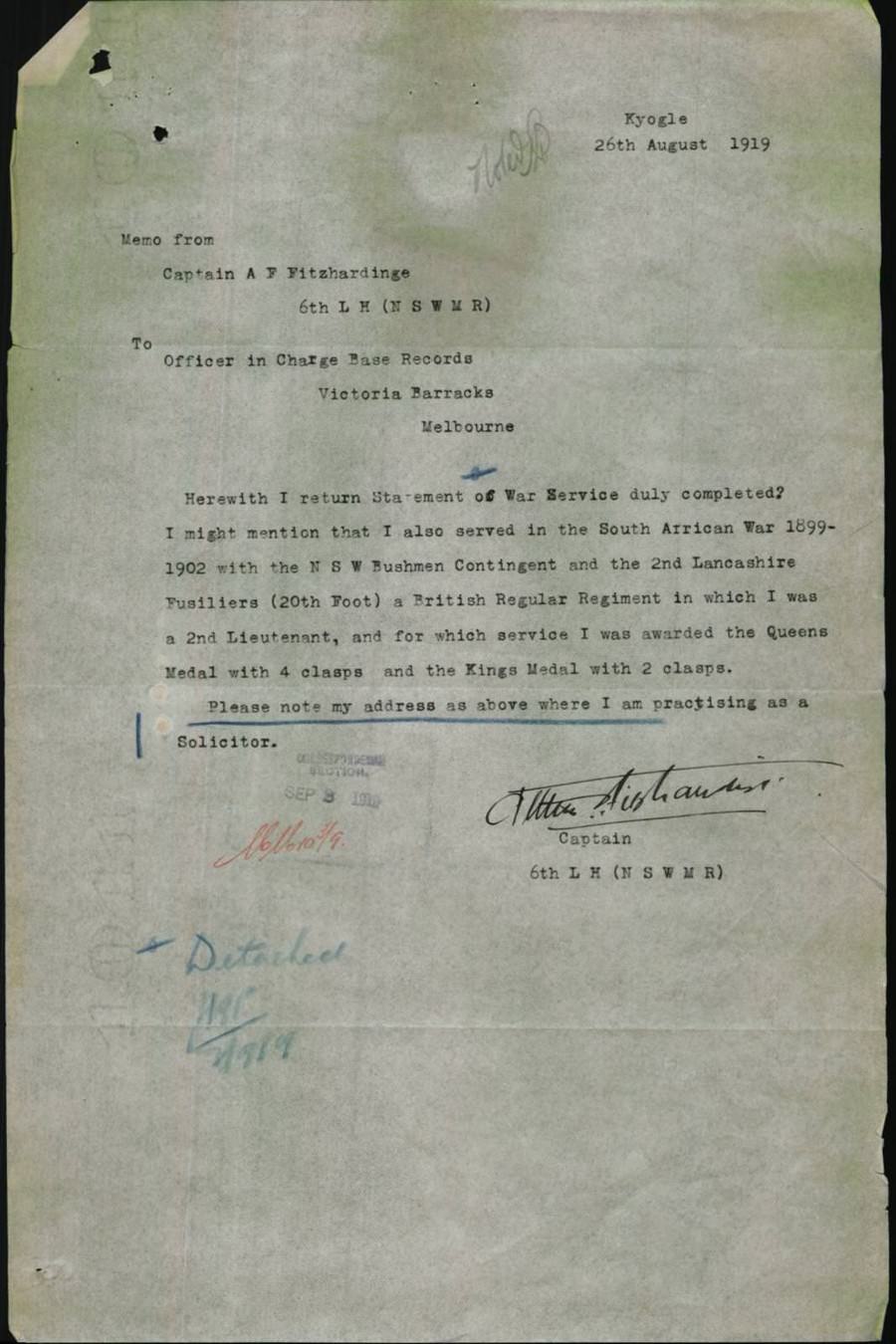


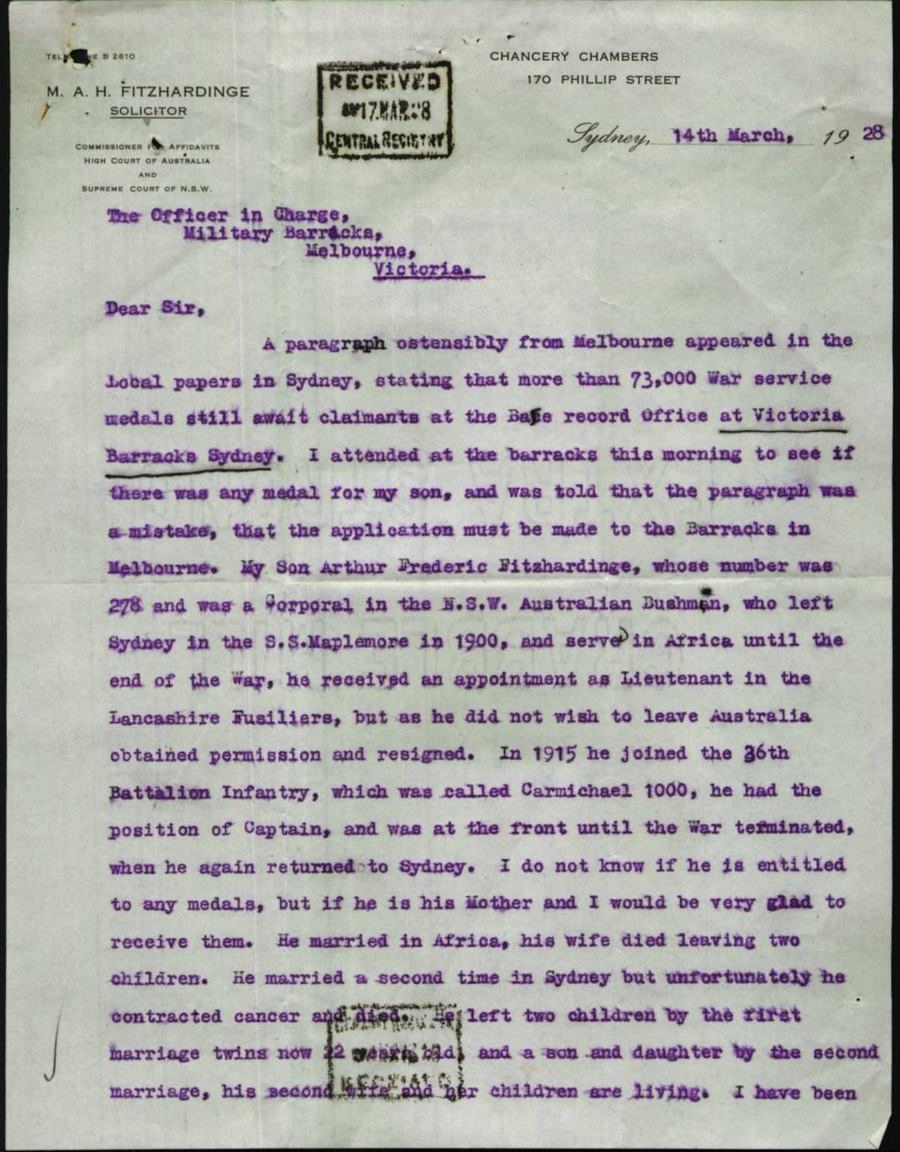
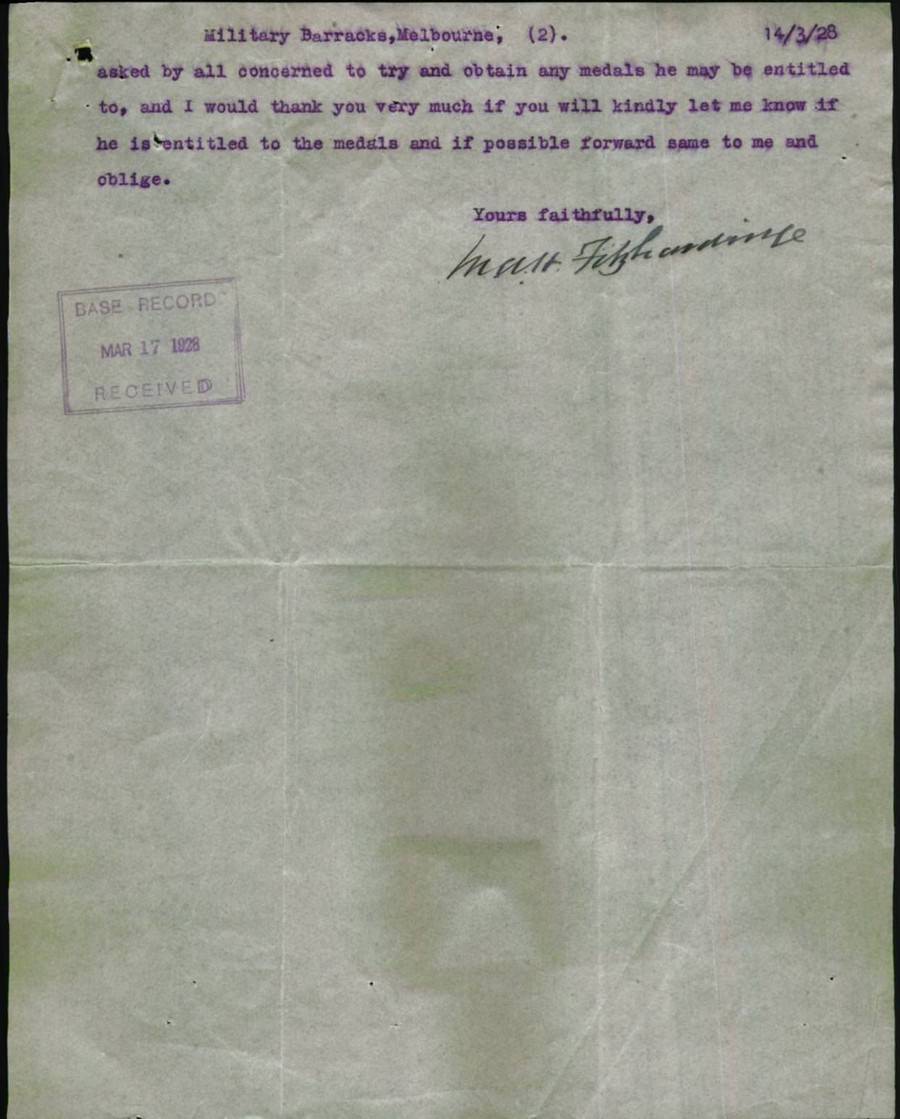
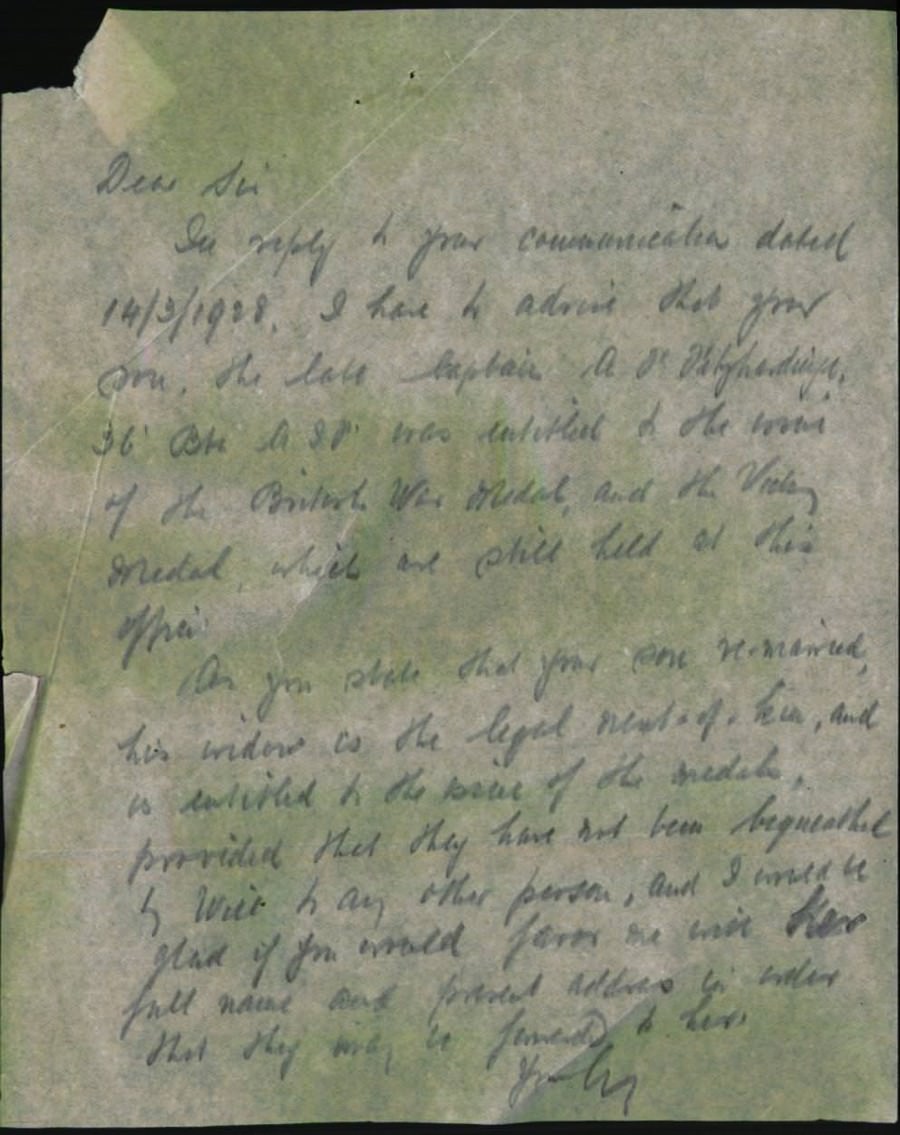
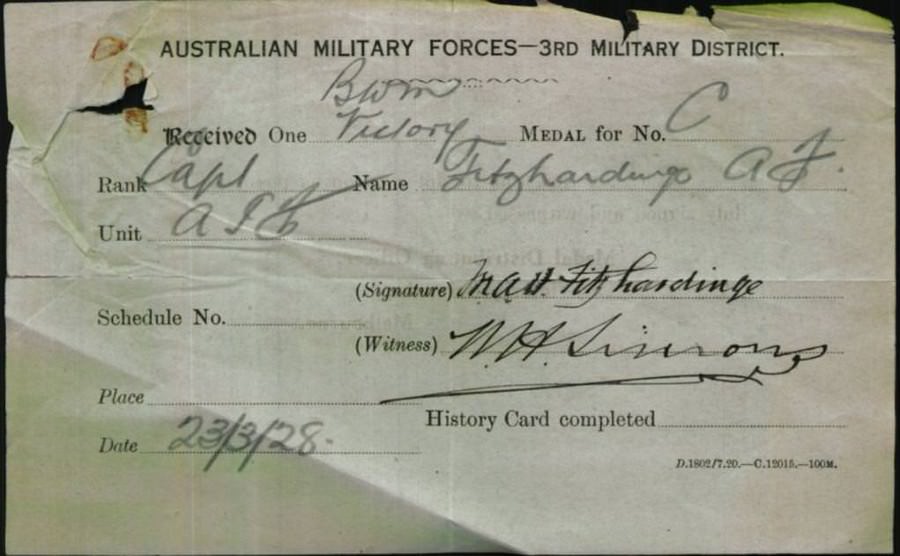
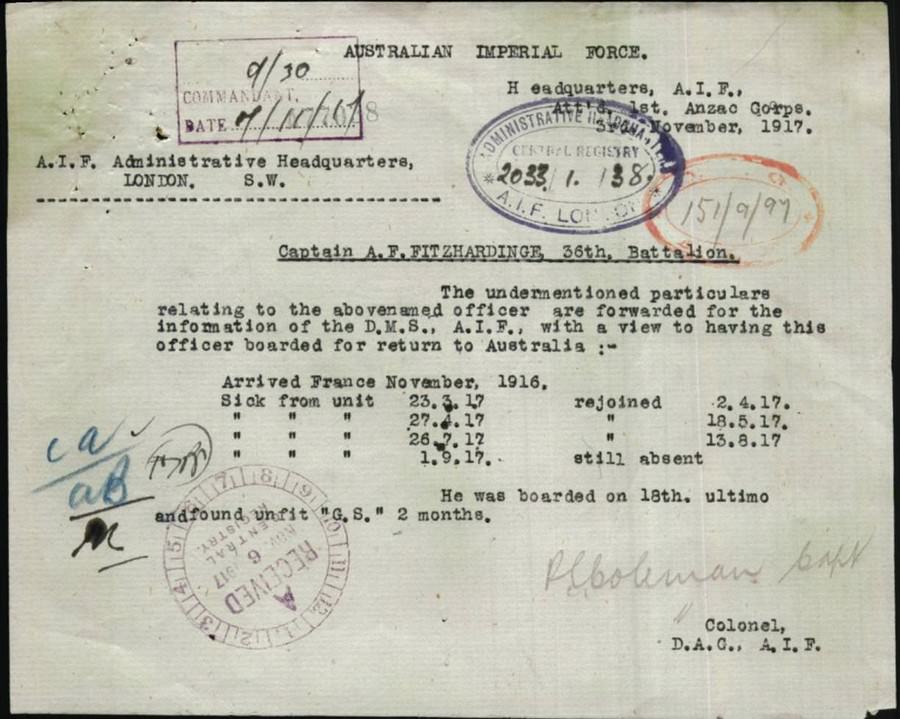
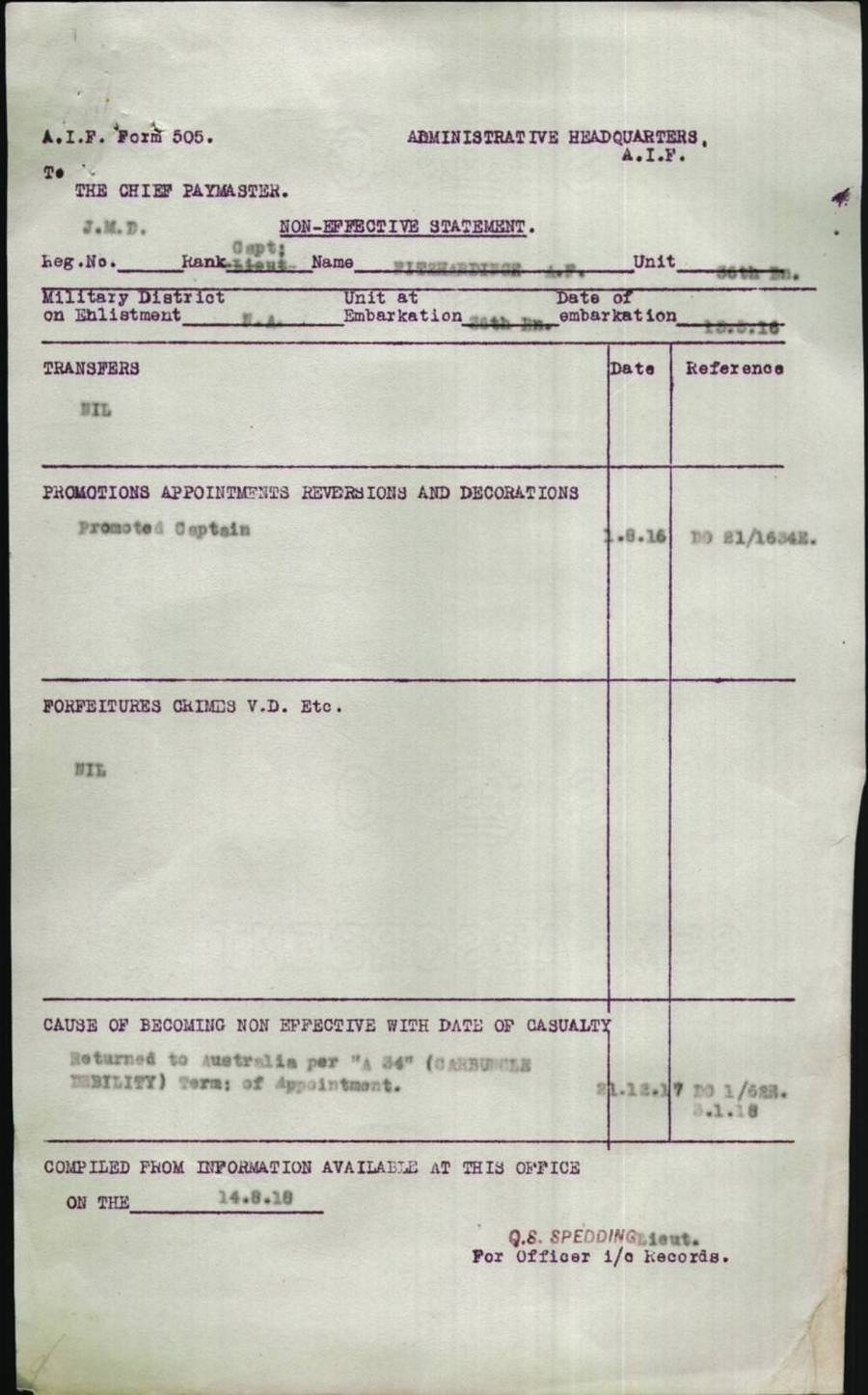
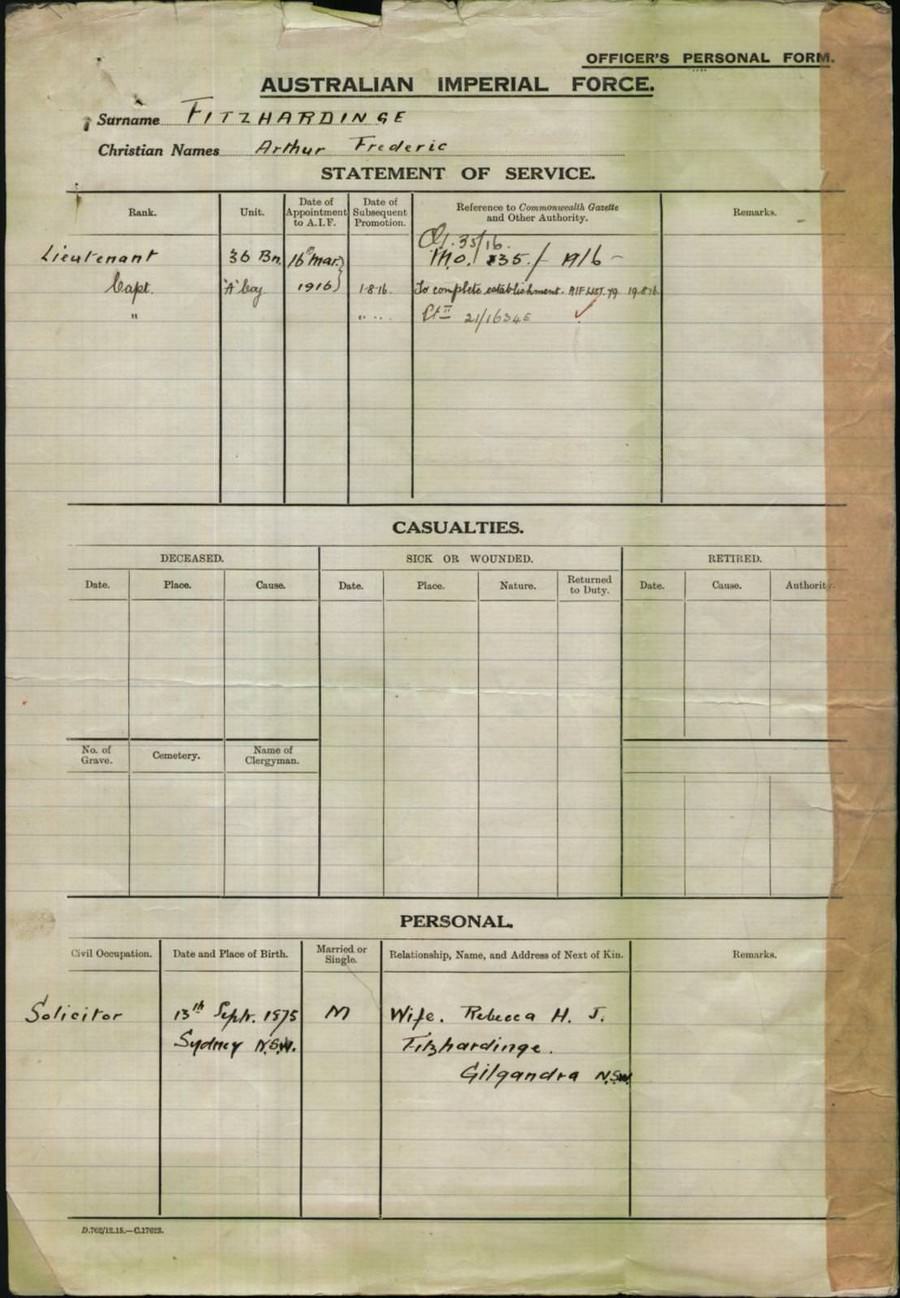
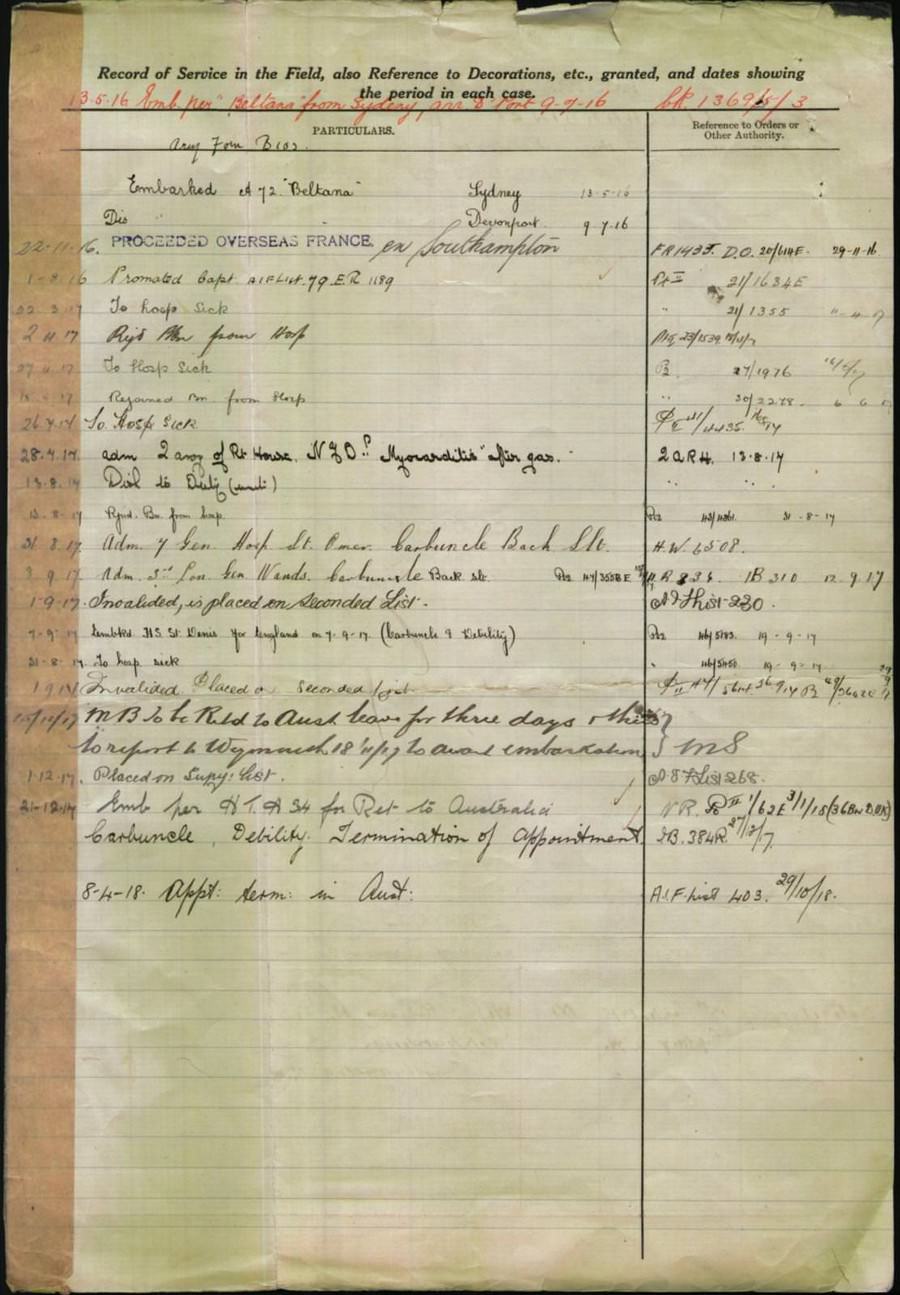
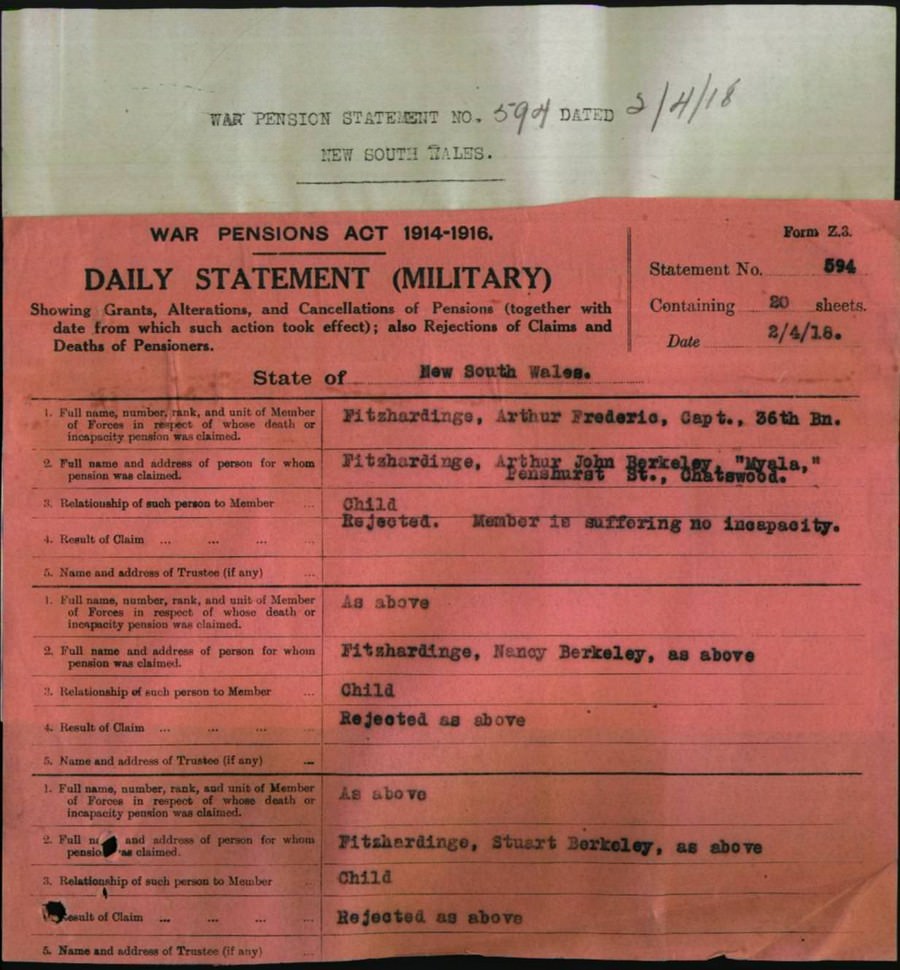
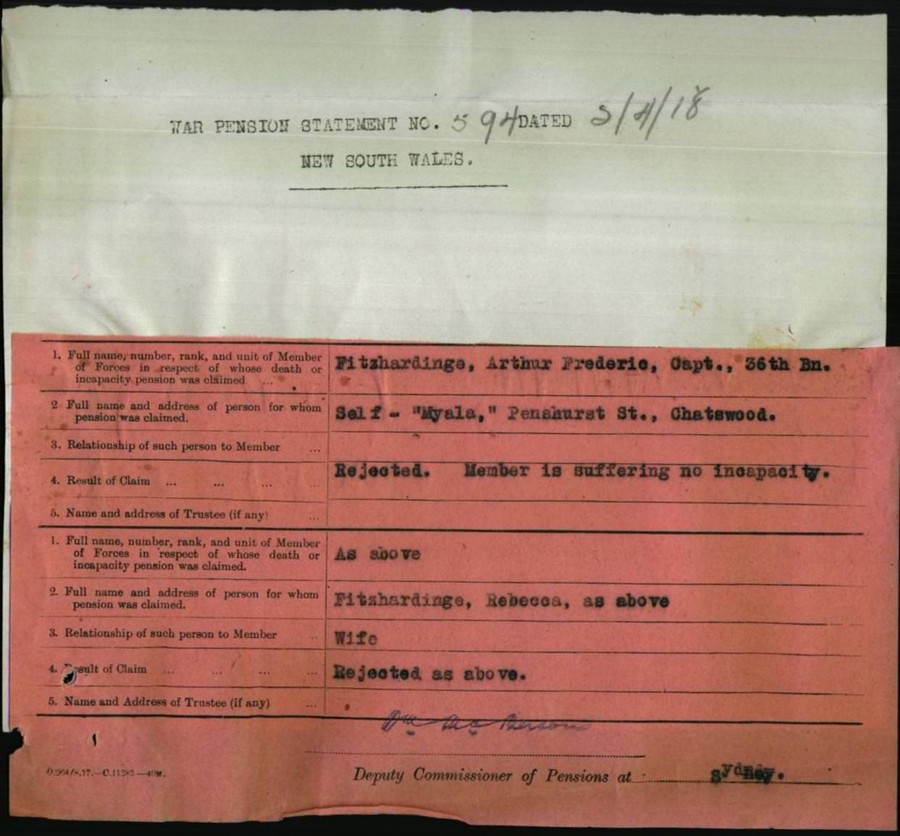


© Commonwealth of Australia (National Archives of Australia)
Under Construction 25/05/2010-12/10/2023.
Private: 66 George W FORREST.

34th BATTALION A.I.F.
Private: 66 George W FORREST.
Born: 1857. Tyrone, Ulster, Ireland.
Married: 7th March 1896. Randwick, New South Wales, Australia. Marriage Cert:3753/1896.
Wife: Mary A Forrest. nee: Ball. (18..-1898) Waveley, N.S.W. Death Cert:16507/1898.
Died: 7th June 1917. Killed in Action Messines.
Father:
Mother: nee:.



South African War.
In 1899, when the South African war commenced, all the Colonies in Australia offered military assistance to England. These offers were accepted in that the Colonies were requested to send mounted infantry or light horse only. After the action at Magersfontain, New South Wales offered to send a battery of Artillery to South Africa. This offer was accepted and immediately A Battery Royal Australian Artillery was formed from Officers and Men of A Battery New South Wales Artillery, and on 30th December 1899 on the transport to Warrigal, the Battery embarked from Sydney to South Africa. A Battery having completed about 18 months of continuous active service, was order home in July 1901. The Battery embarked at Cape Town on the transport Harlech Castle on the 12 August 1901 and arrived in Sydney on the 15th September 1901. During its service in South Africa, A Battery had one man killed in action, one man died after being kicked by a horse, while 45 men were invalided home through sickness. On the 1st December 1910 A Instruction Cadre was redesignated as No 1 Battery Australian Field Artillery Permanent).
Original strength: 175 and six guns, followed by 44 reinforcements. Subunits: three field artillery sections of two guns each. Commanding officers: Colonel S. C. U. Smith, then Major E. A. Antill. Left for South Africa: 30 December 1899 on Warrigal, A detachment of 1 officer 1 NCO and 10 ORs commanded by Lt (T/Capt) A Fitzpatrick RAA departed on the Langton Grange on 14 Nov 1899 Newcastle. A reinforcement draught of one officer and 43 ORs departed on the Maplemore 17th March 1901 under command of Lt R G King. Service: February 1900 - August 1901 in Cape Colony and Transvaal; the only professional Australian military unit to serve in South Africa. Fatal casualties: one killed, two died of disease. Decorations: none. Returned to Australia: 15 September 1901 on Harlech Castle.
Sources: reports by Smith and material gathered for battery history (Australian War Memorial, AWM1 4/2 and MSS1261), Cubis History of ‘A’ Battery (1978)

George enlisted at Newcastle with A Company 34th Battalion AIF on the 19th January 1916 and was marched in to the Rutherford Recruitment and Training Camp where strenuous training was carried out. The men were very keen and fit, whilst their comfort and health were made a special study. Food was good and ample and sports and recreation were not overlooked.
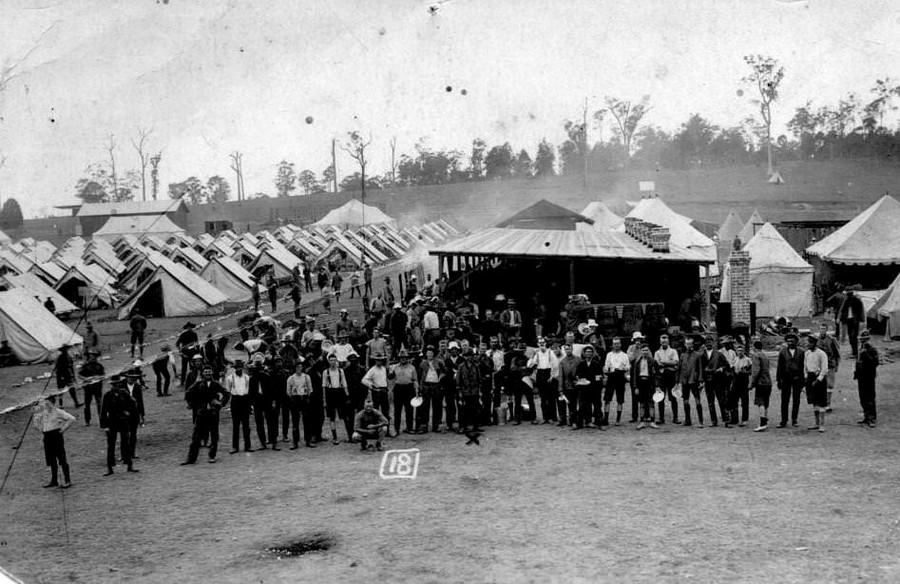

The following morning the Battalion moved to Le Harve Railway Station, leaving D Company behind. On arrival at the Station en training commenced at 8:00 am and the train left at 11:15 am. The journey was slow and occupied until 4:30 pm on the 24th. On arrival at Bailleul the men de trained and marched to Outtersteene. D Company arrived at 4:00 pm the following day. The Battalion rested here in billets for two days previous to taking over garrison duties in the Line at Armenties. The Commanding Officer Lieutenant Colonel. Malcolm St John LAMB. with the Adjutant, Company Commanders, N.C.O's and Specialists went into the Line to inspect Trenches, Stores, Plans and to arrange for the taking over this Section of the line on the following day.
The specialists and N.C.O's remained in the Line. On 27th November the Battalion went into the Line in the L'Epinette Sector. The men were taken up by motor lorries as far as the Square near Houplines Station, and marched via Butterne Avenue and Willow Walk to the Line, carrying their packs and blankets into the trenches. Lewis Gun ammunition was taken into the Line with the tin cases. The going was difficult owing to the conditions of the Trenches and the heavy and bulky loads. Later the blankets were dumped near Tussage Dump, from which most of them disappeared. This was the main incident of our relief in the Line.
George reported to Hospital on the 10th March 1917 suffering from Diarrhea after treatment was received from the 11th Australian Field Ambulance he was sent to the Divisional Rest Station before he was marched in the the Reinforcements Camp. George was marched out and rejoined his unit on the 28th of March before moving into the Forward Lines.
17th May 1917.
On the 17th of May the Germans tried to raid the 34th Battalion at Le Touquet. The enemy this time employed the British method of a very short, though heavy, preliminary bombardment. The preliminary registration however had been observed and the Australian counter-barrage came down within 10 seconds of the S.O.S signal fired by Lieutenant: 4559 Frederick Murchison WAUGH. M.C. 34th Battalion. A party of Bavarians attempted to enter by a gap in the front line. One climbed the parapet and said "Hands Oop!" He was at once shot, and fell dead into the trench. Lewis Guns, in particular that of Private: 1416 Joseph Edward KIRK. M.M 34th Battalion, drove the enemy off.
On the 18th of May the previous night's attempt against the 34th Battalion was repeated after a short heave bombardment. On the S.O.S. being fired by Lieutenant: 1118 William Wright EDMONDS. M.C. 34th Battalion, the protecting barrage again came down instantly, but the enemy entered a gap near a sector in which cylinders had been installed for an impending release of gas. Working alone the line, they bombed a Lewis Gun Team, wounding three. The remaining men, Lance Corporal: 1530 James HAM D.C.M. 34th Battalion and Private 1248 Bertram Guy TAYLOR M.M. 34th Battalion, continued to fire, and killed all five intruders.
Lieutenant: Benjamin Greenup BRODIE and the scouts afterwards went out, driving back the German covering party and stretcher-bearers, brought in a wounded Baverian Pioneer, and evidence and identification from 11 Germans who had been killed.
( History of World War 1. Vol IV. Bean) Charles Edwin Woodrow BEAN
7th June 1917.
Major General Sir John MONASH's 3rd Division had to contend with a tricky 3 mile approach out of Ploegsteert Wood and after the German gas attack, but they were not deterred. The 9th Infantry Brigade under Brigadier General: Alexander JOBSON and the 10th Infantry Brigade under Brigadier General W R NICHOLL had just made the jumping off point but some of the men did not stop, going straight into the assault from the approach march.
Their objective lay between St Yves and the Douve. The mines at Trench 127 and Trench 12 at Factory Farm were laid to aid this task. The explosions erupted a few seconds before zero hour and created craters of 200 feet in diameter, completely obliterating the German defense line as the 9th and 10th Infantry Brigades went over the top. The mine crates forced the 9th and 10th Brigades to veer to the left and right which caused some confusion with the main assault. It is testimony to the quality of training that every man knew the ground, tasks and objectives so well.
Private: 1804 John CARROLL 33rd Battalion, rushed the enemy's trench and bayoneted four of the German occupants. He then noticed a comrade in difficulties and went to his assistance, killing another German. He then attacked single handed a German Machine Gun Team, killing all three of them and capturing the gun. He later rescued two of his comrades who had been buried alive by German Shell Fire, and in spite of heavy shelling and machine gun fire he dug them out alive and saved them from certain death. John was awarded the Victoria Cross.
The German forward zone was completely engulfed and taken by the main assault. The two supporting battalions of each brigade then passed the leading battalion to continue the advance. The men were constantly re-supplied and the ridge was taken. There were many German prisoners taken during the offensive. The 3rd Division was well ahead with the 9th Infantry Brigade pushing on beyond Grey Farm, and on the right the 10th Infantry Brigade were veering left towards Septieme Barn north of Douve.
The German resistance was heavy but was generally brushed aside by tanks and artillery before the infantry had to become too involved.The 4th Bavarian Divisions Artillery had made little impact, but as the day wore on the 3rd Division and later the 4th Australian Division received many casualties from German artillery. (70% of all casualties during WW1 were from artillery).
By 9:00 am nearly 6 hours after the assault began the Germans were in disarray, but there was a major problem as the Australians received less casualties as anticipated and when ordered to dig into the ridge they had so many men, that some could not find shelter. the 35th battalion were dug in around Seaforth Farm.
The second phase of the operation was to take the Oosttaverne Line. The 3rd Australian Division would now be in reserve with the 4th Division attacking. The 9th Infantry Brigade (33-34-35-36Bn) were near Thatched Cottage facing Warneton. The river Lys was to their right and the Ploegsteert Wood was now behind them.
Once their objectives were taken the troops consolidated. A barrage to stop and counter attack was shortened and caught three battalions which had to retire. By 9:00 pm this part of the Oosttaverne Line was abandoned. At 10:45 pm General: Alexander GODLEY ordered the 3rd and 4th Divisions to retake it. This they did by the early hours of the 8th of June.
The Battle for Messines Ridge during May-June 1917 saw 35 officers and 1,631 other ranks loose their lives.
| 33rd Battalion. AIF | 8 Officers | 382 Other ranks |
| 34th Battalion. AIF | 10 Officers | 378 Other ranks |
| 35th Battalion. AIF | 5 Officers | 431 Other ranks |
| 36th Battalion. AIF | 9 Officers | 421 Other ranks |
| 9th Machine Gun Company. AIF | 2 Officer | 17 Other ranks |
| 9th Light Trench Mortar Battery. | 1 Officer | 2 Other ranks |

Home Address; Angledool Post Office, N.S.W.
Informant: Captain: William Walter MATTHEWS. Private: George FORREST who was my servant, and a brave good soldier, who had been all through the South African War, was with me in an attack on the Germans, at Messines. We went over together and he was never seen again. I don't believe he was taken prisoner, because we were pursuing them long afterwards, and they were too far away. I feel sure he was blownup in our own big mines. I have a photograph of him.
3rd General Hospital, Wandsworth, London.

George moved to the Glebe Colliery Hotel in Wilton Street, Merewether, N.S.W. No correspondence or financial support was made to his daughter or step daughter whist in the care of his mother in law. His brother in law Private: 1266 Daniel John Alfred WYATT 36th Battalion AIF, met George in Salsbury Plains in 1916 during World War 1 before Daniel returned to Australia.

Private: 2410 Hubert “Herbert” James
TENNANT.
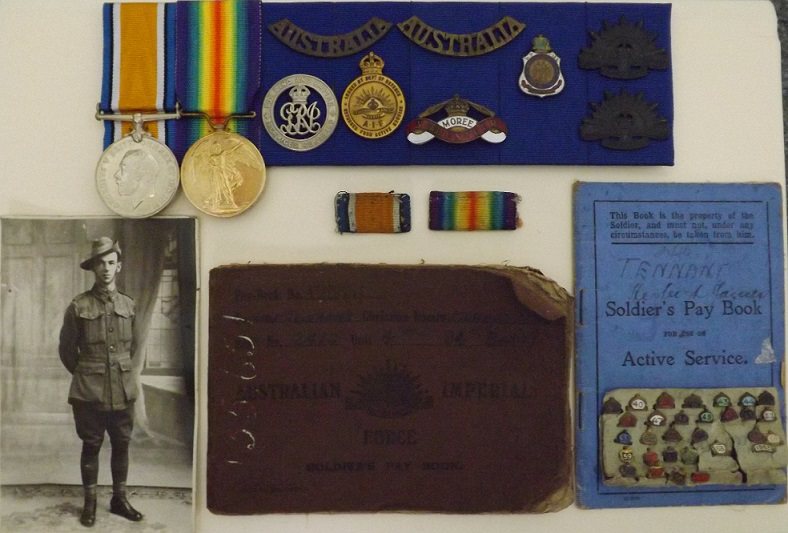
34th BATTALION A.I.F.
Private: 2410 Hubert "Herbert" James TENNANT.
Born: 1897. Gunnedah, New South Wales, Australia. Birth Cert:22168/1897.
Married:
Wife: nee:.
Died:1967. Newcastle, New South Wales, Australia. Death Cert:22580/1967.
Father: Patrick Joseph Tennant. (18..-1961) Died at Newcastle, N.S.W. Death Cert:25453/1961.
Mother: Sarah Lydia Tennant. nee: Ferrier. (1877-28.12.1942) Born at Tamworth, N.S.W. Birth Cert:20981/1877 and died at Mayfield, N.S.W. Death Cert:28027/1942.
INFORMATION
Hubert James Tennant served with the 13th Infantry Militia prior to enlisting at Narrabri, N.S.W. on the 1st June 1916 where he was allocated to the 4th Reinforcements, 34th Battalion AIF. Herbert was en trained to the Rutherford Army Camp where strenuous training was carried out. The men were very keen and fit, whilst their comfort and health were made a special study. Food was good and ample and sports and recreation were not overlooked.

MAITLAND CAMP RUTHERFORD N.S.W. 1916.
On the 16th October 1916 the 4th Reinforcements en trained from Farley Station for Sydney where they embarked on board HMAT A 30 "Borda" from Finger Wharf at Wooloomooloo Bay, Sydney on the 17th of October for England and disembarked at Plymouth on the 9th January 1917. The 4th Reinforcements were marched in to the Durrington Amy Camp at Larkhill with the 9th Training Battalion. Here the Reinforcements settled down to hard training, which included Route Marching, Trench Digging, Bomb Practice, Musketry and General Camp Routine.
Hubert proceeded overseas for France via Folkstone on the 25th April and went into billets before being marched out to the lines where he was Taken on in Strength with the 34th Battalion on the 30th of April.
19th May 1917.
Le TOQUET Runners getting plenty of work, one runner blown to pieces bringing confirmation of S.O.S. enemy came over about 200 strong in 3 waves. Lieutenant: 1118 William Wright EDMONDS. on duty sent up S.O.S. and out artillery barrage came down at once and caught enemy's rear lines. Five Bosche got into our trench but were immediately killed. Our Lewis Guns caught them in NO MANS LAND playing great havoc. Estimated we killed 25 to 30 Bosche and we also took one hundred wounded prisoners. Lieutenant: 1118 William Wright EDMONDS. recommended for M.C. for his work. One Lewis Gun continued firing after being bombed and losing 4 of the team. Lieutenant: 717 Benjamin Greenup BRODIE. scouted NO MANS LAND and found several dead Bosche and various odds and ends he collected altogether abour 12 identifications.
20th May 1917.
Relieved by 36th Battalion and went into Billets at Pont de Nieppe.
21st May 1917.
Enemy shelled Pont de Nieppe, several civilians hurt.
22nd May 1917.
Nothing doing, men having a rest.
23rd May 1917.
9:00 pm. Moved into Billets in Ploegsteert Wood and took over from 37th Battalion. Relief completed at 3:00 am. Our guns have been strafing the Germans all night.
24th-25 May 1917.
Our artillery very active on these two days, various wire cutting shoots out by 4.5 and 18 pounders, also gas shells.
26th May 1917.
9:00 pm. Relieved by 33rd Battalion in Front Line and wire relieved by 35th Battalion.
27th May 1917.
Our Trench Mortars very active on enemy gaps, wire etc also "L"Group artillery fired 1400 rounds on enemy communication supports. 38th Battalion raided enemy, put over 200 strong.
28th May 1917.
Our Trench Mortars again smashed up enemy wire and trenches, 33rd Battalion raided enemy with good results
29th May 1917.
9:00pm. Releived by 35th Battalion and went back to Ploegsteert.
30th-31st May 1917.
PLOEGSTEERT WOOD Artillery of both sides very active, particularly during parts of the night when our 60 pounders and 6" Howitzers put it over the enemy. Out Trench Mortars and Medium Trench Mortars bombarded enemy front and support lines.
Hubert was Wounded in Action; 1st occasion on the 30th of May and was treated by the 10th Australian Field Ambulance for Gas Poisoning before being transferred to the 55th Casualty Clearing Station the next day. After treatment Hubert was transferred to the 1st Australian General Hospital at Rouen on the 9th of June and after being discharged he was transferred to base Details and rejoined his unit from Hospital on the 10th July and went into the lines with his platoon.
MESSINES:
11 July 1917.
2am : Relieved 43rd Bn. A.I.F. in Close Support Messines Sector (RIVER DOUVE to STIGNAST FARM -Belgium). Brigade relief. Supplied working parties while in Supports. We were at times subjected to fairly severe enemy shell fire while in Close Supports. Casualties from 11.7.17 to 17.7.17 were 34 including 6 killed.
34th Battalion War Diary.
On the 16th July Hubert was Wounded in Action; 2nd occasion when he received a Gun Shot Wound to his Foot. (Self Inflicted) and was treated by the 10th Australian Field Ambulance before he was transferred to the 47th General Hospital at Rouen the next day. After Hubert was discharged from Hospital he was classified "B3" by the 2nd Medical Base Board (Self-Inflicted Wound) and was marched out to the Australian Infantry Base Depot at Havre on the 6th November 1918.
Hubert was transferred to England on the on the 30th November and disembarked at Southampton and was marched in the the No:2 Command Depot at Weymouth. Hubert left England on board H.T."Leicestershire" on the 9th December disembarking at Melbourne on the 22nd of January before he was discharged from the A.I.F on the 22nd March 1919 as Medically Unfit.
Pay Books belonging to Hubert Tennant
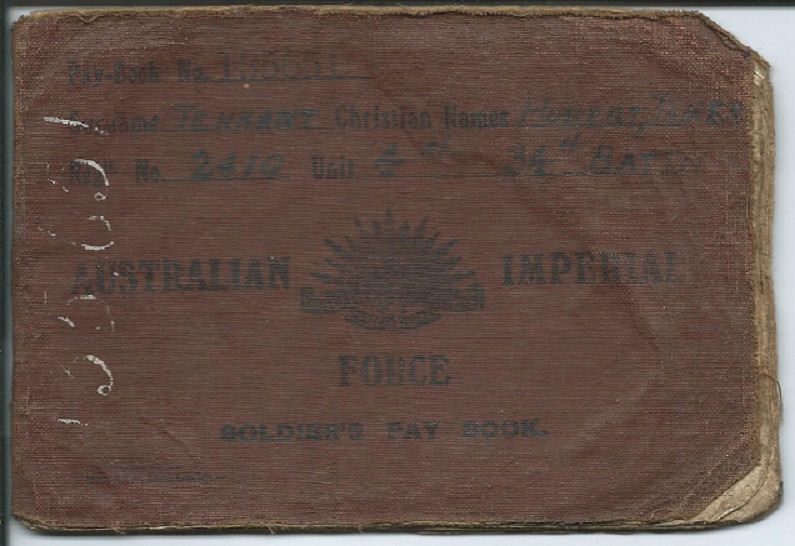

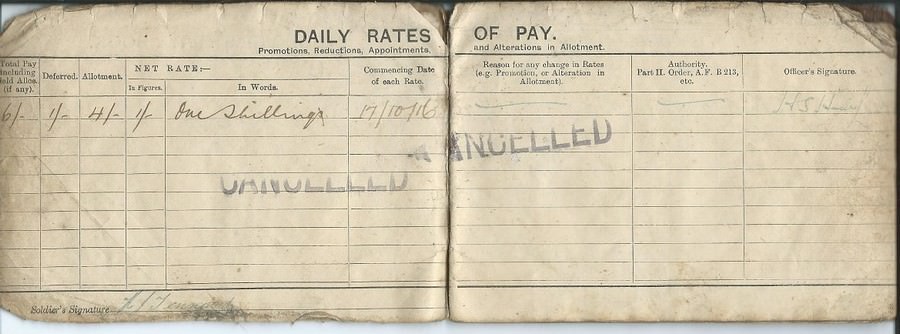
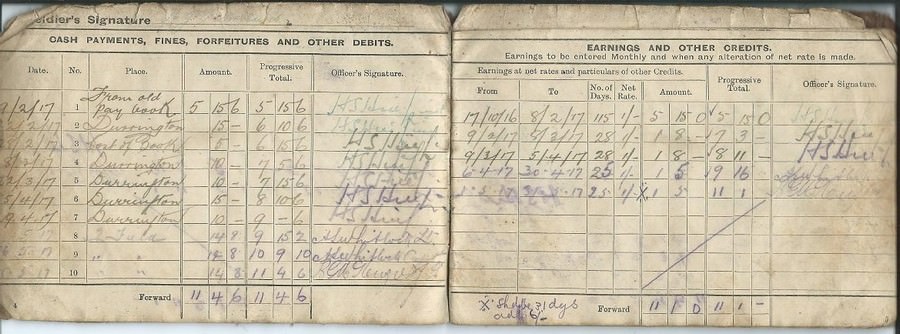
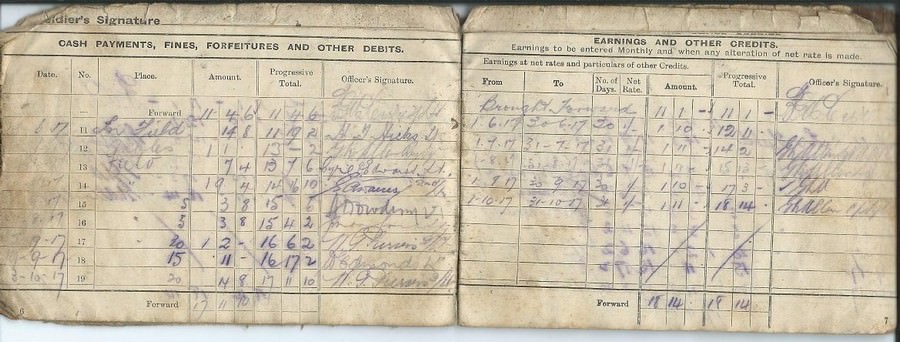
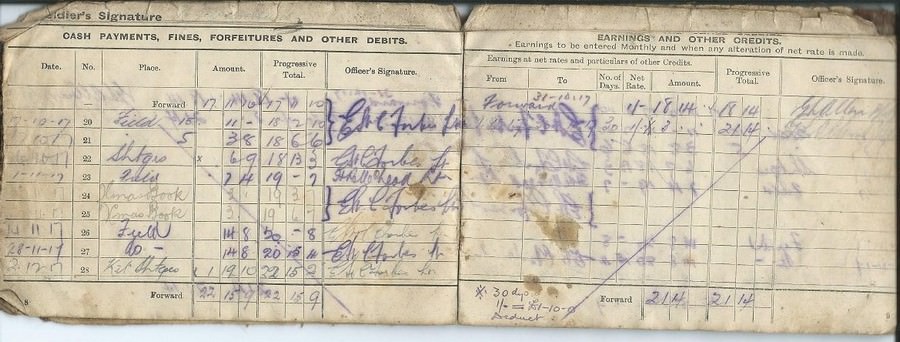
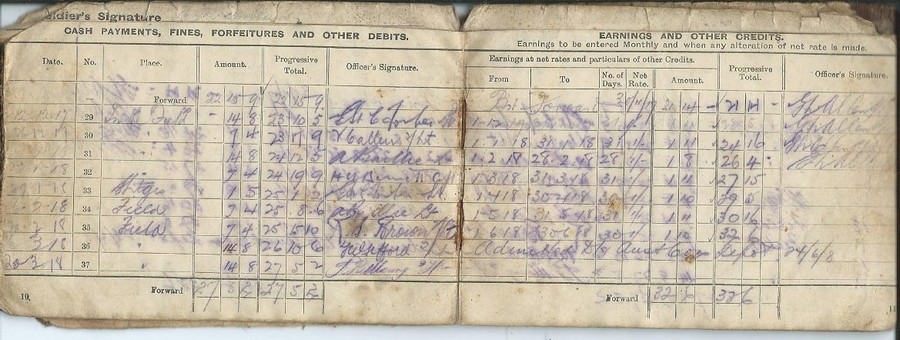
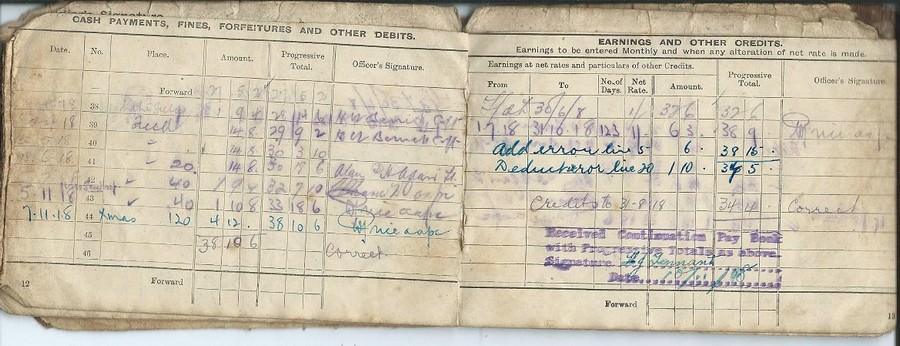
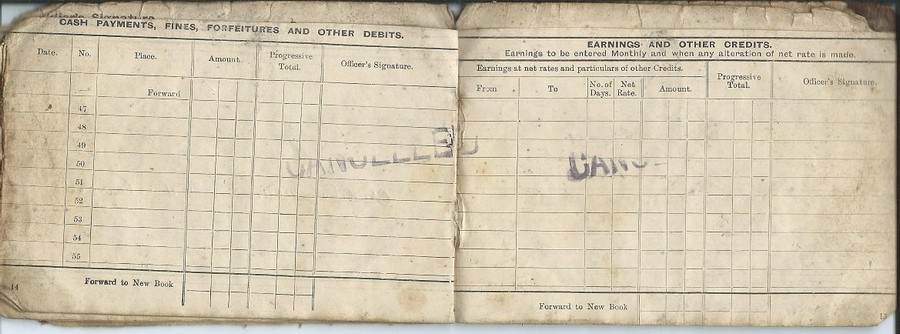
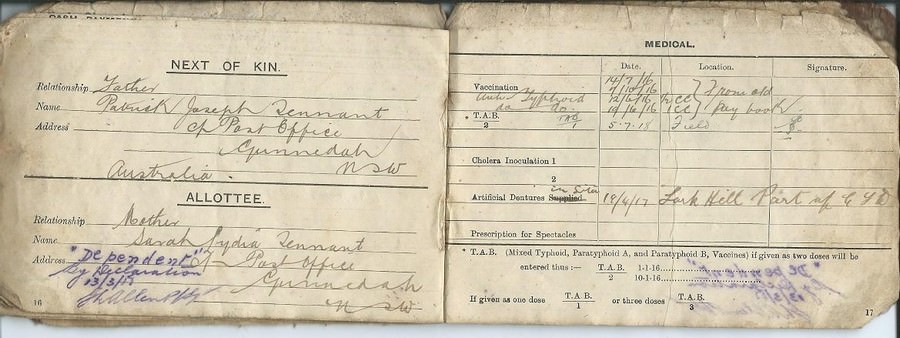
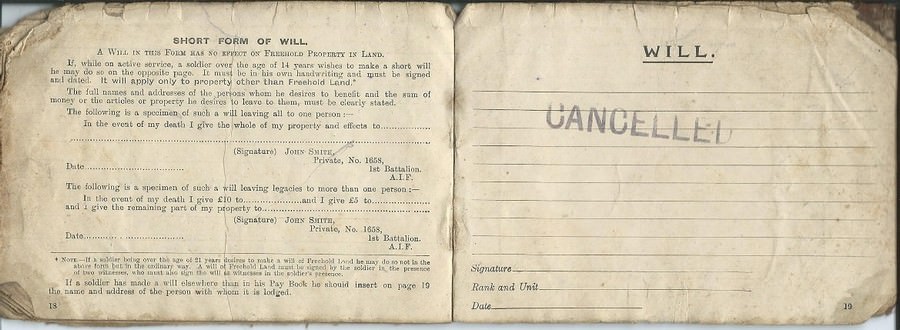

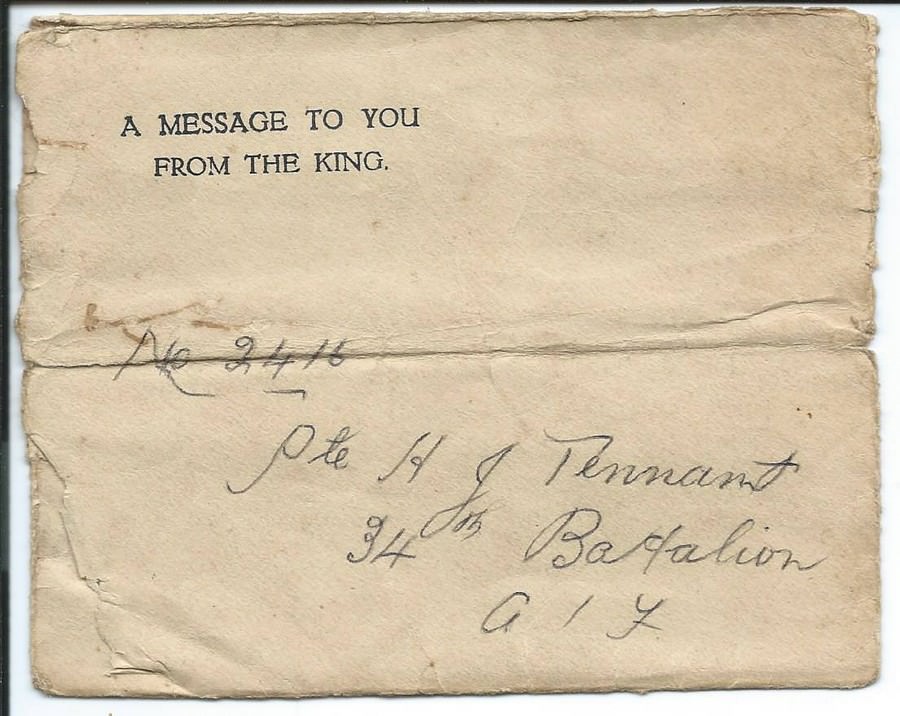

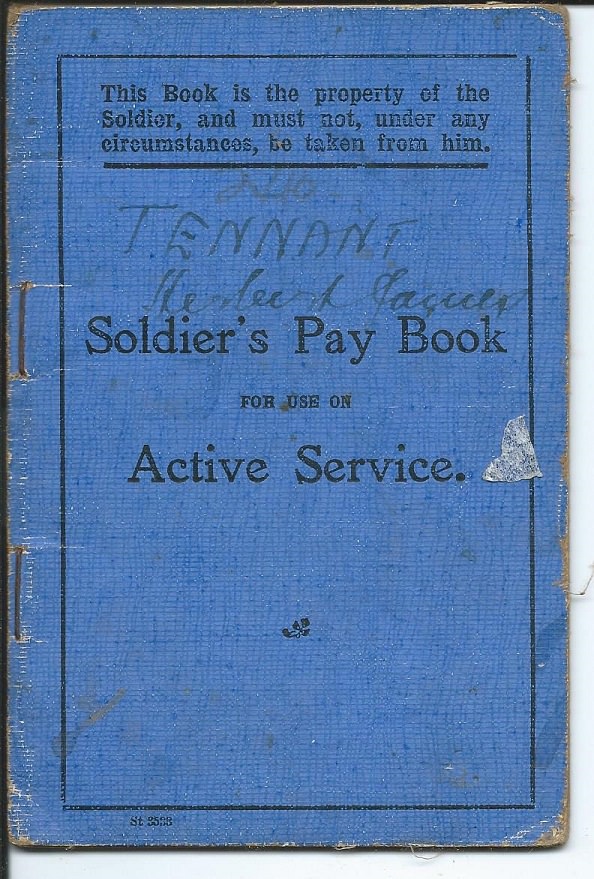


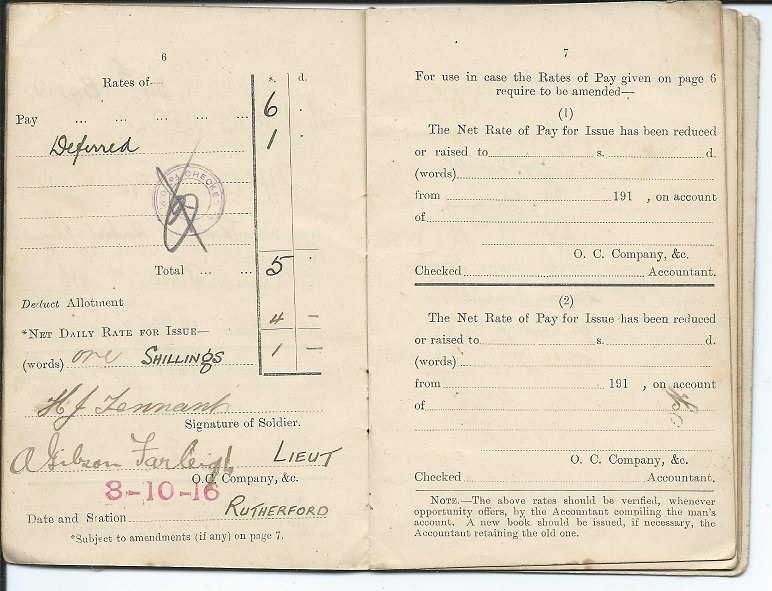
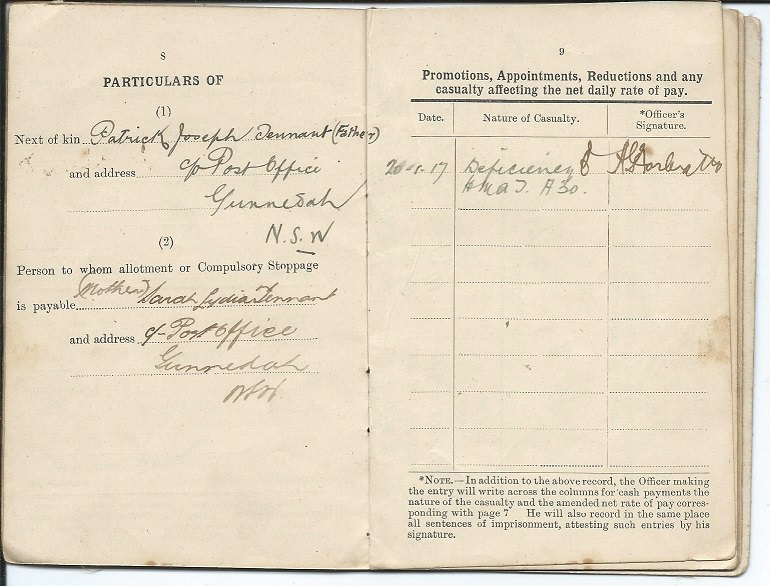
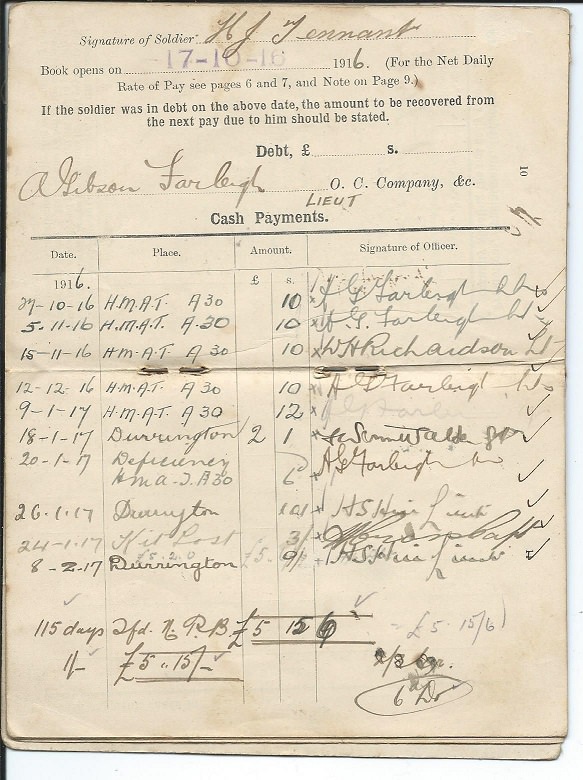
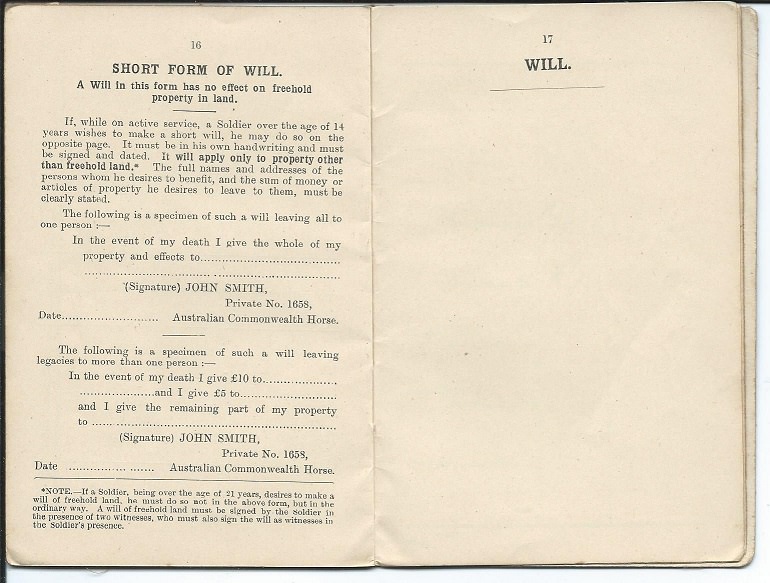
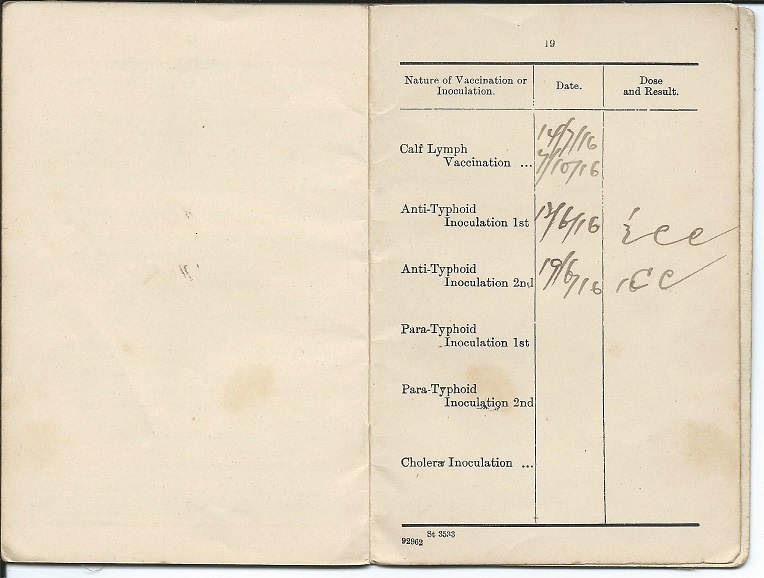
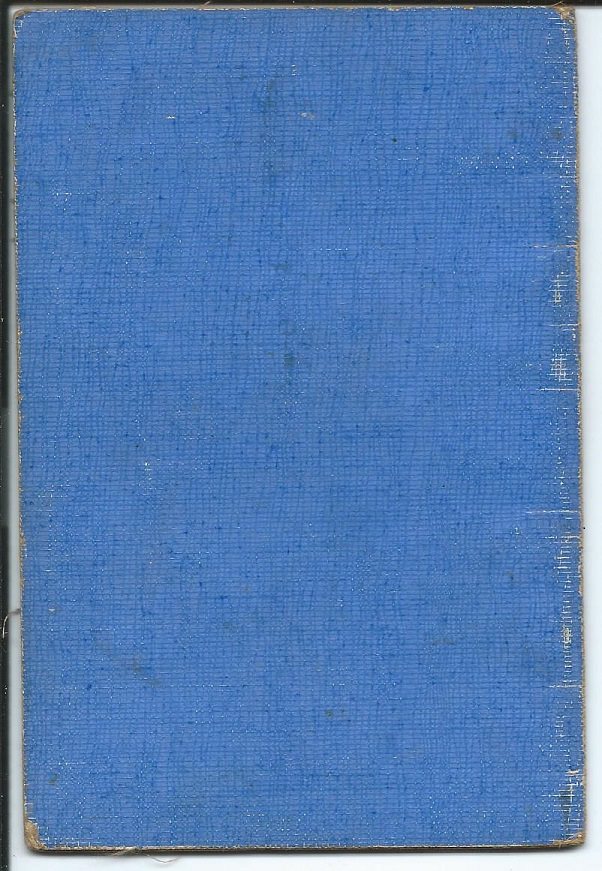
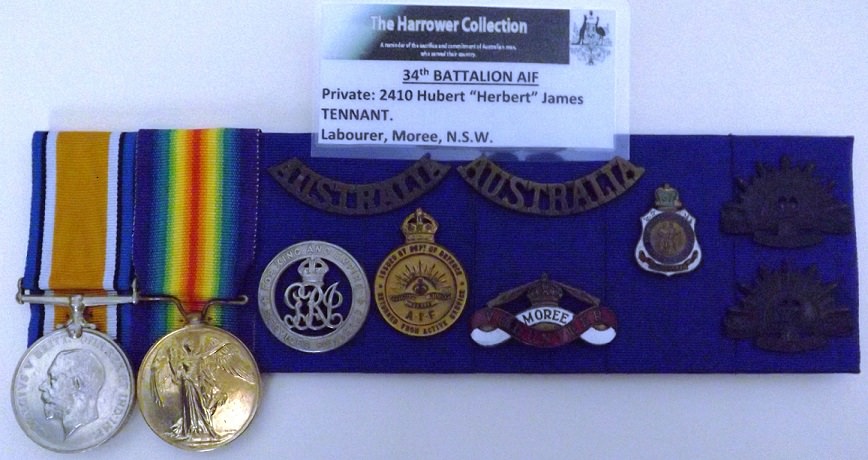 This entire collection was purchased from the lindsay Mears Collection in 2016 and is now in the Harrower Collection.
This entire collection was purchased from the lindsay Mears Collection in 2016 and is now in the Harrower Collection.

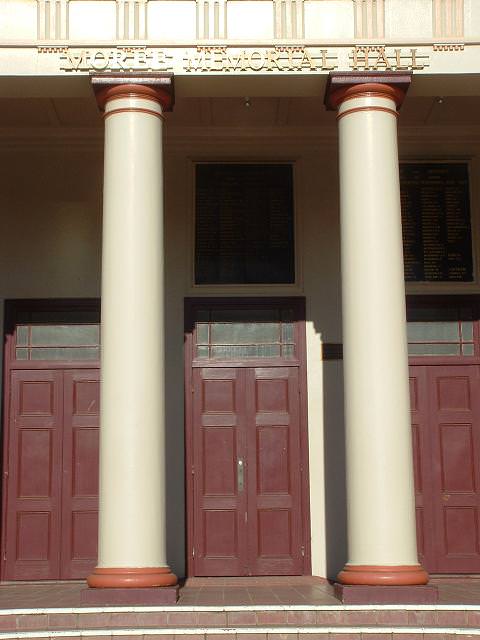
MOREE WAR MEMORIAL
Family Information
Hubert was a single 18 year old Labourer from Moree, N.S.W. upon enlistment. His parents Patrick Joseph and Sarah Lydia Tennant were married in 1894 at Boggabri, N.S.W. Marriage Cert: 2567/1894. Alma Tennant born 1895 at Boggabri, N.S.W. Birth Cert:30664/1895. Hubert James Tennant born 1897 at Gunnedah, N.S.W. Birth Cert:22168/1897 and died 1967 at Newcastle, N.S.W. Death Cert:22580/1967. Catherine A Tennant born 1899 at Narrabri, N.S.W. birth Cert:23186/1899. John Patrick Tennant born 1901 at Boggabri, N.S.W and died 1959 at Wallsend, N.S.W. Death Cert:12201/1959. Keith W Tennant born 1902 at Gunnedah, N.S.W. Birth Cert:32076/1902. Theresa M Tennant born 1904 at Gunnedah, N.S.W. Birth Cert:12691/1904. Arthur J Tennant born 1907 at Gunnedah, N.S.W. Birth Cert:13786/1907. Harvey Francis Tennant born 1912 at Gunnedah, N.S.W. Birth Cert:4798/1912 and died 1977 N.S.W. Death Cert:10787/1977. Phyllis P Tennant born 1913 at Gunnedah, N.S.W. Birth Cert:16311/1913.Thomas Tennant died 1968 at Newcastle, N.S.W. Death Cert:43292/1968. Keith William Tennant died 1903 at Gunnedah, N.S.W. Death Cert:1890/1903. Edna C.M. Tennant died 1910 at West Wallsend, N.S.W. Death Cert:2118/1910. Patrick William Tennant died 1984 N.S.W. Death Cert:101350/1984.
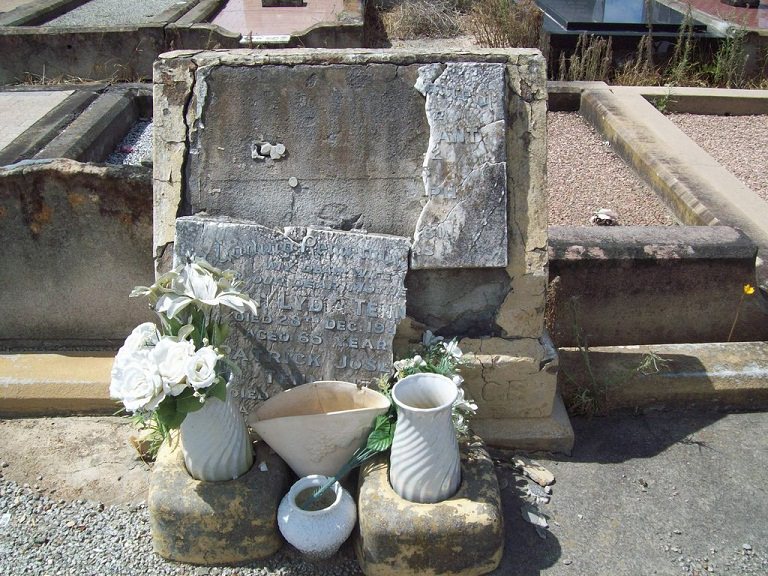 Patrick Joseph Tennant was buried at Sandgate Cemetery on the 13th September 1961, Catholic Section 63, Lot: 88 with his wife Sarah Lydia Tennant who was buried on the 29th December 1942.
Patrick Joseph Tennant was buried at Sandgate Cemetery on the 13th September 1961, Catholic Section 63, Lot: 88 with his wife Sarah Lydia Tennant who was buried on the 29th December 1942.
Military Records

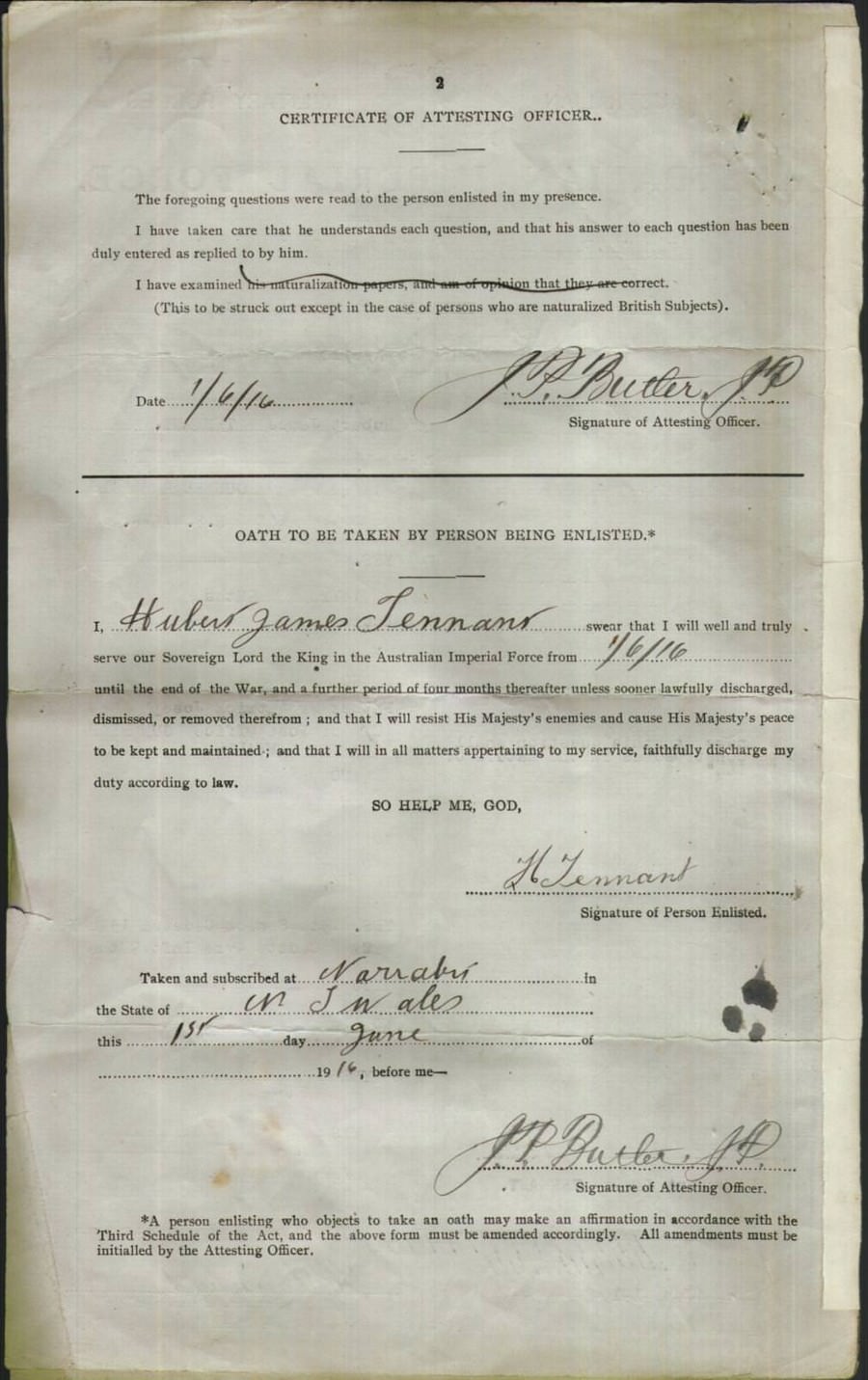

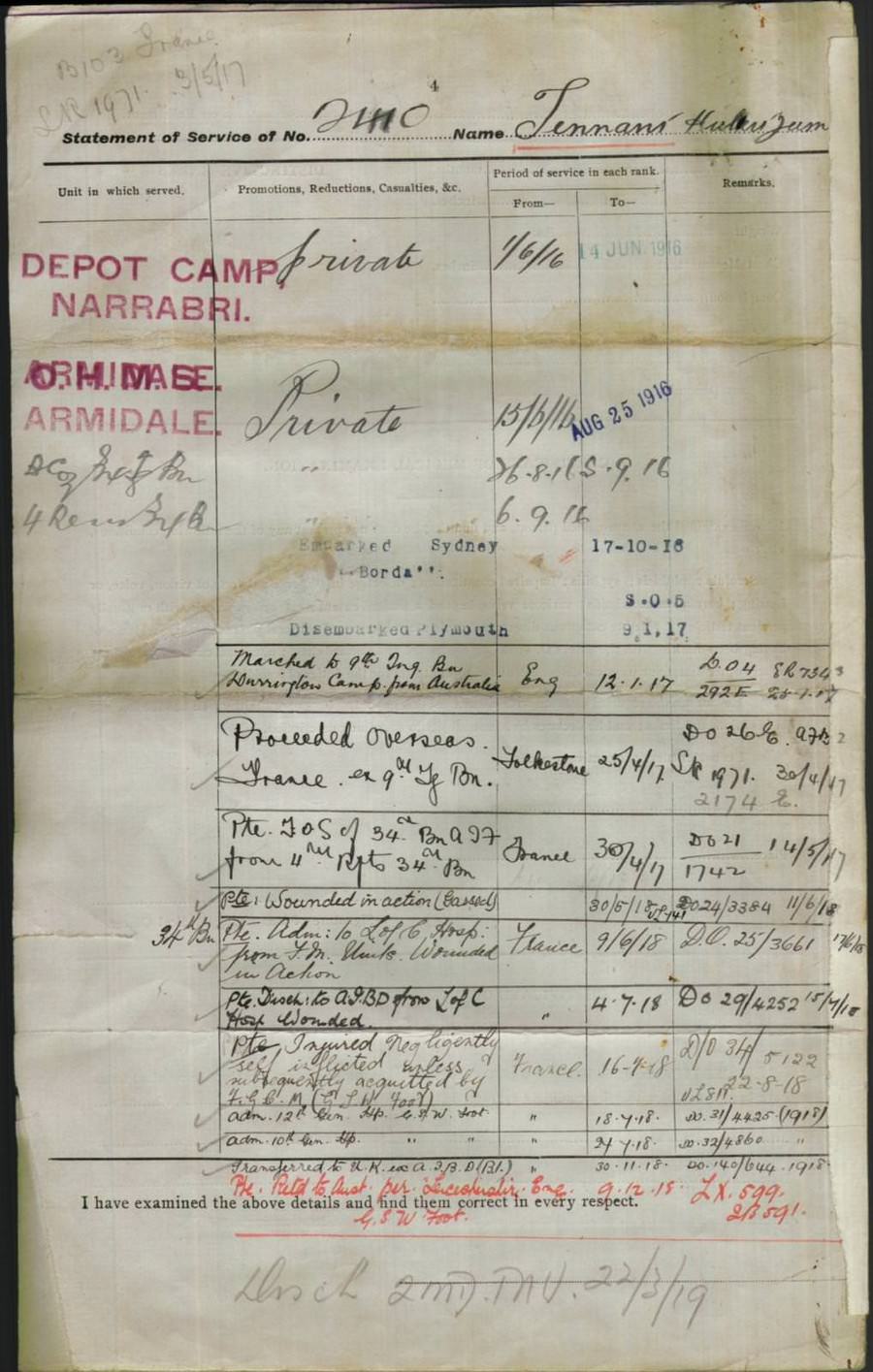
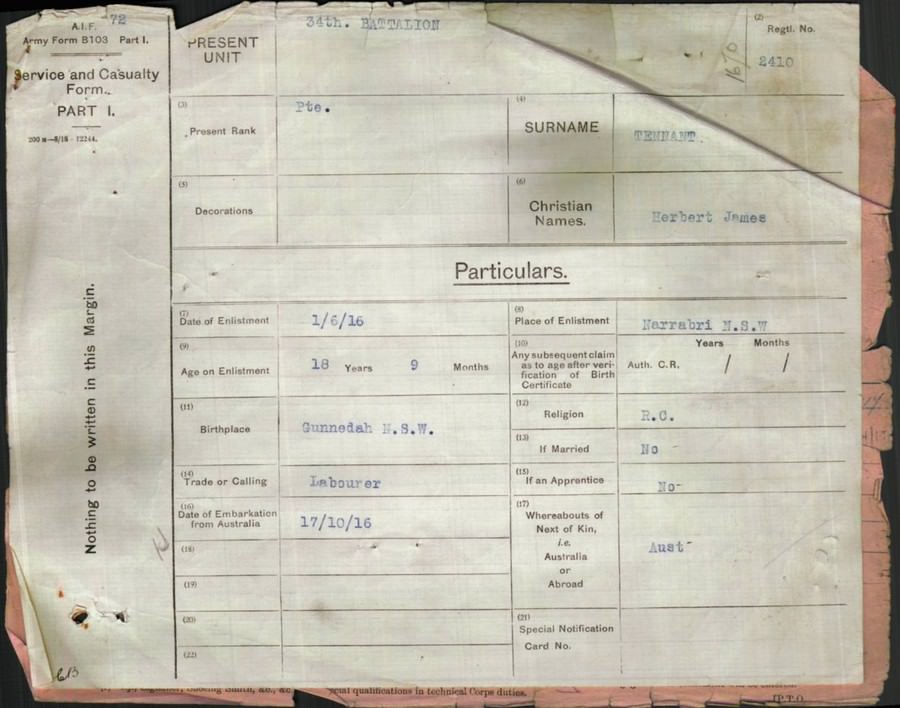
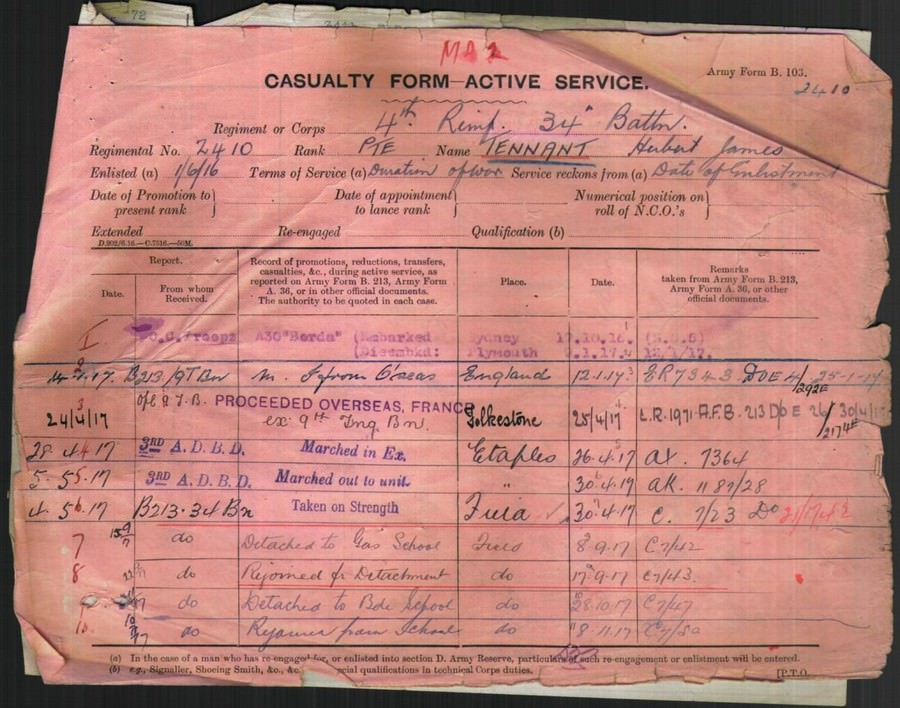
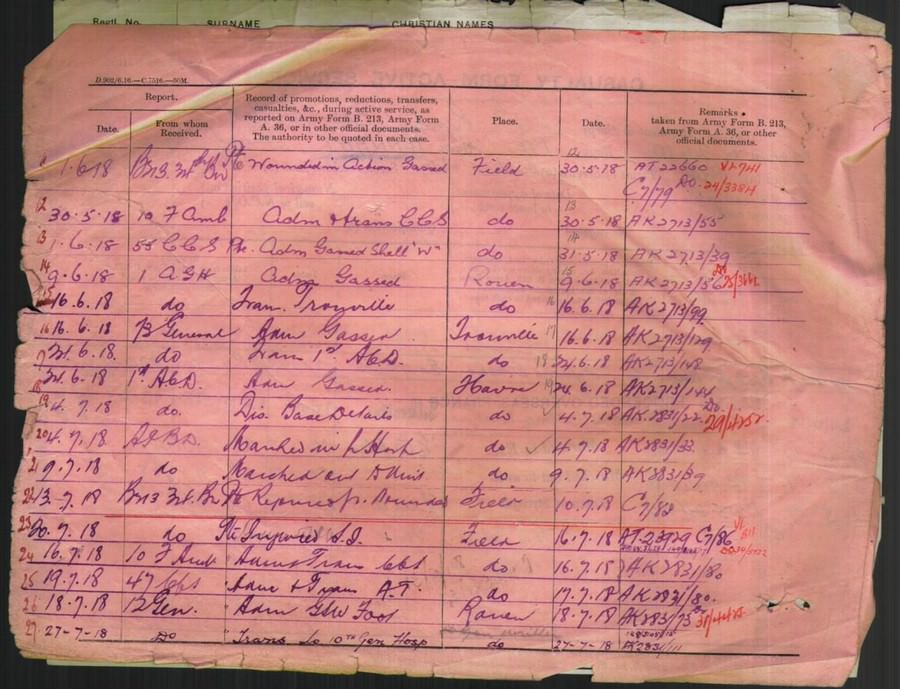

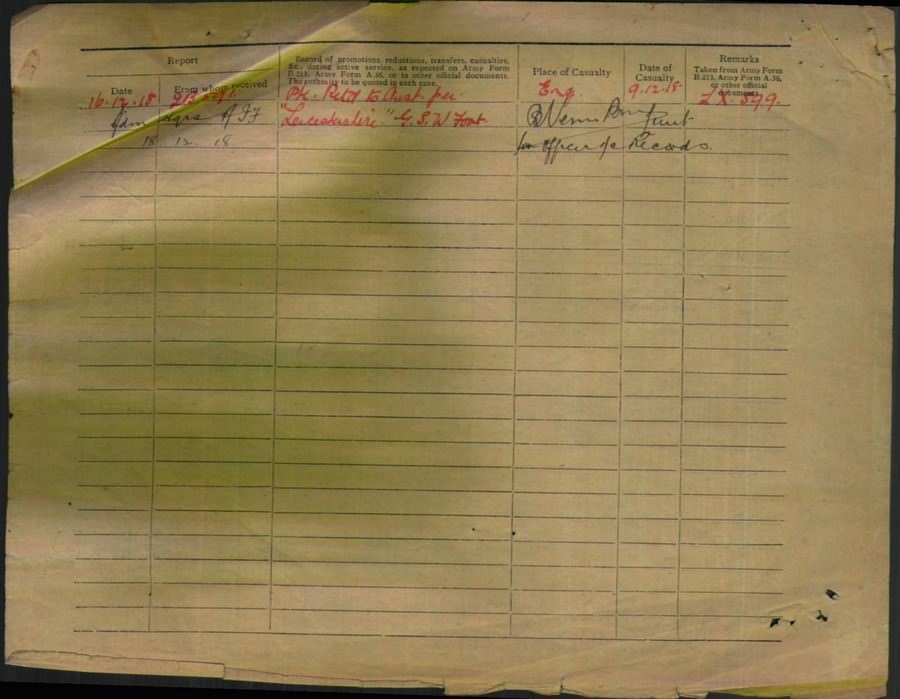
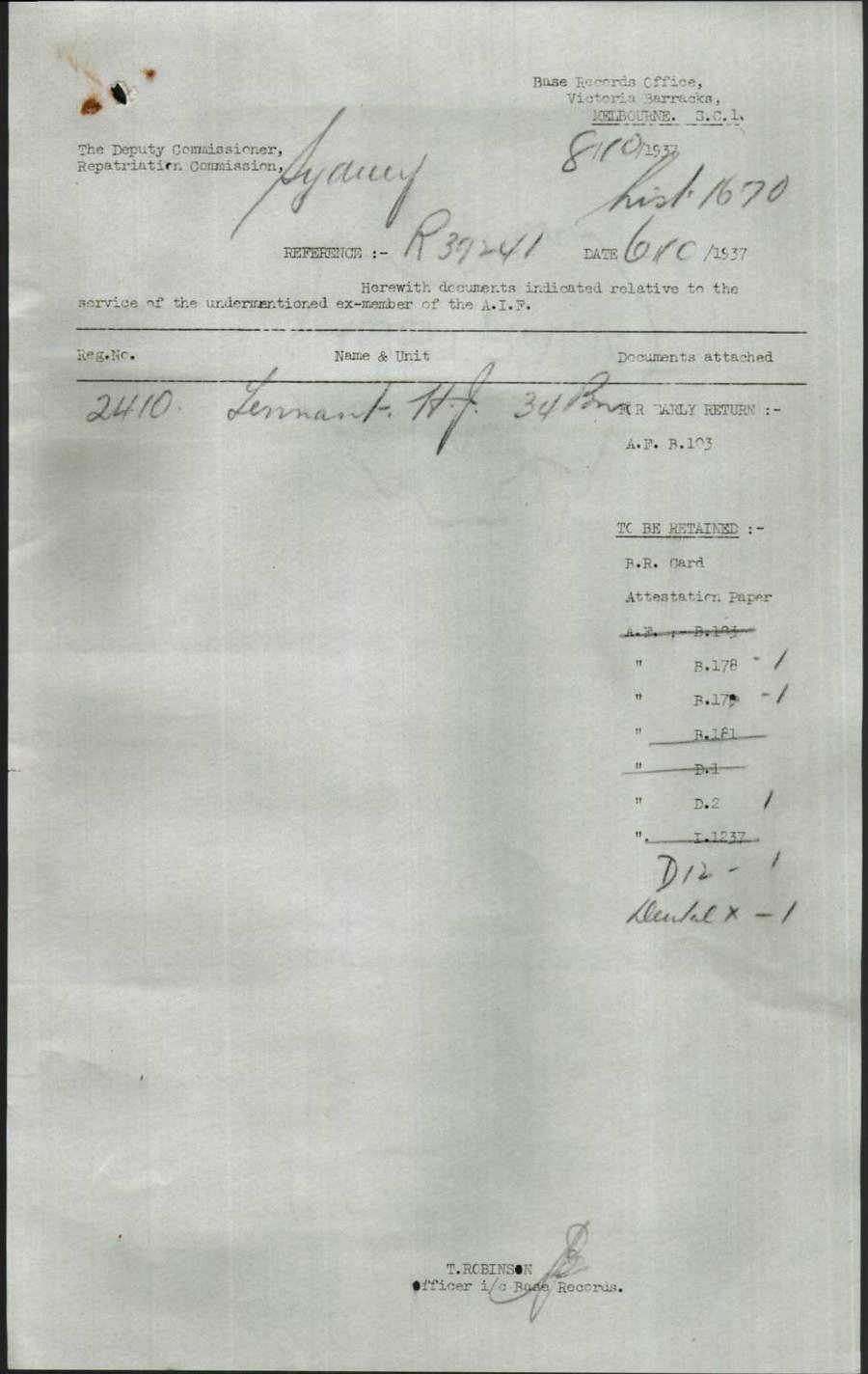
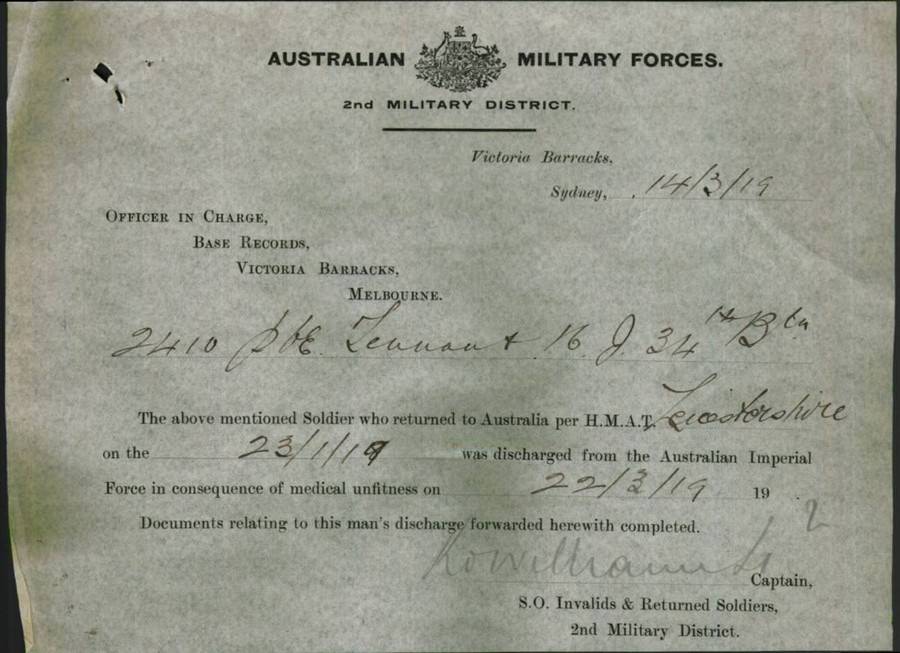

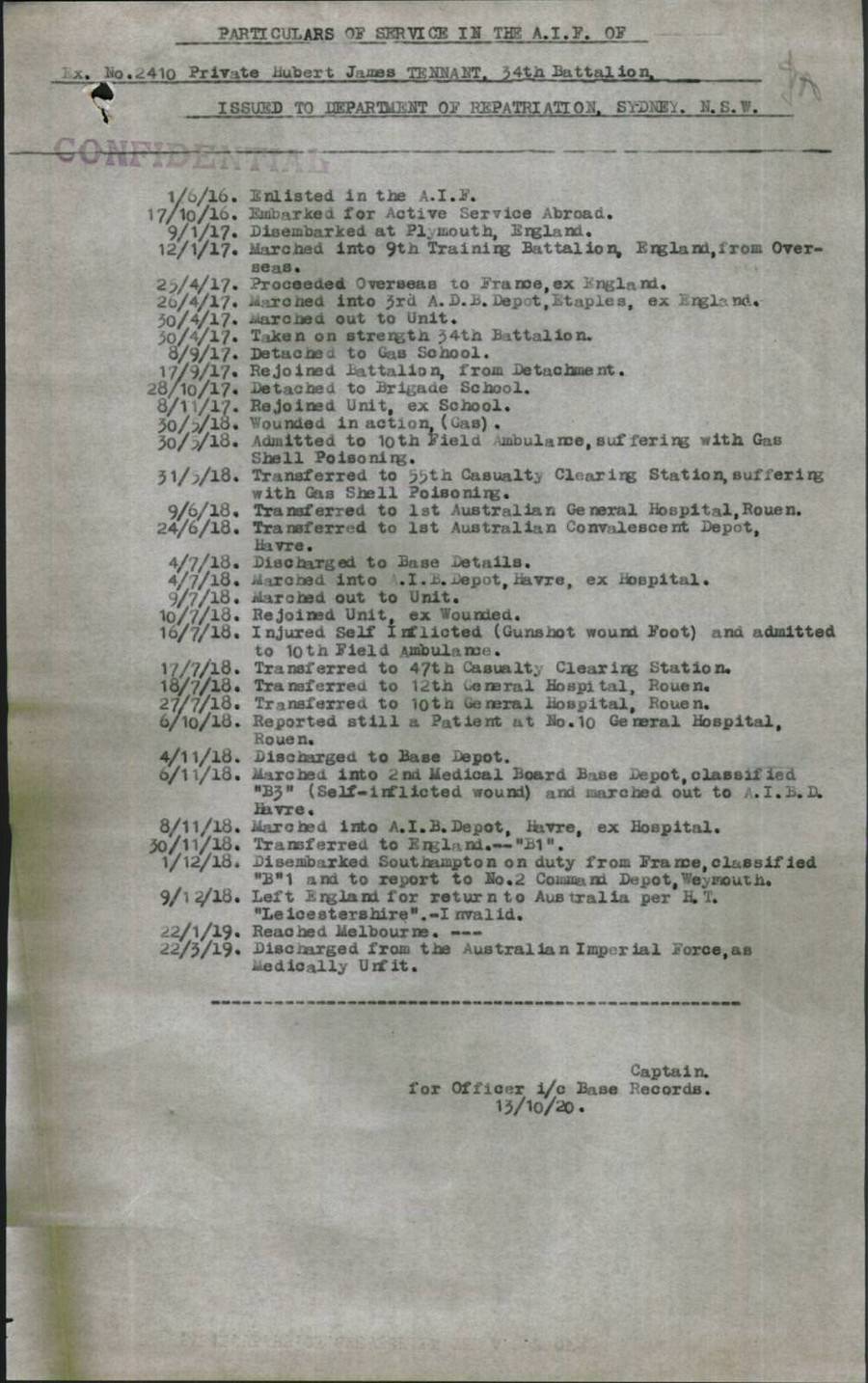

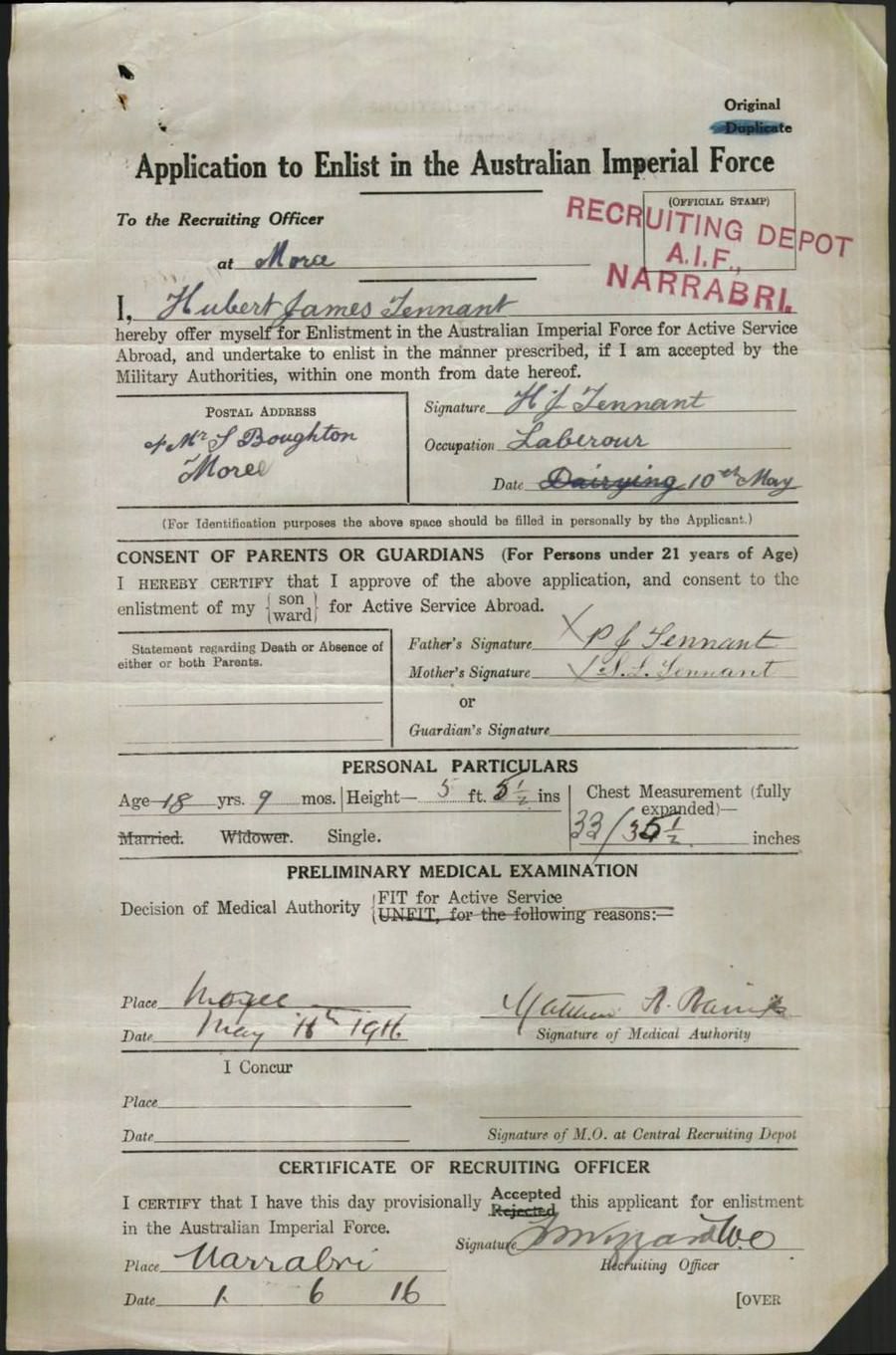
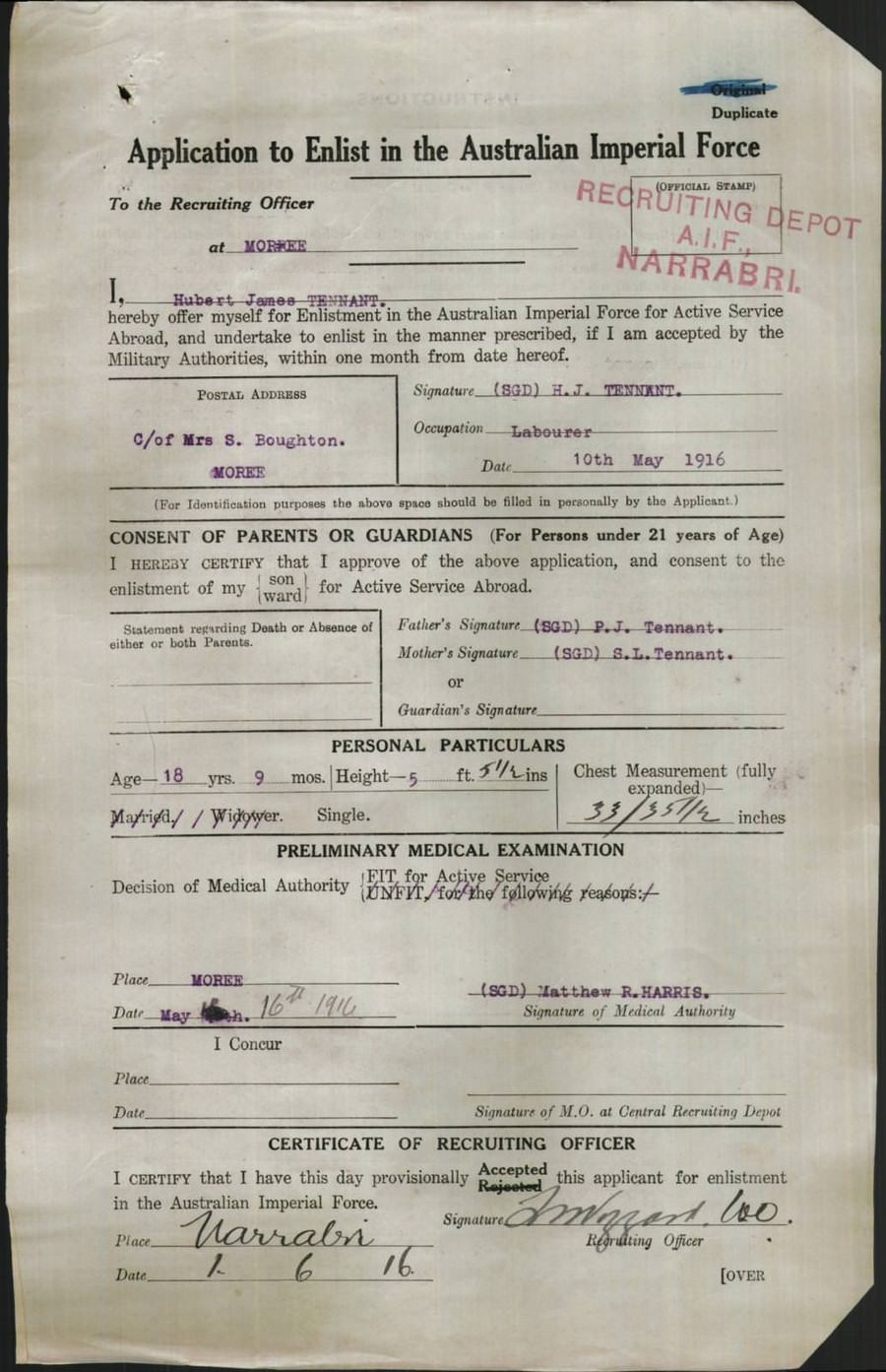
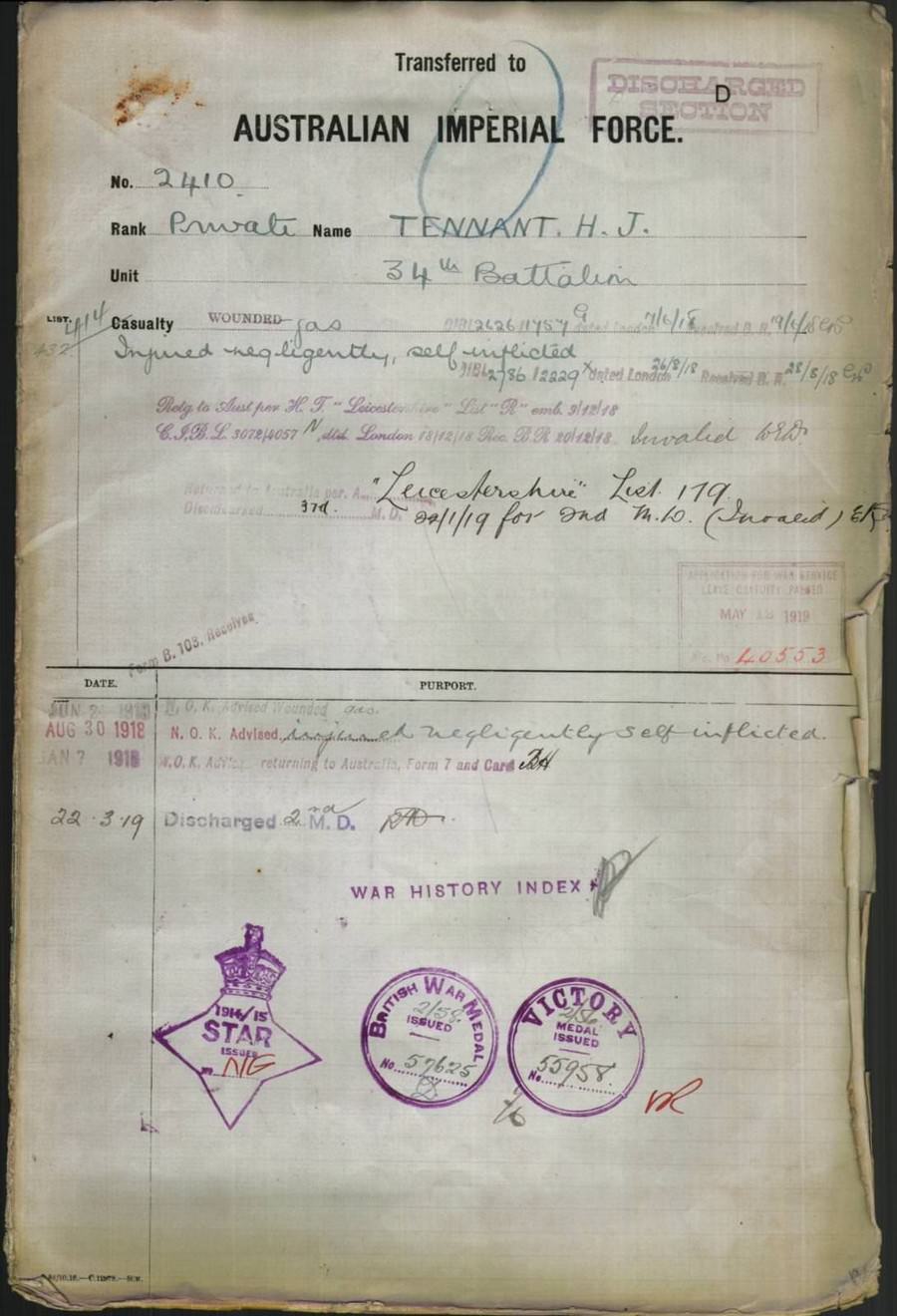
© Commonwealth of Australia (National Archives of Australia)
Under Construction; 01/09/2016-23/10/2023.
